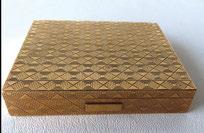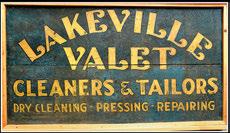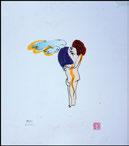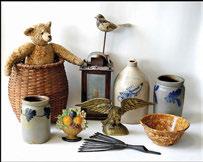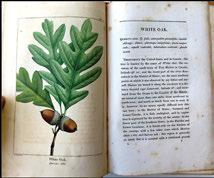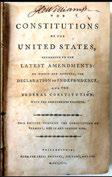Published by The Bee Publishing Company, Newtown, Connecticut
September 13, 2024
INDEXES


Published by The Bee Publishing Company, Newtown, Connecticut
September 13, 2024
INDEXES

Q&A: Declan Kiely
Decorative Arts A Draw In Merrill's Americana & Fine Arts Auction
Derin Bray Achieves Growth & Mainstream Exposure With Fringe, Tattoo & Curiosities
For The Love Of The Craft—
Bedminster Traditional Artisan Show Brings Increased Crowd At New Location
Native American Tomahawks & Other Antique Arms Excel At Charles Street
Barridoff Hosts Summer Auction, Fine Art Favorites On The Lawn
The American Folk Art Museum Is Shaking Things Up With 'Anything But Simple' Native Arts Collectors Gather For Santa Fe Art Auction
Large Furniture & Other Decorative Arts Drive Schultz's Success Book Reviews

September
November
December
February

Invites you to join us for our
Sunday, Sept. 22nd at 10:30am EST
Preview: Monday, September 16 – Saturday, September 21, 10am–4pm; Sunday, 8am until sale; or by appointment 9931 Rt. 32, Freehold, NY 12431

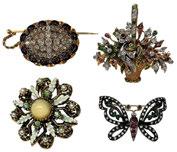





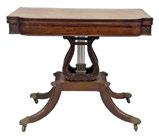


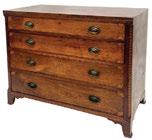






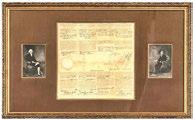





This auction includes important fine art from the Swyer Family Collection, the lifelong Collection of Theo Lovell & the Albany home of Fred Dicker. Included will be works by Jervis McEntee, Walter Launt Palmer, Emile Gruppe, Francis Silva, Jennes Cortez, Chas. W. Eaton, Anthony Thieme, Julie Hart Beers, Britcher, W.R.Tyler, Forrest Moses, F.J. Waugh, Jane Peterson, W.C. Van Zandt, William Wendt, Will Low, etc. Ceramic collection, Oriental
Sterling Silver, Period Furniture, Clocks & Accessories.
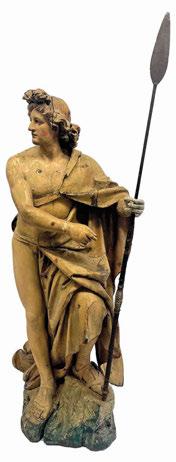
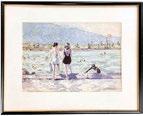





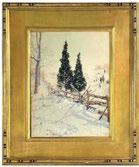
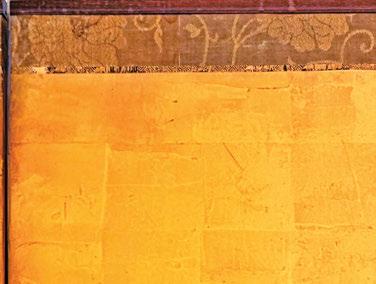























































SEP 19 American Art
SEP 26 The New York Sale
OCT 3 African American Art
OCT 10 Rare & Important Travel Posters
OCT 17 Old Master Through Modern Prints
OCT 24 Fine Books
OCT 31 Fine Photographs











NOV 12 Modern & Post War Art
NOV 14 Autographs
NOV 21 Printed & Manuscript Americana
NOV 26 Contemporary Art
DEC 10 Maps & Atlases, Natural History & Color Plate Books
DEC 12 Illustration Art
DEC 17 Fine Photographs
Registered Historic Landmark 1838 Home, The Robert (92) & Ruth (93) Uhlig Family
Sunday, September 22, 2024, 10am • Preview 8am to 10am at The Cottonwood Farm (1838) • 27658 Dablon Point Rd, Cape Vincent, NY 13618
1000 Islands Historic Real Estate sells at 11am • Preview to be announced (400 feet on Wilson’s Bay, 2 homes + 50 acres) LiveAuctioneers.com Online bidding beginning at 12noon. For extensive antique photos & descriptions, visit LiveAuctioneers.com
A NOTE TO OUR BUYERS:
Only once in a lifetime such an opportunity comes along with a registered historic beautiful waterfront, secluded property in Cape Vincent in the 1000 Islands of NY State. This well-known family collected 18th- to 20th-century antiques for over 60+ years and lovingly cherishes this historic property. Robert Uhlig was the first principal of the 1000 Island High School, and Ruth was a teacher there. Ruth is also a noted local accomplished artist. Please take a moment of your precious time to attend this exceptional lifetime collection of antiques and arts being sold to the highest bidder. Rare museum unreserved antiques auction.
The legal counsel to Nelson Rockefeller, Governor of NY and owner of Deerlick Farm, owned a great portion of the elite antiques and art that were purchased by the Uhlig Family.
The terms and conditions of the real estate portion of this auction will be handled exclusively by Mel Manasse & Son: Matt, (607) 692-4540, http://manasseauctions.com. Personal property handled by Alex Lyon & Son. Please contact them with all questions concerning the real estate portion of this auction.
All antiques auction-related questions, please contact Iroquois Auctions Gerald Petro, Auctioneer & Appraiser • (315) 561-9777 or (315) 657-1018
























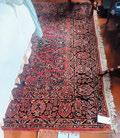






Previews: Wednesday 4th - Saturday 7th 10am-3pm & Sunday 8th 8-10am or in advance by appointment.
Join us for this sale of 550 lots, beginning with 200 lots of jewelry and fine silver, including a large collection of early American and Georgian silver. In addition to fine arts and antiques, the sale will feature a wide selection of historical signed documents and rare and signed books. Catalog online, bid at our website, in person at the gallery, or at liveauctioneers nvaluable i
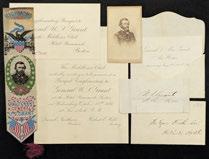
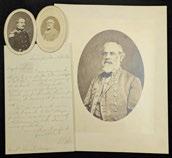








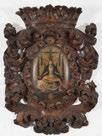

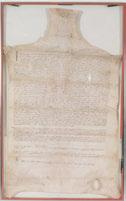


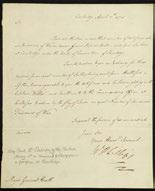


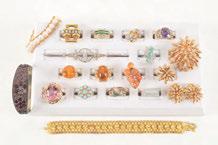






Declan Kiely, the Grolier Club’s newly appointed executive director, has more than 20 years of experience working at renowned research libraries, including The New York Public Library and the Morgan Library & Museum. Antiques and The Arts Weekly caught up with him to congratulate him on the new position.
Photo: Horacio Salinas Photography Inc.
Congratulations on becoming the director of the Grolier Club! Would you share a little about what called you to this position?
I was invited to become a member of the Grolier Club four years after emigrating to the United States. At that time, I was still researching and writing my doctoral dissertation. I felt immediately welcomed and at home at the Grolier Club. Because the Grolier Club draws together an international fellowship of bibliophiles and enthusiasts in the graphic arts as well as librarians, curators and library directors, I gained access to a wealth of knowledge and experience. The Grolier Club was part of the luck I had. My conversations with fellow members not only shaped me as a scholar but also informed my career decisions, setting me on a path that led to curatorial work in libraries and special collections rather than academia. Having discovered a vocation within the Republic of Books, I feel that the role of executive director of the Grolier Club is a natural progression for me. I stepped into the role at a very exciting moment in the club’s long history, and I am thrilled to be granted this opportunity to maintain and enhance the Club’s leadership position in the bibliophilic community and beyond.
In the announcement of your position, Nancy Boehm, Grolier Club president, said you “know the Club on a personal level.” Could you share some of your experience with the Grolier Club?
A couple of years into my membership, I submitted an essay to the Gazette of

the Grolier Club on bibliographic research into some early unrecorded poetry reviews by Graham Greene. Encouraged by its positive reception among members, I deepened my involvement by serving as assistant editor of the Gazette and also
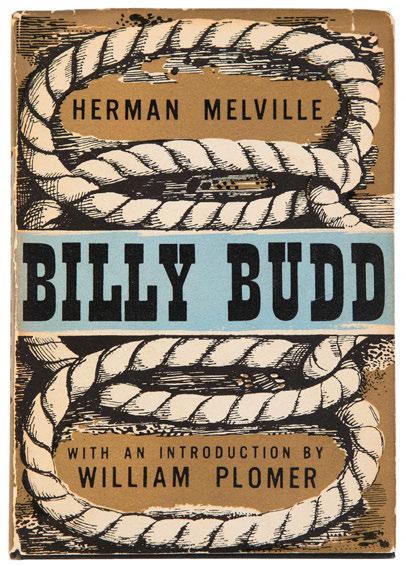
joined the Committee on Publications. Of course, being a collector was the foundation of my connection with club members, then and now. I come to the role of director with years of experience as a member and that will inform my thinking about what members want and expect. What makes the Grolier Club such a special organization is its conviviality, collegiality and the way in which its members share their collecting passions. It is an organization in which people form deep and lasting friendships in pursuit of lifelong learning. The Club’s exhibitions and publications, along with its eclectic range of programs generate considerable intellectual excitement. This may make it all sound a little bit earnest, but it’s actually a great deal of fun. When my twin sons were little, they would amusingly refer to the Club as the “Grolier Gang.” In recent years, I have served as the editor of the Gazette, and also as a member of Council, since 2018. Over time, I deepened my engagement with and participation in Club life — and Club life is something that we take particularly seriously.
Your background includes more than two decades working at organizations such as The New York Public Library and the Morgan Library & Museum. What are some past projects and experiences that you are most proud of?
It has been my great good fortune in life to work with extremely talented and dedicated colleagues. This has never been truer than during my experience so far at the Grolier Club. I tend to be a person
( continued on page 6 )
( continued from page 1 )
who looks forward rather than back, but since you ask, I am proud of the exhibitions that I curated or co-curated and the wide network of relationships I was able to cultivate during my tenure at the Morgan Library & Museum. An especial pleasure was the opportunity to meet the direct descendants of Nobel Prize winning authors, as well as collaborating with eminent scholars and writers, and occasionally with movie directors and actors. I particularly enjoyed the process of making short films and recording audio guides for exhibitions. In recent years, my return to the New York Public Library in 2017 presented me with the opportunity to continue to build its extraordinary archival collections and inaugurate the library’s first permanent exhibition of its treasures, now in its fourth year.
And how have those positions helped you prepare for this next step as director of the Grolier Club?
The executive director of the Grolier Club is a multifaceted position. Because the Club’s mission encompasses a research library focused on bibliophily, bibliography, the history of printing, binding, illustration, the book trade, as well as a robust exhibition program allied closely with its many and varied publications and programs, the role draws broadly on my experience in each of these areas. Over the course of my career, incrementally increased supervisory responsibility has allowed me to serve in leadership roles in research libraries, special collections and exhibition programs. Consequently, I have extensive experience in the conception and development of a wide range of strategic initiatives. In addition to strategic planning and implementation, my roles have encompassed change management, disciplined financial stewardship, governance and board relations, fundraising and donor cultivation, public engagement and outreach, and programmatic and technological innovation. My new role will touch on all these areas as we lead this illustrious institution toward its sesquicentennial in 2034.
As the Grolier Club’s director, what does a typical day at work look like for you?
I have been in the role for only three weeks, and I’m not sure that there has been a “typical” day as I have been continually learning. We have a closeknit and dedicated staff and Council, and I would say that on any given day I speak with every one of my colleagues, either in regularly scheduled meetings or on an ad hoc basis as we work on the myriad internal and outward-facing initiatives. In August, our clubhouse is closed to members and the public as we work on preparations for the upcoming autumn season of exhibitions and programs, so I have had fewer evening activities to attend to in my first weeks. Post-pandemic,

the Club has successfully leveraged its programs to extend its national and global reach, engaging members and reaching new audiences in unprecedented ways. The Club recently launched a virtual common room — a Zoom meeting room that is available continuously, seven days a week, 24 hours a day, for any members to join and enjoy bookish conversation. So far, the Virtual Common Room is now being used on a regular basis for the virtual happy hours, monthly Collectors Showcases, monthly New England Members Gatherings. This past week we held our first Virtual Common Room poetry evening, which was well-attended and delightful.
What kinds of exhibitions and programs are you most looking forward to working on in this new role?
The Club’s exhibition program — we install three shows in the main hall and four in the member’s gallery per year — is scheduled through to the end of 2027. I am looking forward to working with the curators of our upcoming exhibitions to ensure broad appeal and deepen public engagement. I am especially excited about the forthcoming exhibition, drawn from the Americana collection of David M. Rubinstein, focusing on how books shaped Abraham Lincoln’s mind and political philosophy and the books, documents and ephemera that empowered Lincoln’s political ascendance. This year also marks the centennial of the first publication of Herman Melville’s Billy Budd, Sailor. We will be celebrating this anniversary with a member’s exhibition organized by Will Johnston, and we are hosting a symposium featuring notable Melville scholars in October. At the end of the year an exhibition titled “Imaginary Books” will feature lost, unfinished or fictive works that are only found in other books which
Reid Byers, the curator, describes as “a bibliophilic entertainment and a post-structuralist conceptual art installation.” In the new year we will open an exhibition in the main hall on the timeless humor of Mark Twain, drawn from the collection of Susan Jaffe Tane, with exceptional loans from the New York Public Library.
As I mentioned earlier, I delight in the enthusiasm of Grolier members and the intellectual energy that ensues. I look forward to pairing my longstanding experience in exhibitions and public programing with the exciting ideas generated by our passionate staff and members — I am inspired to reinforce the Grolier Club’s visibility and relevance as an innovative and entrepreneurial cultural institution.
Looking ahead, do you have any short- or long-term goals for the Grolier Club that you would like to share?
I am excited to collaborate with the Council to plan and implement the strategic direction of the Club. These include some technology and development initiatives and, of course, growing the collection through gift-in-kind donations and acquisitions. I am seeking ways to continually improve every aspect of operating activities in pursuit of excellence. From a managerial perspective, I am responsible for mentoring staff at all levels and for staff development. One of my principal goals is to intensify and maintain staff engagement on our institutional priorities and inspire and unify colleagues. Although I have been a member of the Club for many years, I am excited to foster relationships with fellow members, build upon existing relationships and explore potential synergies with other constituents within the bibliophilic community.
—Carly Timpson
R. Scudder Smith, Founder (1963) Helen W. Smith
Sherri Smith Baggett Co-Publishers
Bee Publishing Company Newtown, Connecticut 06470
Periodicals Postage Paid at Newtown, Connecticut 06470
Madelia Hickman Ring, Editor W. A. Demers, Senior Editor Laura Beach, Editor At Large Kiersten Busch, Assistant Editor Carly Timpson Assistant Editor Rick Russack, Contributing Editor Cindie Gannon, Advertising Manager 203-426-8036 (antiques advertising only) or 203-426-3141 (subscription and other information) or Fax. 203-426-1394 email (advertising) - ads@thebee.com email (subscriptions) - subscriptions@thebee.com email (editorial) - antiques@thebee.com
ADVERTISING RATES
Display: $19 per column inch
Auction: $25.20 per column inch
(Early) Auction: $22.50 per column inch for ads received prior to 10 am Thursday, for the next issue. Payment must accompany ad unless credit has been established DEADLINES:
All display advertising and editorial material must be received by Friday at 10 am; Auctions by Monday at 10 am (except Early Auctions - see above) for the issue dated the following Friday.
PAGE LOCATION MAY BE REQUESTED AND WILL BE FOLLOWED IF POSSIBLE
ADVERTISING POLICY
Antiques and The Arts Weekly reserves the right to refuse any advertisement submitted for publication. Further, it cannot guarantee the quality of services advertised in its pages, nor the unquestionable authenticity of objects advertised and it cannot accept any responsibility for misunderstandings that may arise from the sale or purchase of services or objects advertised in its pages. Advertising position is not guaranteed - will be honored, if possible.
POSTMASTER: Send address changes to THE BEE PUBLISHING CO, 5 Church Hill Road, Newtown, CT 06470-5503
SUBSCRIPTION
Other Rates Available, Please Call 203-426-8036 or subscribe
EFFECTIVE March 1, 2023












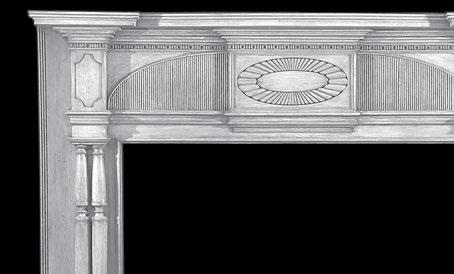







Late Eighteenth Century George III mahogany bureau Regency inlaid desk and bookcase that seems to reach for the sky and is finely proportioned.
Circa 1800-20 Federal inlaid mahogany concave chest from central Virginia, possibly Richmond, a scarce piece of American craftsmanship ($15/30,000).
BLOOMFIELD, N.J. — Nye & Company Auctioneers will conduct a three-day Country House Splendor auction from Sunday to Tuesday, September 11-13, starting at 10 am Eastern time on all three days. The auction will include approximately 1,000 lots of fine and decorative arts from the Seventeenth Century up to modern day, headlined by items from the estate of Barbara Mallory Hathaway.
Barbara M. (“Bunny”) Hathaway was a World War II veteran and philanthropist known for her green thumb. She passed away in May 2023 at age 101. “Bunny” was born in 1921 and raised in Greenwich, Conn., and New York City. She was the daughter of Clifford Day Mallory, president and chief executive officer of the Mallory Line, a family shipping concern that was established in 1816.
Hathaway lived in the same house for more than 70 years. Many of the pieces included in the sale were originally from her parents’ apartment in New York City, as well as the William Bottomley designed estate of her great aunt in Maryland. The collection features objects one might expect to see decorating the interior of a classic country home, whether English or American. Highlights include a Regency inlaid desk-and-bookcase that seems to reach for the sky and is finely proportioned. The “smalls” are abundant and rich in design and flair. There are numerous Staffordshire figures, some equestrian-

themed, silver, glass, porcelain and lighting. There is also a selection of garden ornamentation, including a figural fountain of a young boy with flute.
Bunny’s maternal grandfather was George Sealy, the Texas banker, merchant, cotton baron and owner/president of the Gulf, Colorado and Santa Fe Railroad. After being educated at boarding school in Virginia, she was named by Hearst Newspapers Syndicates as 1939’s Debutant of the Year. When the United States entered World War II, she moved to Washington, DC, where she was employed by the Office of Strategic Services (the precursor of the CIA) and was assigned to the Balkan Desk.
At war’s end she married Captain E. Phillips Hathaway, a decorated Marine aviator who had received three air
NEW YORK CITY — “What It Becomes” is an exhibition of new and rarely seen works from the Whitney’s collection that encourage us to think expansively about what drawing is and can be. Featuring the work of 11 artists, including Darrel Ellis, David Hammons, Ana Mendieta, Catherine Opie and Wendy Red Star, “What It Becomes” explores how artists have turned to drawing as a way to reveal the unseen and make the familiar unrecognizable. The exhibition takes its title from the words of artist Toyin Ojih Odutola, who, describing how the act of drawing transforms the source imagery she works from, remarks, “What it becomes is what I’m interested in.”
The processes and techniques inherent to drawing play a fun-


Vibrant and impressionistic oil on canvas painting titled “Road to my Farm” by George Loftus Noyes (Canadian, 1864-1954) ($15/30,000).
medals, including the Distinguished Flying Cross. They moved to the Greenspring Valley outside of Baltimore, Md., where they built a Frenchinspired house. Bunny proceeded to design and lay out extensive gardens.
The auction will also feature property from another private collection, primarily early American furniture from the mid-Eighteenth through the early Nineteenth Century. Highlights include a rare Federal inlaid mahogany concave chest from central Virginia, possibly Richmond ($15/30,000).
There is also an equally rare Federal carved cherrywood armchair from Mitchelsburg, Ky. This chair has been upholstered with a noninvasive covering pioneered by Colonial Williamsburg’s upholsterer Leroy Graves. This technology allows the seat covering to be easily removed and avoids tacking anything to the frame.
The collection also includes an early Queen Anne pair of balloon seat side chairs made in Philadelphia, 1750-1760, with a history of descending in the Mendenhall family ($15/30,000). There is also a
Lemuel Curtis girandole clock ($15/30,000).
Another complement to the furnishings category is a collection of silver, brass and Paktong candlesticks dating from the second-half of the Eighteenth Century. These well-crafted metalwork sources of light helped illuminate the homes and lives of generations past. Some are estimated as low as $500-$1,000.
Nye & Company continues to sell property from the NAMITS collection. This private collection was collected over decades and has a blend of Provincial French furniture, Native American pottery and contemporary fine art.
Highlights of the collection include a number of Pueblo pots from the turn of the Twentieth Century. These vessels are rich in decoration, history and use. Most are priced at $500-$1,500. There is a monumental French inlaid cherrywood enfilade that has tons of put-away space ($2,5/3,500).
For those who appreciate whimsy, craftsmanship and folk art, there is a small selection of canes being sold from the estate of Marjorie and
Robert L. Hirschhorn, passionate collectors of folk carved canes, parquetry and marquetry inlaid furniture. Real-time Internet bidding and absentee bidding will be provided by LiveAuctioneers, Invaluable, Bidsquare, BidSpirit and the Nye & Company website. Telephone bidding will also be available on a limited basis.
Nye will conduct a public exhibition September 3-6 from 10 am to 4 pm each day and then again September 9-12 from 10 am to 4 pm. Nye & Company Auctioneers is at 20 Beach Street. For information, 973-984-6900 or www. nyeandcompany.com.



damental role in the creation of the works presented here, whether they take shape on paper, in photography or through video. Some artists employ maneuvers like inscription and erasure to alter or reclaim existing images. Others emphasize the tactility of the medium by using their bodies as drawing tools or surfaces, transforming their likeness in the process. Harnessing drawing’s relationship to touch and its ability to convey change, the artists explore the malleable nature of identity and the possibility of shaping and redefining oneself.
“What It Becomes” is on view at the Whitney through January 12. The Whitney Museum of American Art is at 99 Gansevoort Street. For information, www. whitney.org or 212-570-3600.

•THE







This circa 1750, Scottish Royal Highland Regimental steel flintlock pistol by Issac Bissell (active 1740s-1783), 13 inches, went out at $3,355 ($3/6,000).

This 12¾-inch powder horn was engraved with pictorial maps and a lion and unicorn crest. It found a buyer for $2,440 ($1/3,000).
SANDWICH, MASS. — On August 24, Charles Street Auction conducted a sale of decoys, antique sporting objects, US militaria, early Americana and ornithological art from the collections of ornithologist and professor W. Ted Davis Jr, and another gentleman who is a retired doctor. According to auction house owner Jim Parker, the 435-lot auction “was fairly successful. It was my best one so far. I was doing mostly decoys and bird carvings but this one allowed me to get a consignment of antique flintlock pistols and rifles, so that was good. We also had some Colonial currency that did well.” The sale realized just under $100,000 with about $30,000 of the lots going to phone bidders. Parker noted there were a lot of new customers and the auction closed with a 75 percent sell-through rate.
Weaponry led the sale, with bidders finding favor in Native American tomahawks, knives and antique firearms. Tomahawks comprised up four of the top eight highest-earning lots, with a “museum-quality” gunstock tomahawk taking the top spot. Though not substantiated by the auction house, a handwrit-

ten tag tied to the bottom of the gunstock handle identified the piece as being from the “Woodland Indians.” This example had provenance to the Belmont, N.Y., collection of F. Llewelyn Casterline, a descendant of William Casterline, who was a veteran of the French and Indian War. This gunstock tomahawk was bid to $6,100.
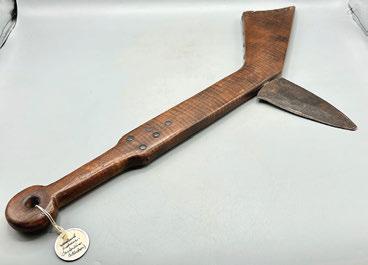
This 23-inch tiger maple gunstock tomahawk with 5-inch blade was bid to $6,100, the sale’s highest price ($4/8,000).

This 13½-by-9¾-inch tomahawk had a crow head spike and a wooden handle wrapped in leather and decorated with brass tacks; it made $2,440 ($2/4,000).
Soaring past its $100/300 estimate to achieve $3,660, this Marble’s knife measured 7¾ inches and was in a carved leather sheath.
An early pipe tomahawk, possibly made by or for a Northern Express trading post, rose above its $600 high estimate and matched the sale-high price of $6,100. Etched on the blade was a partial mark that read “…rthern Expre… / 53.” The auction catalog noted that the Northern Express was a Nineteenth Century train line. The item was cataloged as
being in “as-found” condition with expected wear for its age, though the tomahawk’s haft may have been a later replacement.
A fluted pipe tomahawk, this one with a tiger maple handle found a buyer for $3,050 ($2/4,000). The 23½-inch long carved handle was topped with a 7¾-inch hatchet head having a 2½-inch blade, decorated with brass stripes and an inset brass heart.
The fourth-highest earning tomahawk was an example with a pointed crow head spike opposite the blade on the hatchet. The auction catalog noted, “The spike is a very rare blacksmith crafted bird head effigy.” Additionally, its 13½-inch wooden handle was wrapped in leather and decorated with brass tacks, for both grip and appearance. A small piece of the wooden handle, that would be inside the hatchet head, was missing and resulted in a loose connection. Still, bidders took a liking to the object and it sold for $2,440.
Other items that performed well included a sheath knife, which made $3,660. Parker noted that this knife was one of the more surprising results of the day. “I had three Marble’s sheath knives
FAIRFIELD, CONN. — The Fairfield University Art Museum (FUAM) presents its latest exhibition, “Ink and Time: European Prints from the Wetmore Collection” on view through December 21 in the museum’s Bellarmine Hall Galleries.
Curated by Michelle DiMarzo, PhD (assistant professor of Art History & Visual Culture), the exhibition presents a group of woodcuts, engravings and etchings from the late Fifteenth through late Eighteenth Centuries, including Albrecht Dürer, Raphael, Rembrandt and Canaletto. The works are part of a
collection formed by New London, Conn., native Fanny Wetmore in the first decades of the Twentieth Century and bequeathed to Connecticut College in 1930. This exhibition is the second in the museum’s history to have been cocurated with Fairfield University students and has been supported by generous funding from the Samuel H. Kress Foundation.
The inspiration for the exhibition came from FUAM’s executive director Carey Weber, a Connecticut College alumna who remembered learning from this extraordinary teaching collection as an undergraduate art history stu-
dent. Dr DiMarzo explained, “Thanks to the generosity of our friends at Connecticut College, we were able to bring the prints to Fairfield a year in advance of the exhibition so that my students in the museum exhibition seminar could work with them directly as we developed the show.”
Weber added, “I’m delighted to have helped spark the idea for this exhibition, and even more pleased that one of my favorite pieces from the Wetmore Collection, Canaletto’s ‘View with a Porch,’ will be among the works on display in our galleries.”
Although little is known of

This early pipe tomahawk had a partial maker’s mark, possibly for Northern Express. Measuring 17¼ by 9½ inches and had a 3½-inch blade, it blew past its estimates and tied for the highest price of $6,100 ($200/600).
that did well. One of them, with just the three initials, brought over $3,000. It was real early and in such good shape, but it was still a surprise for me.” This example’s blade was marked “M…A. Co. / Gladstone / Mich – U.S.A.” for the Marble Arms & Manufacturing Company. The back side of the leather sheath was incised with cattail motifs.
Earning $3,355 was a circa 1750 steel flintlock pistol by Issac Bissell, engraved by the maker on its lock. The top of its round barrel had two Birmingham proof marks and was further engraved, “RHR” for the Scottish Royal Highland Regiment. According to the auction catalog, “Bissell made pistols for the Royal Highland Regiment, which became the 42nd Royal Highland Regiment, famously known as ‘Black Watch.’ The regiment carried Bissell pistols during the French and Indian War and the Revolutionary War. In the 1790s, the 42nd stopped carrying pistols.” The grip of the gun had a small incised floral motif on each side and a “ram’s horn” butt. Prices quoted include the buyer’s premium as reported by the auction house. Charles Street Auction’s next sale will be this fall, date to be announced. For information, 508-209-4512.
Fanny Wetmore herself, her collecting activities in the early Twentieth Century place her within a tradition dating back to the rise of printmaking in early modern Europe. The surging production of prints by the beginning of the Sixteenth Century represented a sea of change for both artists and consumers. For artists, prints provided additional revenue, increased their personal fame and offered greater latitude for experimentation outside the traditional patronage structure. For consumers, prints represented access to visual art on an unprecedented scale; even those who would never
have been able to commission an independent work from a great artist could now readily obtain an engraving or an etching. Prints were easily transported, could be pasted up on walls or into albums and even large collections of them took up relatively little room. And, with the rise of reproductive printmaking, even geographically distant or physically inaccessible artworks could be added to the collector’s “paper museum.”
The Fairfield University Art Museum is at 1073 North Benson Road. For more information, 203-254-4046 or www.fairfield. edu/museum.

165-piece Georg Jensen acorn sterling silver European dinner-size flatware service for 12, including a soft storage case ($18/22,000).
BROOKLYN, N.Y. — Sterling silver flatware services by Georg Jensen and Old Newbury Crafters, ladies watches by Graff and IWC, majolica, jewelry and pieces from Royal Vienna, Old Paris and Meissen are all part of SJ Auctioneers’ Super Luxury jewelry, silverware, toys and décor auction set for Sunday, September 22.
The online-only auction, starting at 6 pm Eastern time, features 221 lots of items by famous designers and makers, such as Tiffany & Company, Bvlgari, Audemars Piguet, Georg Jensen, Graff, IWC, Old Newbury Crafters, Prince Dimitri, Van Cleef & Arpels, Chopard, Harry Winston, Royal Vienna, Old Paris, Gorham, Gucci, Swarovski, Marx, Yonezawa and others.
Bidding is available online now, at LiveAuctioneers.com. Pre-bidding is also available, meaning for those who are unable to attend the online auction, they can still leave their bids now. This auction uses Autopay by LiveAuctioneers.com.
The 165-piece Georg Jensen acorn sterling silver European dinner-size flatware service for 12 includes six rare hors d’oeuvres spears. The set includes a soft storage case
($18/22,000). The 119-piece sterling silver flatware set for 12 by Old Newbury Crafters in the Wilton pattern was retailed by Shreve, Crump & Low and was hammered in a style similar to Georg Jensen ($14/16,000).
The IWC vintage textured 18K yellow gold Khanjar ladies’ watch with bezel features a 30mm case, 100 hours movement, a manual wind function for hours and minutes, a power reserve, 18K yellow gold clasp and a gold-colored strap ($8,5/12,000). The Graff 18K yellow gold Khanjar ladies watch has features similar to the IWC ($7,650/10,800).
Porcelains will be highlighted by a pair of Meissen hand-painted, marked figurines, about 13½ inches tall ($400/650) and a Royal Vienna hand-painted vase (or urn) showing the maker’s mark and measuring just shy of 8 inches tall and 3¾ inches wide ($250/500). Also up for bid will be Old Paris figurines.
Jewelry will be led by a sleek and sophisticated Bvlgari Tubogas tri-color gold necklace featuring a trio of precious metals (18K gold, sapphire and tsavorite) and dynamic tones paired with Bvlgari’s signature construction ($26,775/37,800).
LOS ANGELES — “Hollywoodland: Jewish Founders and the Making of a Movie Capital,” presented in English and Spanish, tells the origin story of filmmaking in early Twentieth Century Los Angeles, spotlighting the impact of the predominately Jewish filmmakers whose establishment of the American film studio system transformed Los Angeles into a global epicenter of cinema. This immersive gallery conveys the evolving topography of Los Angeles along the timeline of the developing movie industry, encouraging further exploration of the city’s landmarks. The exhibition spotlights the Jewish founders of the Hollywood studio

system, foregrounding the ways in which the birth of the American film industry — and the depiction of the American Dream — is at its heart an immigrant story. By exploring the origins of major studios as well as independent film production in Los Angeles, the exhibition conveys impactful stories of ingenuity and offers a deeper understanding of motion picture history.
“Hollywoodland” is curated by associate curator Dara Jaffe and is the Academy Museum’s first permanent exhibition.
The Academy Museum is at 6067 Wilshire Boulevard. For information, 323-930-3000 or www.academymuseum.org.

IWC vintage 18K yellow gold Khanjar ladies watch with a 30mm case, 100 hours movement, a manual wind function, 18K yellow gold clasp and a gold-colored strap ($8,5/12,000).
There are many other jewelry items in the sale as well, including a Bvlgari 18K yellow gold ring with a yellow Heliodor gemstone at the center, surrounded by 1.0 carats of diamond accents ($8,925/12,600); a necklace designed by Prince Dimitri boasting an imaginatively envisioned key pendant crafted from platinum and presented on a black cord ($7,735/10,920); and Van Cleef & Arpels earrings made from 18K yellow gold, with diamond accents weighing 1.10 carats ($6,545/9,240).
Also on offer will be a Chopard 18K white and yellow gold 1.35carat diamond heart pave necklace with a lobster clasp, with a gift box ($4,250/6,000) and a Trinity ring from Cartier featuring three interlocking bands in 18K yellow gold. Each band is fully lined with brilliant diamonds ($3,953/5,580).
Fans of majolica — the often wildly colorful pottery pieces so popular with collectors — will

Toys will also be plentiful, with lots that include a hard-tofind 1952 Marx Roy Rogers Rodeo Ranch playset with the original box ($150/350).
want to be mindful that there will be modest estimates to encourage brisk bidding activity for dozens of lots of majolica, in patterns, shapes and sizes that will complement any collection. Returning to silver, a sterling silver flask from the early Twentieth Century, inlaid with twotone 14K gold, measuring 5½ by 4 inches and approximately weighing 6 troy ounces, bearing hallmarks, should bring $800$1,200; and a sterling silver yacht sailboat with display case hand-crafted in Japan by the famous silversmith Takehiko (Seki Takehikoii), hallmarked 950 (a higher purity than sterling 925), signed Takehiko, mounted on a wood stand, is expected to make $200/250.
A group of six silver 84 tea spoons made in China by Russian silversmith émigrés who fled to Harbin, China, during the Russian Revolution in the early Twentieth Century, carries an estimate of $350/450. All spoons are hallmarked with the 84 Zolotnik mark and come in the original presentation box, with Japanese hand-written inscriptions. Each spoon is 4 3/8 inches long.

Toys will also be plentiful, with lots that include a hard-to-find 1952 Marx Roy Rogers Rodeo Ranch playset with the original box ($150/350); a German-made Schuco tin litho wind-up vehicle, 5½ inches long, with key, in working condition ($250/500); a Japanese-made Yonezawa tin toy replica of a Japan Airlines JAL Boeing 747 jumbo jet with the original box ($500-$1,000); and a set of four Pelham puppets made in England, 1960 ($300/750). For information, 646-450-7553, www.sjauctioneers.com or email sjauctioneers@gmail.com.




Michaan’s monthly gallery auction returns on Friday, September 20, and is set to feature a wide array of curious items. Featuring necklaces from the jewelry department, interesting pieces from furniture and decorations, and important items from the Asian art department, there is something for everyone. Headlining the auction are, an emerald necklace, multiple deaccessioned pieces from the Fine Arts Museums of San Francisco, including a Lancaster, N.Y., pitcher and an intricately embroidered Chinese imperial robe.
The acme of Michaan’s jewelry offerings is by far the emerald, diamond and yellow gold necklace ($4/6,000), which features 13 oval-cut and one pear-cut centerpiece, cabochon emeralds and a total of 11 diamonds, all set in yellow gold. Another piece on offer is a 24K yellow gold
neck chain ($4/6,000). This fancy link chain weighs approximately 55 pennyweights and would make the perfect gift for him, her or even oneself. Rounding out September’s jewelry highlights is a peridot, 14K yellow gold frog brooch ($500/700) and an impressive Omega 18K yellow gold wristwatch ($2/3,000) with original boxes. Michaan’s furniture and decorations department boasts a few lots that should get sports fans excited. To start, on offer is a 1951 Mrs Shoeless Joe (Kate) Jackson cut signature ($5/10,000), a piece that is sure to interest avid baseball fans. Infamous Chicago White Sox star Shoeless Joe Jackson was anecdotally illiterate, and would reportedly have his wife, Kate, sign autographs for him. This example of Kate’s handiwork comes with a 2020 JSA James Spence authentication (certification number BB36986). It was
CHARLOTTESVILLE, VA. —
Can colors have a conversation?
Do works of art “speak” to each other? Building on recent donations to The Fralin collection, “Conversations in Color: New Print Acquisitions” is an exploration of how works of art visually converse, reflecting how their creators engaged with each other and became exposed to new media.
Beginning about 1970, wellestablished artists known for their work in painting and sculpture began experimenting in printmaking, taking their simple, abstract forms into a new medium and contrasting their stripped-down shapes and lines with intense, luminous hues. Large-scale, color-rich painting and oversized sculpture were translated onto flat expanses of paper, but in doing so, artists began a conversation within their own work between painting, sculpture, architecture and printmaking.
Each artist represented here began a different conversation: between opposing colors and shapes, between their own work and that of others, between their earlier work and their new creations, between local artists and those across geographical distance, between

signed in the last year of Jackson’s life. Furniture and decorations also has items that should be of interest due to their beauty and uniqueness. A Lancaster New York blue blown glass pitcher ($600/800) is part of a collection of items deaccessioned from the Fine Arts Museums of San Francisco, and an Eighteenth Century American mahogany chest on chest ($2/3,000) is a piece to add beauty and character to any room. At the top of the Asian art department this month is a Chinese imperial robe ($2/3,000), apricot-ground and embroidered with six fiveclawed dragons depicted in pursuit of embroidered flaming pearls, amidst the “Twelve Symbols of Imperial Authority.” The robe also features a Lishui wave band, an open collar and a multi-stone buckle. A silver fili-

gree and jade hand mirror ($3/5,000) is a piece featuring intricate carvings and a dragon motif. Also on offer is a large Tibetan painted thangka of Buddha ($800-$1,200), an example of the traditional Tibetan painting often used as a principal meditational tool in Buddhist practice. Finishing off
these highlights is an ink and color on silk Japanese hanging scroll, Mori Sosen’s (1747-1821) “Monkeys” ($1,200-1,800) and framed Japanese embroidery of birds and flowers ($500/800). Michaan’s Auctions is at 2701 Monarch Street. For information, www.michaans.com or 510-227-2505.
Multi-Dealer Group Shop
•A fine collection of antiques & collectibles
•16,500 sq. ft. of dealer space
•Approx. 200 dealers
•Gift Certificates available
400 Honeyspot Road, Stratford, CT 06615
(203) 378-7754
Fax (203) 380-2086 stratfordantique@aol.com www.stratfordantique.com Visit the Big, Blue Building

teacher and student, between generations and cultures and between the distant past and the present. Many of these artists converged on the New York art scene, where they interacted with each other, but their legacy reverberates globally to a new generation of printmakers.
These artists invite us to consider, how do the colors themselves interact with each other? How are they interacting with you?
On view at The Fralin Museum of Art at the University of Virginia, “Conversations in Color: New Print Acquisitions” is on view through January 5. The Fralin Museum of Art is at 155 Rugby Road. For information, www.uvafralinartmuseum. virginia.edu or 434-924-3592.
NEW YORK CITY — The Art Students League of New York presents “A League of Nations,” a group show exploring the league as a creative nexus for artists from around the world since 1875. The exhibition is on view in the Phyllis Harriman Mason Gallery through November 30 at 215 West 57th Street. For information, www. artstudentsleague.org or 212247-4510.

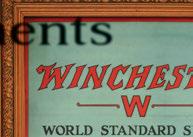





NEW YORK CITY — The American Folk Art Museum presents the exhibition “Anything but Simple: Gift Drawings and the Shaker Aesthetic,” on view through January 26.
The Shakers, often celebrated for their minimalist approach to design, are showcased in a new light with this exhibition. The “gift” drawings on display represent a departure from the simplicity typically associated with Shaker material culture. Made by women in the mid Nineteenth Century and believed to represent divine messages, these intri-
cate and vibrant drawings offer a unique glimpse into the interior world of the Shakers.
Opening during the 250th year of Shakerism in the United States, the exhibition features drawings widely considered to be among the finest surviving examples of this rare type. These symbols of love and nature were often given as “tokens” to other Shakers during meetings.
Brightly colored and replete with intricate ornamentation, they represent a stunning world of celestial imagery. Compared to examples of Shaker furniture

“A Type of Mother Hannah’s Pocket Handkerchief” by Polly Jane Reed (1818-1881), New Lebanon, N.Y., 1851, ink and watercolor on paper, 23-5/8 by 26 inches framed. Andrews Collection, Hancock Shaker Village, Mass., 63.126.1.

Untitled by William F. Winter (1899-1939), New Lebanon, N.Y., circa 1923-30, printed later from the original negative, gelatin silver print, 8½ by 11½ inches. New York State Museum, Albany, N.Y. H-9.1823.

with
and objects that will also be included in the exhibition, the vibrancy of the drawings will mark a distinct contrast with the clean lines typically associated with Shaker design.
“Not only were the Shakers exceptional craftspeople, they were also individuals with a deep spiritual connection to their work,” said Emelie Gevalt, AFAM’s curator of folk art and curatorial chair for collections.
“These drawings are a testament to the complexity of the Shakers’ vision, showing that their creativity was truly ‘anything but simple.’”
The gift drawings in the exhibition were made during an extraordinary time in Shaker history, when art and music flourished, and faith was renewed. This powerful era of revival among the Shakers resulted in spiritual revelations. Called the Era of Manifestations, or Mother’s Work, this revival connected newer believers to their founders. Women were often the ones who received these supernatural communications, which they saw as “gifts” taking the form of songs and poems as well as drawings on view in the exhibition.
Divided into several sections,

“The Tree of Life” by Hannah Cohoon (1788-1864), Hancock, Mass., 1854, ink and watercolor on paper, 25-3/25 by 29-13/16 inches framed. Andrews Collection, Hancock Shaker Village, Mass., 1963.117.
the exhibition opens with an indepth look at the Shakers themselves, as well as delving into the “Shaker aesthetic,” the Era of Manifestations and more. The drawings are accompanied by biographical information on the women who made them, enriching visitors’ experiences of these stunning objects with contextual understanding of their historical and spiritual meanings. The American Folk Art Museum is at 2 Lincoln Square. For information, 212-595-9533 or www.folkartmuseum.org.

“Heart-shaped Cutout to Sarah Ann Standish” by Polly Jane Reed (1818-1881), New Lebanon, N.Y., 1844, ink on pink paper. Andrews Collection, Hancock Shaker Village, Mass., 63.123.1.

“An Emblem of the Heavenly Sphere” by Polly Collins (1808-1884), Hancock, Mass., 1854, ink and watercolor on paper, 31-11/16 by 26-1/8 inches framed. Andrews Collection, Hancock Shaker Village, Mass., 1963.113.

“From Holy Mother Wisdom to Sarah Ann Standish” by Sarah Bates (1792-1881), Miranda Barber (1819-1871) and Polly Jane Reed (1818-1881), New Lebanon, N.Y., 1847, pen and ink on paper, 17-11/16 by 15-3/16 inches framed. Andrews Collection, Hancock Shaker Village, Mass., 1963.125.

NEW YORK CITY — The Jewish Museum has announced the first solo US museum exhibition dedicated to the work of interdisciplinary artist Ilit Azoulay (Israeli, b 1972, working in Berlin).
“Ilit Azoulay: Mere Things” includes selections of work by Azoulay from 2010 to the present, featuring large scale digital photocollages of archival objects that explore how images and objects transmit knowledge, shape memory and support or undermine historical narratives. The presentation features a new work that responds to the collections and context of the Jewish Museum, as well as selections from the series “Queendom”
(2022), first presented as part of Azoulay’s solo exhibition for the Israeli Pavilion at the 59th Venice Biennale in 2022.
The works on view combine photomontage with sculptural and sound elements to magnify different aspects of object histories and introduce imaginative and speculative frameworks that expose the ways in which objects can embody multiple, shifting meanings. Advancing the Jewish Museum’s vision as a beacon for the Jewish community and a place to explore universal values, the exhibition encourages viewers to recognize one another’s humanity by reconsidering how we perceive each other’s stories.
Much A Heart Can Hold’
MADISON, WIS. — Experience sprawling sculptural works made of cloth, human hair, scrap metal, wax, silk flowers and other unorthodox materials in “Petah Coyne: How Much A Heart Can Hold,” on view through December 23 at the Chazen Museum of Art. The exhibition features more than a dozen works, several on display for the first time. It serves as both a multi-decade exploration of the contemporary American sculptor’s career and an ode to women’s complexity and creativity.
A quote by Zelda Fitzgerald inspired the exhibition title. “Nobody has ever measured, even the poets, how much a heart can hold,” the American writer, dancer and painter once said. Coyne’s “Zelda,” a sculpture named in Fitzgerald’s honor, anchors the exhibition.
At nearly seven feet tall, the mixed-media work from the Chazen’s collection is made of silk flowers, wax, acrylic paint, white pearl-headed hat pins, artificial pearls, cast-wax statuary figure and hand sculptures, ribbon, knitting needles, fabric, thread, wire, horsehair, drywall, plaster, filament, rubber, steel and wood. It immediately ignites the tactile senses, yet a transparent glass box stands
between the viewer and the monochromatic work, representing a cage that is a metaphor for Fitzgerald’s life. Her accomplishments were thwarted by the time in which she lived and overshadowed by her marriage to F. Scott Fitzgerald. Many lines from her letters appear in her husband’s writings.
“We looked across Coyne’s long career and were inspired to focus on the creative work of women as interpreted through Coyne’s artistic process,” said Amy Gilman, director of the Chazen Museum of Art and exhibition curator. “Coyne looks at the woman as a heroine, cultural leader, dissident and activist and as a fellow creative who seeks to transform the deep aspects of consciousness and societal awareness.”
Coyne often celebrates underrecognized female authors and Eastern literary figures. Her works showcase the authors and characters; dissect their complex stories and examine how relationships, social constructs and self-image can shape how women — real and fictional — experience and navigate the world.
The Chazen Museum of Art is at 750 University Avenue. For information, 608-263-2246 or www.chazen.wisc.edu.

“Untitled #1378 (Zelda Fitzgerald)” (detail) by Petah Coyne, 1997-2013, specially-formulated wax, pigment, silk flowers, candles, paint, white pearl-headed hat pins, artificial pearl strands, cast-wax statuary figure, cast-wax hand sculptures, ribbon, knitting needles, steel rods, chickenwire fencing, washers, fabric, thread, wire, horse hair, Masonite, plywood, drywall, plaster, glue, filament, rubber, steel, wood and metal screws, maple, laminated Luxar®, 81-3/16 by 35¾ by 35¾ inches. Joen Greenwood Endowment Fund purchase, 2018.39a-b.
Initially trained in photography, Azoulay’s research-based practice explores the central role photography plays in archives and the idiosyncrasies of institutional systems created to preserve and produce knowledge. As an outgrowth of this practice Azoulay created a new work, “Unity Totem” (2024), for the exhibition, mining the Jewish
Museum’s collection for ritual objects, such as Torah finials, and amulets, mostly created by Jewish communities in various parts of the Arab world, including in the artist’s familial homeland of Morocco.
The exhibition is organized by Shira Backer, Leon Levy associate curator, The Jewish Museum.
“Ilit Azoulay: Mere Things” is


BATTERSEA PARK, LONDON
@DECORATIVEFAIR
DECORATIVEFAIR.COM
made possible by Bil Ehrlich and Ruth Lloyds, Jack and Judy Stern and other generous donors, together with the Barbara S. Horowitz Contemporary Art Fund and the Melva Bucksbaum Fund for Contemporary Art. The Jewish Museum is at 1109 Fifth Avenue at 92nd Street. For information, 212-423-3200 or www.thejewishmuseum.org.



Steinway Piano Plays To Win at Roland GLEN COVE, N.Y. — On August 24, Roland Auction conducted its estates sale, which offered 674 lots of fine and decorative arts, Twentieth Century modern, antique and vintage furniture; textiles, silver, gold and silver jewelry, rugs, collectibles, Asian art and lighting. Leading the sale was an ebonized upright piano and bench by Steinway & Sons. The Model 100 piano was manufactured circa 1958 and was marked “N1179.” The piano itself measured 42 inches high, 59 inches wide and 23½ inches deep, and played its way to $5,312 against a $2/3,000 estimate. For information, 212-260-2000 or www.rolandauctions.com.

Massive Sterling Silverware Set, Japanese Woodblock Print Score Big At Winter Assoc. PLAINVILLE, CONN. — In an August 26 auction, antiques, fine art and more from estates and households throughout Connecticut were on offer at Winter Associates, including a wide variety of single-owner collections of Georg Jensen and Tiffany silver. Tied for top lot were a 227-piece set of Lebolt sterling silverware and a woodblock print by Kawase Hasui (Japanese, 1883-1957), each bringing $13,200. There were 275 pieces by J. Myer Lebolt, Chicago, patented 1912, and two similar pieces by other makers, 16-piece service for 12 and others, all with hammered texture and pointed teardrop end, monogrammed “D” with maker’s marks. The Hasui woodblock print (shown), “Kannon Temple at Abuto,” 1922, was from the series “Selection of Views of Japan (Nihon fukei senshu),” depicting a cliffside temple above the sea in a whiteout snowstorm, For information, 860-793-0288 or www.auctionsappraisers.com.

Hermes Anchor Chain Service Anchors Doyle At Home Auction
NEW YORK CITY — Doyle’s 396-lot At Home auction on August 28 featured Asian works of art, fine art, furniture and decorative arts, luxury handbags, accessories and fashion. A porcelain dinner service by Hermes, in the Chain de’Ancre (Anchor Chain) pattern, attracted deep-pocketed bidders, who pushed the 52-lot service to $8,960, nearly five times its high estimate. For information, 212-427-2730 or www.doyle.com.


All prices include buyer’s premium.

Roman Bust Owned By Williams & Vidal Heads Swann Galleries’ LGBTQ+ Auction NEW YORK CITY — On August 22, Swann Galleries presented its annual LGBTQ+ Art, Material Culture & History sale, a 447-lot event that was more than 82 percent sold by lot. Heading the sale at $68,750 was a Roman bust of a youth that dated to approximately the Second Century CE and stood 10½ inches tall. Both Gore Vidal and Tennessee Williams were listed among its prior owners, with Williams giving it to Vidal in 1950 as a house-warming present. It was featured in Life Magazine (April 25, 1960), Architectural Digest (January 1994) and Gawker Magazine (November 12, 2008). For information, 212-254-4710 or www.swanngalleries.com.

Anti-Republican Broadside Leads Doyle DeWitt Americana & Political Showcase DALLAS — Partisan politics were the topic of an 1884 broadside titled “How the Public Domain Has Been Squandered” that earned $11,250 in Heritage Auctions’ August 24 sale of Selections from the J. Doyle DeWitt Collection of Americana & Political Showcase. The 16½-by-23½-inch document, which showed swaths of land given to the railroad by the Republican Congress, was the top lot in a 491-lot sale that achieved $167,986 in total. For information, www.ha.com or 214-528-3500.

George Morrison Abstract Composition
Colors Kodner Galleries Sale DANIA BEACH, FLA. — Bright colors of yellow, blue and red replaced the firm’s usual “ice” hues of diamonds and gems in Kodner Galleries’ as the top lot in its August 21 estate jewelry, fine art, decoration and collections sale. George Morrison’s (Native American, 1919-2000) oil on paper abstract composition led the day, smashing its $400/600 estimate and selling at $12,100. Untitled, the work was signed in the bottom right hand corner, framed under glass. It measured 6 by 5-5/8 inches, with frame, 9½ by 9 inches. An Ojibwe abstract painter and sculptor from Minnesota, Morrison’s work is linked to the Abstract Expressionist movement in the United States. For information, www.kodner. com or 954-925-2550.
‘Finest Original 12 Lily Tiffany Lamp It Has Ever Sold’ Leads Woody Auction DOUGLASS, KAN. — An original late Nineteenth or early Twentieth Century 12-light Tiffany Studios Lily table lamp, French cameo art glass vases by Galle and Daum and a French cameo art glass boudoir lamp signed “Daum Nancy” and more all competed for top lot in Woody’s August 24 auction. In the end it was the original lily lamp marked “Tiffany Studios #382” that prevailed, selling for $28,600. Measuring 20 by 11 inches, the bronze lily pad 12-light base with original patina and switch hardware and all 12 gold favrile shades marked “LCT,” which came from a private Illinois collection, sold to another collector bidding by phone. The auction house noted that this was the finest original 12 lily Tiffany lamp it has ever sold. For information, 316-747-2694 or www.woodyauction.com.

Chanel #5 Silkscreen Makes $9,600 For World Auction Gallery
EAST MEADOW, N.Y. — A silkscreen on paper titled “Chanel #5” and attributed to Andy Warhol was the highlight of the day on August 25, when World Auction Gallery sold just over 400 lots in an estate sale of arts and antiques. Bearing a pencil signature on the front and copyright stamps for both Andy Warhol and Chanel on the back, the 37¾-by-37¾-inch sheet came from a Midwest home and carried an estimate of $2/3,000. Interest in the lot took it to $9,600 and it sold to a private collector with homes in New York and Pennsylvania bidding on the phone. For information, 516-307-8180 or www.worldauctiongallery.com.

Wristwatches Tick To Top At SJD Auctions
AMENIA, N.Y. — A collection of five wristwatches led SJD Auctions’ antiques and collectibles sale, which took place on August 27. “The highlight in this lot was the Omega Automatic Constellation watch,” said Jason DeAddio, auction manager at SJD Auctions. The Omega watch was the only one of the five — which also included watches from Elgin, Geneva and Seiko — that still ticked; the rest required battery replacement. The buyer, from Snohomish, Wash., a suburb of Seattle, placed the winning bid for $672. For information, 845-4897408 or www.auctionninja.com/sjd-auctions.

Unsigned Seventeenth Century oil on canvas painting from the workshop of Francesco Albani (Italian, 1578-1660), titled “The Dance of Cupids,” 29¾ by 39¾ inches, minus frame ($8/12,000).
ATLANTA, GA. — Just one day after offering nearly 400 lots from the Atlanta estate of Gregory Crawford, Ahlers & Ogletree will get right back in the saddle on Friday, September 13, with a an estates auction featuring an assortment of unique antiques, including silver and crystal, period furniture, hand-woven tapestries and carpets, original paintings, sculptures and more.
The 330-lot auction, starting at 10 am Eastern time, will be conducted online as well as live in the Ahlers & Ogletree gallery. One of the headliners is the collection of fine and decorative arts from Diana McCluskey of Tampa, Fla. Other items have been pulled from prominent estates and collections, mostly in the Greater Atlanta area.
The centerpiece of the McCluskey collection is an unsigned Seventeenth Century oil on canvas painting from the workshop of Francesco Albani (Italian, 1578-1660). The figural rendering, titled “The Dance of Cupids,” measures 29¾ by 39¾ inches (minus the frame). It was acquired from Tajan, Paris ($8/12,000).
A seven-piece coin silver floral repousse hot beverage service by Grosjean & Woodward (American, 1847-1862), com-
prises one tilting hot water urn on a stand, one coffee pot, one teapot, one covered sugar bowl, one lidded cream jug, and one waste bowl, plus an unmarked silverplated tray, 33 inches in diameter. All are hallmarked and the total weight, excluding tray, is approximately 190 troy ounces ($6/8,000).
A late Nineteenth Century French mythological scene tapestry depicting two gentlemen (possibly Aristotle and Alexander the Great), greeting two maidens in a landscape while Cupid looks on, is 104 by 116 inches and is contained within a scrolling acanthus border with anthemion corners ($4/6,000)
Three sculptures — two bronze and one marble — have identical estimates of $4/6,000. They are an unsigned Italian School white marble sculpture after Antonio Canova (Italian, 1757-1822), titled “Psyche Revived by Cupid’s Kiss,” standing 32½ inches tall by 36 inches in width; a bronze sculpture on a red marble plinth by Karl Sterrer (Austrian, 1844-1918), titled “Mythological Group / Persephone Led by Hippocampi,” 13 inches tall, signed “K. Sterrer”; and a late Nineteenth/ early Twentieth Century figural bronze sculpture by Raoul Francois Larche (French, 1860-

Unsigned Italian School white marble sculpture after Antonio Canova (Italian, 17571822), titled “Psyche Revived by Cupid’s Kiss,” standing 32½ inches tall ($4/6,000).
1912), titled “La Seve / Metamorphoses of Daphne,” 36¾ inches tall, signed, with foundry mark.
An oil on canvas painting by Aleksei Popov (Ukrainian, 1916-1988), titled Builders of the New Port, signed in Cyrillic and housed in a 26½-by-51-inch frame, is expected to finish at $4/6,000; while an oil on canvas untitled beach scene signed by Gaston Sebire (French/American, 1920-2001), 28½ by 36¼ inches (less frame), with a Christie’s label on verso, should hit $3/6,000.
An early Twentieth Century Louis XV-style bronze mounted rosewood veneer envelope card table made by Paul Sormani (French, 1817-1877), with a fold-out top, a red felt game surface, over a single drawer, and raised on cabriole legs with sabot feet, is signed by Sormani ($4/6,000).
A pair of Nineteenth Century French Louis XV-style bronze mounted marble cassolettes (urns), 22¾ by 10¾ inches, are expected to finish at $3/5,000. The ormolu mounted fleur de peche marble lidded urns with flame finial are raised on paw feet with a tripartite base.
A gilded and enameled “Imperial Peter the Great” crystal Easter egg set, after the egg
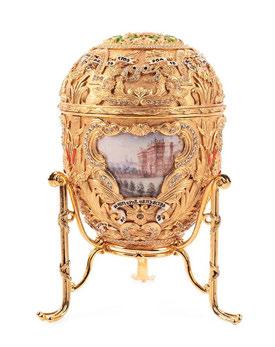
Gilded and enameled “Imperial Peter the Great” crystal Easter egg set, after the egg presented by Nicholas II to his wife Alexandra Feodorovna in 1903, part of a 20-lot collection of enamel works by Faberge in the auction ($3/5,000).
presented by Nicholas II to his wife Alexandra Feodorovna in 1903, set with Austrian crystals and having painted enamel images and a surprise modeled after Gerogii Malychevin’s monument to Peter the Great, should hit $3/5,000. The egg is offered as part of a 20-lot collection of enamel works by Faberge.
A seven-piece sterling silver hot beverage service by Gorham Mfg. Co., (American, est. 1831) in the “Plymouth” pattern (active 1911-91), comprising a tilting hot water kettle on a stand, a coffee pot, a teapot, a covered sugar bowl, a cream jug and a waste bowl, plus a Miyata (Japanese) nickel silver tray 26½ inches in diameter, all marked and weighing a total 106.59 troy ounces, should gavel for $3/4,000.
An early Twentieth Century Italian School sterling silver sculpture of the “Birth of Venus” on a marble base, with Venus standing on a shell supported by a dolphin, waves and a mermaid, unmarked and tested for silver quality, 19¾ inches tall and weighing approximately 100 troy ounces may command $2,5/3,500.
A pair of French ormolu mounted mahogany dessert console tables crafted in the
NEW YORK CITY — On view through January 5 at The Metropolitan Museum of Art, “Mexican Prints at the Vanguard” explores the rich tradition of printmaking in Mexico — from the Eighteenth to the mid Twentieth Century — through works drawn from the museum’s collection. Among the early works presented are those by Mexico’s best-known printmaker, José Guadalupe Posada, whose depictions of skeletons engaged in different activities helped establish a global identity for Mexican art. Following the Mexican Revolution (1910–20), printmaking proved to be the ideal medium for artists wanting to address social and political concerns and voice resistance to the rise of fascism
around the world. Artists also turned to printmaking to reproduce Mexican murals from the 1920s and to create exhibition posters, prints for the popular press and portfolios celebrating Mexican dress and customs.
“This remarkable exhibition evokes the continued resonance of the graphic arts in Mexico and illuminates treasures of The Met collection — many of which have never been exhibited before,” said Max Hollein, The Met’s Marina Kellen French director and chief executive officer. “Reflecting a vibrant tradition that is deeply imbued with political and social history, these works exemplify the extraordinary power of print as a medium and the importance of creative expression as
response to specific cultural moments.”
Featuring over 130 works, including woodcuts, lithographs and screen prints, by artists such as Posada, Diego Rivera, José Clemente Orozco, Elizabeth Catlett and Leopoldo Méndez, the exhibition explores how prints were central to artistic identity and practice in Mexico and highlights their effectiveness in addressing social and political issues, a role of the graphic arts that continues today. The bulk of The Met’s expansive collection came through the French-born artist Jean Charlot, whose association with the museum began in the late 1920s. Charlot donated many of his own prints and works by other artists to The
Met, and in the mid-1940s acted on behalf of the museum to acquire prints in Mexico.
The Metropolitan Museum of Art is at 1000 Fifth Avenue. For information, 212-535-7710 or www.metmuseum.org.
Louis XVI taste by Maison Jansen (French, 1880-1989), each having a marble top and single shelf partially enclosed by a gallery rail, two drawers and rising on tapering top fluted legs, is estimated to fetch $2/4,000. Online bidding will be provided at www.bid.AandOauctions. com, as well as LiveAuctioneers and Invaluable. Telephone and absentee bids will also be accepted.
Previews will be conducted Monday, September 9, from 10 am to 5pm; Tuesday, September 10, from 10 am to 5 pm (with extended evening hours from 5 to 8 pm); and Wednesday, September 11, from 10 am to 5 pm, in Ahlers & Ogletree’s Atlanta gallery is at 1788 Ellsworth Industrial Boulevard NW. For information, 404-869-2478 or www.aandoauctions.com.

Frame Restoration and Gilding
17th-19th Century Paintings & Prints
Over 40 Years Experience Member American Institute for Conservation Macomber Art Restoration Services 252-229-5270 macartrestore@gmail.com
Saturday, September 28 9am to 3pm


From the Holdens, this pair of Nineteenth Century ancestral portraits of a man and woman were estimated at $800$1,200 but finished at $3,900.
COPAKE, N.Y. — On August 24, Copake Auction conducted an unreserved estate auction of more than 900 lots. Seth Fallon, co-owner, said the event was “white glove,” with 100 percent sold and totaling $243,000. Bidders from five countries participated with close to 3,000 registered across four platforms, plus a small in-house contingent. “It was a good sale,” said Seth Fallon.
The sale featured two prominent collections with additions from other regional estates. Leading the day was an original Nineteenth Century Louis Vuitton trunk, which sold for $7,813. “These always seem to do well,” observed Fallon. “This one was large, a nice size to use as a coffee table.” Just as the outside was original, so was the interior compartment. Featuring stamped hardware, the 43½-by-22-by-23-inch trunk had cast metal side handles and was marked “2” on its side. In addition to items from a 40-year collection from antiques dealers Ed and Anita Holden, the sale offered the second session with items from
the estate of actor Edward Herrmann (1943-2014).
“That did really well,” said Seth Fallon in regards to a 1928 portrait painting of Henry Lamb by Duncan Rathburn Hannah (1952-2022).
Lamb was an Australian-born British painter who founded the Camden Town Group in 1911 — a group of English, Post-Impressionist artists who were known to gather at Walter Sickert’s studio in the Camden Town area of London. From the Herrmann estate, the 28-by-16-inch painting depicting the artist wearing a tan suit and standing near a gated wall, performed well by beating its $300/500 estimate handily and selling for $6,875.
The Ed and Anita Holden collection contributed a painted Nineteenth Century Swedish serving table. Standing 35¾ inches high, the table also outperformed its $500/600 expecta-



This painted Nineteenth Century Swedish serving table from the Ed and Anita Holden collection outperformed expectations of $500/600, selling at $4,200.
tions, selling at $4,200.
Additionally from the Holdens, came a pair of Nineteenth Century ancestral portraits of a man and woman. Done in oil on canvas and housed in tiger maple frames, the portraits were estimated $800-$1,200 but did much better, finishing at $3,900. “I don’t know who did them,” said Seth Fallon, “but they were beautiful. They had been in the Holdens’ dining room.”
Mike Fallon, co-owner of Copake, recalls that the Holdens invited some select dealers into their home, where they sold much of their collection.
“After that was done, they said to us, ‘take everything that’s left,’” he explained. The couple, now living in Florida, may be known to readers of Antiques and The Arts Weekly , having participated in many shows including Rhinebeck and others. Ed Holden, a former IBM engineer, had a unique perspective on the antiques trade. Mike Fallon said, “There were several people in the audience at the sale who wished they had bought some items at the earlier house sale.”
As for the Herrmann estate, Mike Fallon stated that it was “99 percent done,” save for a


few items. Unsold lots include an Arabic dagger with inlay, found in a drawer and accompanied by a note written to Lowell Thomas — one of America’s most famous journalists — and signed T.E. Lawrence aka Lawrence of Arabia. It will be featured in Copake’s annual New Year’s Day sale. Prices given include the buyer’s premium as stated by the auction house. The next sale, always highly anticipated, is Copake’s annual antique and vintage bicycle sale, swap meet and ride, set for October 11-12. For information, 518-641-1935 or www.copakeauction.com.
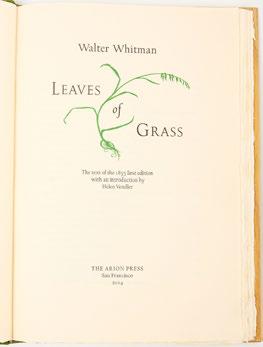
4. Bidding is available live in the gallery, on the firm’s website at www.newenglandauctions.com as well as Bid Square, LiveAuctioneers and Invaluable. New England Auctions is at 14 Business Park Drive. For information, 475-234-5120.
WASHINGTON, DC — Mauricio Lasansky (1914-2012) was an exceptional artist and printmaker who played a key role in the American printmaking renaissance following World War II. Among his best-known works are “The Nazi Drawings,” an extraordinary series of 30 monumental individual drawings produced between 1961 and 1966 plus a drawing triptych made between 1963 and 1971. The entire suite has been given to the National Gallery of Art by The Levitt Foundation of Des Moines, Iowa, to steward as part of the nation’s art collection. This gift represents a transformative addition to the Gallery’s holdings of Lasansky’s work and is the first acquisition of drawings by the artist.
Lasansky was born in Argentina; his parents were Jewish émigrés from Lithuania. His work focused primarily on the human figure, which he often explored through themes of war and suffering. Lasansky’s early work shares affinities with stylized forms of Latin American murals. From the 1940s onward — having moved to the United States in 1943 to further his artistic study and experimentation — his art encompassed elements of cubism (with boldly fragmented forms) and surrealism (in haunting and often brutal imagery).
Lasansky began “The Nazi Drawing”s in 1961, the year of the first televised trial of Adolf Eichmann, the Nazi war criminal and a major organizer of Holocaust atrocities. Justice, human rights and humanity were longstanding concerns for Lasansky, and he began to address the horrors of the Nazi regime in some work prior to creating “The Nazi Drawings.”
“‘The Nazi Drawings’ are an extraordinarily powerful suite
of works that depict the trauma and violence of the Holocaust. The series also emphasizes the repercussions of this unfathomable tragedy of the Twentieth Century,” said Kaywin Feldman, director of the National Gallery of Art. “Lasansky represents an important generation of artists — many of whom are not as well-known as they should be — who emigrated to the United States during the global political turmoil of the 1940s and became citizens who played an important role in shaping American art and culture. We are grateful to Richard and Jeanne Levitt and the Levitt family for their generosity in sharing this landmark series with the nation.”
To do justice to the urgency and emotional tenor of the subjects in the project, Lasansky purposely chose the direct, elemental medium of drawing. “I tried to keep not only the vision of ‘The Nazi Drawings’ simple and direct, but also the material I used in making them. I wanted them to be done with a tool used by everyone everywhere, from the cradle to the grave, meaning the pencil.”
The universality implied by this decision underscores the artist’s motivation for creating these powerfully raw, disturbing images: to monumentalize human suffering and loss as a warning against the evils of unrestricted power, prejudice and cruelty. The frenetic energy with which he wielded his pencil produced a wide range of tones, from deep black to pale gray. In some works, Lasansky also incorporated scraps of newspaper, Bible pages and other collaged elements, as well as selective painterly additions of red wash, spatters and drips and pale brown wash of turpentine mixed with asphaltum — all contributing a sense of

“Triptych” by Mauricio Lasansky (1914-2012), three panels, 1963-71. Graphite and charcoal, with erasures, brush and asphaltum turpentine, red and white wash, with splatters of red wash, cut, torn, folded, and pasted newspaper, biblical scripture and paper, on card paper, with some torn edges. National Gallery of Art, Gift of The Levitt Foundation - Des Moines, Iowa, 2024.43.30.a-c. ©Lasansky Corporation Gallery. Photo: Minneapolis Institute of Art / Lasansky Corporation Gallery.
dynamism and urgency, inviting a visceral reaction to the horrors portrayed.
Numbered rather than individually titled, ‘The Nazi Drawings’ can be roughly separated into four categories including images of Nazi soldiers, characterized by monstrous features and an evolving “death” helmet in the shape of a skull; the Nazis’ physical abuse of women, which included forced prostitution in concentration camps; the plight of women and children, the experiences of anguish and death, calling to mind a modern-day Massacre of the Innocents; critiques of elements of the Catholic Church for their response to the Holocaust.
The drawings were first presented in a landmark exhibition from 1967 to 1970, that opened at the Philadelphia Museum of Art and traveled to eight additional cities: New
York, as one of several opening shows for the then new Whitney Museum of American Art; Des Moines, Iowa; Tacoma, Wash.; Indianapolis, Ind.; Huntington, W.Va.; Chicago; and Mexico City, Mexico. The show closed in Iowa City, Iowa, where Lasansky worked, taught and lived.
After the touring exhibition closed, Lasansky added a drawn and collaged triptych to the set, which he had created while the other drawings were traveling. Measuring 80 by 120 inches overall, this enormous work merges Nazi references (a swastika in the far right panel) with allusions to contemporary traumas of racism and human rights violations (a figure in a white hood conjures associations with the Ku Klux Klan).
The fallen figure on his back, at far left, evokes photographs of the many civil rights and anti–Vietnam War protesters
knocked down by police during the marches and protests of the late 1960s.
While on tour, “The Nazi Drawings” attracted enormous attention in the press. Richard and Jeanne Levitt, a prominent couple living in Des Moines who collected art and were known for their philanthropy in art, community, education and civic and Jewish organizations, acquired the suite for their family foundation in 1972 with the promise to Lasansky that they would ensure that the drawings be kept together, in their original frames, in perpetuity. The Levitt Foundation has taken great care to preserve the drawings while making them accessible through loans and exhibitions. They have been on extended loan at the art museum of the University of Iowa for many years. In 2016-2017, The Levitt Foundation funded a major preservation treatment of the drawings, conserving all 33 sheets with improved glazing and archival mounts while retaining the original molded metal frames. They were last shown in the exhibition “Envisioning Evil: ‘The Nazi Drawings’ by Mauricio Lasansky,” at the Minneapolis Institute of Art from October 16, 2021, to June 26, 2022 and the Baker Museum in Naples, Fla., from September 17, 2022 to March 5, 2023. Richard Levitt died in 2017 at the age of 87 and Jeanne Levitt recently turned 93. Their children, Randall and Mark Levitt, and grandchildren, Elliot Levitt and Rachel Federowicz, recently made the decision, with Jeanne and in consultation with members of the Lasansky family, for The Levitt Foundation to donate the drawings to the National Gallery. For information, www.nga.gov or 202-737-4215.
SAN MARINO, CALIF. —
The Huntington Library, Art Museum and Botanical Gardens has acquired an ambitious, large-scale masterpiece by Eighteenth Century French portraitist Antoine-François Callet, the official painter of Louis XVI. The work is the fourth in a series of acquisitions made possible by The Ahmanson Foundation.
Painted at the height of the artist’s career, “Portrait of the Comte de Cromot, Superintendent of the Comte de Provence, at an easel, accompanied by his two daughters-in-law” is a unique Old Master work that contains a painting within a painting. The small landscape on the easel adjacent to the sitter was painted on a separate canvas and signed by the Comte de Cromot himself, known to be an amateur painter, and then inserted into the overall composition by Callet.
The complex portrait is on

“Portrait of the Comte de Cromot, Superintendent of the Comte de Provence, at an easel, accompanied by his two daughters-in-law” by Antoine-François Callet (Paris, 1741–1823), 1787, oil on canvas, 77¾ by 63¾ inches. Gift of The Ahmanson Foundation. The Huntington Library, Art Museum, and Botanical Gardens.
view in the Huntington Art Gallery this fall as an important counterpart to the institution’s world-class collection of Eighteenth Century French decorative arts, and it complements the recent addition of “Joseph Hyacinthe Françoisde-Paule de Rigaud, comte de Vaudreuil” by Élisabeth Louise Vigée Le Brun, which also became part of the collection through a gift from The Ahmanson Foundation.
“This historically significant work by Antoine-François Callet is an extraordinary addition to our signature portrait collection and will be vital in our interpretive work as we draw connections to our related French holdings,” Huntington president Karen R. Lawrence said. “We are immensely grateful to The Ahmanson Foundation for their support in strengthening The Huntington’s collection of European art with this masterpiece.”
“The portrait of the Comte de
Cromot is exceptional both historically and artistically,” said Christina Nielsen, Hannah and Russel Kully director of the Art Museum at The Huntington. “It has tremendous presence — great not only in scale but also in ambition as it contains four portraits in one: that of the Comte de Cromot, his two daughtersin-law and the future King Louis XVIII, seen in a roundel on the wall in the background.”
The Huntington Library, Art Museum and Botanical Gardens is at 1151 Oxford Road. For information, 626-405-2100 or www.huntington.org.
Dover Antique & Vintage Market Sept. 14 • 282 Durham Rd, Dover, NH Indoor and Outdoor Space Available Early pick or set up outside $35. at 7am. Leave when you want. Free admission 9 am to 1pm www.gurleyantiqueshows.com
8:30 am to Noon Sept. 8 and 22, Oct. 6
Admission: $5 - 8:30am to 9:30am Free Admission - 9:30am to Noon Complimentary Coffee and a Variety of Goodies. Over 40 dealers. No sale tax. Early admission $30 pp 7:00am to 8:30am 603-506-9848
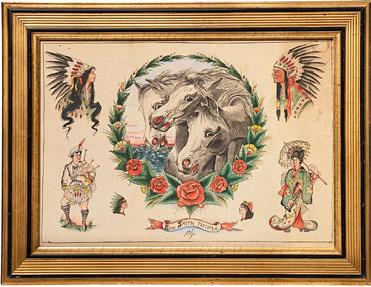
The Pharaoh’s
design of this
of
the
“exceptional.” A buyer who had never previously bought from Derin Bray paid $12,800 for the dated 1911 sheet by Ed Smith ($3/4,000).

Several pieces from the Baltimore shop of “Tattoo Charlie” Geizer were included in the sale, among them this neon shop sign. It was acquired by the Maryland Center for History & Culture for $3,382 ($3/5,000).

“I’m confident it is the first time the shade is leaving New England,” Derin Bray quipped about this circa 1905 window shade with hand-painted tattoo flash by Frank Howard of Boston that measured 40 by 20 inches and was the top-seller from the Howard collection. An American buyer won it for $6,765 ($2/4,000).
PORTSMOUTH, N.H. — It has been just 11 months since Derin Bray launched Bray & Co., Auctions with a 214-lot Tattoo, Circus, Sideshow & Curiosities auction, which was 97 percent sold by lot and totaled $301,678. Bray repeated the feat on August 25, and not only exceeded the size of the auction but the total yield, achieving $395,443 and a growth of 131 percent with all but two lots finding new homes.
Flash art, tattoo collectibles and ephemera and related material enjoy an international audience that has stepped up to support Bray’s sales: descendants of an important early Japanese tattoo artist
contributed a large collection to the auction and he fielded calls and bids from buyers around the world. More than 350 bidders participated in his first sale; this grew 154 percent a year later with nearly 560 bidders participating in his most recent event.
Bray noted the field as one that has “existed for a long time, underground, as a very small group of people. My sales are making it more available and accessible; a lot of these things wouldn’t have ever been on the radar of collectors just because of where it’s coming from. There is cross-over interest from people who collect photography, ephemera and folk art. I’m seeing a renais-
sance right now for people who understand the material. A lot of collectors are in their 20s, 30s or 40s; many of them are tattoo artists or it’s part of their heritage.”
What Bray described in the catalog as being “one of the finest examples known of flash art from the early 1900s” was the star lot, earning $22,140. The circa 1905 hand-painted book of tattoo designs for Western clients was inscribed both “Y. Sudsuki” and “S. Yamasaki” and featured American, British and Australian motifs popular in the period. It came to Bray from a Japanese seller because of the result he’d achieved for a similar example in his September 2023 sale.

This early book of tattoo designs, hand-painted in Japan around 1905, offered a rare glimpse into the career of a traveling artist in the Meiji era. Measuring 8½ by 7¼ inches, it featured more than 175 designs and brought the sale’s highest result: $22,140, from an advanced collector in the United States ($10/15,000).

This upright tattoo machine had been owned by “Tattoo Charlie” Geizer and was made circa 1935, stamped “Made by Prof. Chas Wagner New York City” on the front of the frame and “Waters” on the armature bar. A collector new to Bray & Co., drove bidding on it to $6,080 ($1,5/2,500).

Walter Maurice Lyons was born in Australia and learned to tattoo while working on ships. He worked in San Francisco, Sacramento, San Diego, Los Angeles and other locations in the 1890s and after but returned to Australia in 1917. His circa 1907 business card traded hands for $3,690 ($1/1,500).

If you were a customer of Charle Geizer between 1953 and 1977, your name will appear in one of the 11 handwritten record books he kept. The Maryland Center for History and Culture acquired the archive for $1,230 ($300/500).

G.E.
1950 travel trunk was described as “remarkably complete,”
and everything the Canadian tattoo artist would need. An Italian buyer had the $14,760 prevailing bid ($5/10,000).

Betty Broadbent (1909-1983) was one of the most famous of tattooed people who performed for decades with Ringling Brothers and Barnum & Bailey and the Clyde Beatty Circus. This rare sideshow banner brought $11,070 from an American collector ($10/15,000).
Travel trunks — made to be portable workstations for itinerant tattoo artists — achieved some of the sale’s highest prices. A circa 1925 Art Deco example, made by Amund Dietzel (1891-1974) in Milwaukee, Wis., had both exhibition and publication history and sold to an international buyer for $17,220. A circa 1950 greenpainted trunk used by tattoo artist Gilbert Edward “Nipper” Miller (1927-2003) of Midland, Ontario, Canada, achieved $14,760 from a buyer in Italy. It was considered complete and included three tattoo machines, sheets of commercial, hand-drawn and painted designs, pigments and ink, needles, clip cords and more.
“It’s one of the great sheets — maybe the greatest pre-war flash — that was signed and dated by an important Boston tattoo artist,” was Bray’s comment to us in reference to a framed hand-painted sheet of tattoo designs by Ed Smith (1868-1930). The 19-by-13 ½inch sheet was purchased by a buyer, new to Bray, for $12,800.
“Banners of tattooed people are hard to find,” Bray said, so he was happy to have an oil on canvas sideshow banner showing Betty Broadbent, one of the most prominent tattooed persons who was, in 1981, the first person inducted into the Tattoo Hall of Fame. Attributed to Snap Wyatt (Florida, 19051984), the 106-by-116-inch
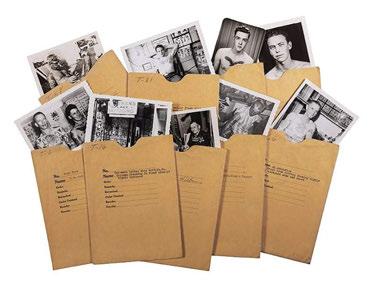
“If there was a surprise in the auction, it was in the strength of the photos and ephemera, which are almost rarer than anything else,” Derin Bray said. The son of famous tattoo artist Huck Spaulding consigned pieces from his father’s collection to the auction; it was topped at $9,225 by a 256piece archive of photos and negatives ($2/4,000).

This custom-made 14K yellow gold, bear claw and elk tooth pendant was made around 1979 for Huck Spaulding and was accompanied by a photo of Spaulding wearing the pendant while standing beside tattoo artist Eddie “Tex” Peace. The 2¼-inchlong pendant realized $2,091 ($1/1,500).
banner found a new home with an American buyer, for $11,070. Other banners in the auction included two by Fred Johnson: a circa 1940 “Half Human Half Beast” ($1,845) and “Rats in the Henhouse” ($1,599); an unattributed banner advertising “The Newest & Most Unusual Items / For Season 1928” brought $1,536. Bray was delighted to get the collection of Darwin “Huck” Spaulding (1928-2013), a noted tattoo artist who partnered with Paul Rogers to create one of the most well-known companies of tattoo supplies in the world. An archive from Spaulding and Rogers, comprised of 256 total photographs and negatives, some of which had never previously been published, more than doubled its high estimate and sold to a private collector for $9,225. A novelty from Spaulding’s collection was a pendant — custom made from a bear claw and elk tooth and 14K yellow gold — worn in 1979 by Spaulding at the Fourth World Convention of Tattoo Artists & Tattoo Fans in Houston, Texas. It exceeded expectations, making $2,091.
Another collection that contributed to the size and success of the auction was from the Boston shop of Frank Howard (1857-1925), who was described in the catalog as “America’s foremost early tattooed performer and entrepre-
neur.” A window shade made circa 1905 by Howard, advertising his Boston partnership with Ed Smith (1868-1930), was in poor condition and missing part near its bottom border; despite the imperfections, it topped offerings with a $6,7,65 result. Inclusion in Historic New England’s 2022 show, “Loud, Naked & in Three Colors: The History of Tattooing in Boston” and the accompanying exhibition catalog by Bray and Margaret Hodges, Loud, Naked & in Three Colors: The Liberty Boys & The History of Tattooing in Boston undoubtedly helped drive interest in the shade.
Early tattoo machines were in comparatively plentiful supply, with one owned by tattoo artist “Tattoo Charlie” Geizer (1905-1980) leading the category at $6,080. Geizer was another prominent tattoo artist, working from his shop at 421 East Baltimore Street; after his death, Geizer’s wife, Dale, and a protégé, Dennis Watkins, opted to continue his business in the same location. According to the catalog notes, the shop was recognized as the second-oldest tattoo shop in North America. The neon shop sign from Geizer’s shop at 421 East Baltimore Street will be returning to Baltimore and was one of several lots purchased by the Maryland Center for History & Culture (MCHC), for $3,382. The

Amund Dietzel’s circa 1925 Art Deco tattoo travel case measured 28 by 22 by 6¾ inches and sold for $17,220, to an overseas buyer ($15/30,000).
MCHC also purchased for $1,230 a group of 11 account books that presented “a comprehensive record of the people tattooed by ‘Tattoo Charlie’ at his famed 421 East Baltimore shop from 1953-1977.”
Bray achieved what he thought was a record for the business card of a tattoo artist: Walter Maurice Lyons’ (18721952) circa 1907 oversize card advertising his shop at 405½ K Street in Sacramento. It sold for $3,690, more than double its high estimate.
Bray & Co., will sell Americana on September 21 and expects to have another auction focused on Tattoo, Circus, Sideshow & Curiosities in 2025.
Prices quoted include the buyer’s premium as reported by the auction house. For information, 603-427-8281, info@brayco.com or www.brayco.com.

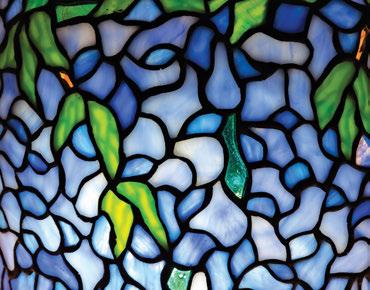

Oil on canvas, “Horseback Riders,” signed Edgar Payne (1883-1947), circa 1930, 16 by 20 inches.
N.Y. — EstateofMind Auctions will start its fall auction series off with a two-session, 940-lot auction beginning at 10 am on September 28 with militaria long guns, including a rare Sussex Brigade 69 cal. flintlock rifle, circa 1820/30, pistols, swords and daggers with a few Bowie knives from an estate of a long-time collector to be sold in its entirety.
The main sale will start at approximately 11:30 am with barn-find vehicles, including a 1985 Rolls Royce Silver Spur and a 1993 Jaquar XJS Roadster from the “Four Season’s Farm” along with the farm’s tractors and field equipment.
True barn finds will include a 1969 Alfa Romeo Spyder convertible, 1967 Triumph Vitesse convertible, 1969 Triumph GT6 Plus last registered 1984, 1975 Bricklin SV1, 1929 Oldsmobile coupe and a 1925 Buick sedan.
Artwork will be highlighted with fresh-to-the-market an oil on canvas “Riders on Horseback” signed Edgar Payne (1883-1947) consigned by the grandson of the family’s home where the painting has resided for the past 85/90 years and has never been offered for sale; an oil on canvas, “Sneeden’s Landing,” signed J. H., dated 1898, 24 by 36 inches; “The Brut,” oil painting signed Rob-


ert Loughlin (1949-2011); oil on canvas landscape with farm attributed to LeGrand Botsford, circa 1920, 10 by 18 inches, plus a number of works by Robert Wilson (b 1941).
A large group of photographs from the estate of Mstislav Dobujinsky, including photos of artwork and family images
from 1901-1970s will be offered. Stoneware and country collectibles will be represented from an estate in Sussex Co., N.J., with rare stoneware from Deckertown, Newton and Sussex, painted country furniture, pantry boxes, including Shaker, along with a collection of baskets.
A continuation of the sports collection from a Warwick, N.Y., Sports Digest writer will include more autographed magazine cuts and photos, signed baseballs and vintage sports cards from the 1950s/80s.
Also included will be a continuation of Native American artifacts, including arrowheads, rugs, pottery, axes, celts and implements; collectibles will consist of comics, including graded examples; large lots of figural Christmas ornaments, Victorian glassware, including Steuben, Hirata sterling tea service (950) weighing almost 29 pounds, sold as sets; and a pair of large Austrian silver game birds with ruby and emerald eyes, circa 1920.
Large groups of Art Deco gelatin silver photographs will cross the block, with many signed M.I. Boris (Boris Majdrakoff 1887-1962).
EstateofMind is at 195 Derby Road. For additional information, 845-386-4403.
NEW YORK CITY — This fall, the Grolier Club presents an exhibition commemorating the centenary of an American literary classic: Herman Melville’s novella Billy Budd (1924). On view in the Grolier Club’s second floor gallery through November 9, “Melville’s Billy Budd at 100” highlights the “prose and poem concoction” left unfinished on Melville’s desk at his death in 1891. Posthumously published in 1924, Billy Budd is the story of a young “Handsome Sailor” impressed into the British Navy during the Napoleonic Wars in the late Eighteenth Century, falsely accused of mutiny and hanged after a drumhead trial for striking and killing his accuser.
The exhibition is curated by Grolier Club member William Palmer Johnston from his extensive Melville Collection and features more than 50 items, including multiple scholarly editions of the Billy Budd manuscript, illustrations, photographs, dust jackets, movie posters, an opera libretto, playbills, a commemorative stamp, unique fine bindings for limited editions and original artwork by Barry Moser and Duke Riley.
“The exhibition highlights the progression of the composition, preservation, ‘discovery,’ and ongoing transmission
of Melville’s Billy Budd , a singular work of art,” said curator William Palmer Johnston.
“The challenging nature of Melville’s unfinished narrative compels us to join in the ongoing struggle to make sense out of the ambiguities and to find meaning in a world of fog and paradox.”
“Melville’s Billy Budd at 100” traces the century-long journey of the published novella, from editorial print and digital transcriptions of the unfinished manuscript leaves; to studies in book history, biography, textual scholarship and critical interpretations; as well as artistic adaptations for

illustrated editions, theater, opera and film.
On view are scholarly editions of the manuscript in five ground-breaking publications, beginning with the 1924 Constable first edition, titled Billy Budd, Foretopman. What Befell Him in the Year of the Great Mutiny, Etc. — a title Melville is now known to have discarded. Most recent is the 2019 Melville Electronic Library online “fluid text” edition, compiled through a nine-year scholarly analysis of the original manuscript leaves and Melville’s myriad revisions to explore the author’s creative process.
Many editions of the Billy Budd books on view have dust jackets illustrated with maritime imagery and ropes that foreshadow Billy’s fate, such as the curving ropes on the cover of the 1946 John Lehman edition and a dark noose hanging over a ship on the 1962 University of Chicago Press Phoenix paperback edition. Visitors can compare artist Duke Riley’s scrimshaw-inspired original study drawing for the cover of the 2016 Penguin Classics edition to the final book design, in which Riley added a noose in the foreground, replaced a rat with a dove and added a starry heavenly backdrop. Poetry was Melville’s prima-
ry literary focus in the last decades of his life and the novella concludes with the classic poem “Billy in the Darbies,” which Robert Penn Warren declares as “certainly Melville’s most nearly perfect poem.” On view in the exhibition are the signed typescript of W. H. Auden’s 1939 poem “Herman Melville,” which includes the lines “And we are introduced to Goodness every day … He has a name like Billy and is almost perfect,” as well as a broadside of the poem with artist Barry Moser’s illustrations of a condemned Billy with the shadow of a noose and of a sinking shroud.
The exhibition also features publicity posters from the 1962 Allied Artists’ film production of Billy Budd , starring Robert Ryan, Peter Ustinov and Terence Stamp as Billy in his screen debut, as well as the US postage stamp portrait of Herman Melville, issued in 1984 as part of the USPS Literary Arts Series, with an envelope including a scene from Billy Budd Following its run at the Grolier Club, the exhibition will travel to Oberlin College Libraries in Ohio from November 17 through December 20. The Grolier Club is at 47 East 60th Street. For information, www.grolierclub.org or 212-838-6690.
Despite the dreary drizzle taunting attendees as they lined up in front of the doors of Perkiomen Valley Middle School East, there were nothing but smiles and anticipatory conversations going on before the start of the Bedminster Traditional Artisan Show. In partnership with Historic Trappe — a non-profit with a mission to preserve and share historic places, landscapes and heritage of southeastern Pennsylvania — the show has moved to Collegeville, just down the street from Historic Trappe’s Center for Pennsylvania German Studies and Muhlenberg House; free tours of each were included with the price of admission.
Within the middle school’s gymnasium, with a few booths overflowing into the entrance hallway, The Bedminster Traditional Artisan Show hosted more than 40 of the country’s finest artisans working in traditional Americana and folk art. Offerings included furniture, paintings, quilts, hooked rugs, pottery, baskets and woodcarvings, among other handcrafted disciplines.
“Our museums have never been busier other than at Christmas!” exclaimed Lisa Minardi, executive director of Historic Trappe, in an email she sent Antiques and The Arts Weekly after the show’s conclusion. “Show admission included free entrance to our three museums, and nearly 50 percent of showgoers took advantage of this. It was wonderful to see so many people converge in the Trappe area for the show and I was just delighted with the results.”
Historic Trappe had its own display just past the ticketing booth in the main entrance hallway, advertising their museums
and selling plates by Selinda Kennedy (Kennedy Redware, Muncy, Penn., who had a booth in the show) ornaments, mug mats, notecards and lanterns by other local artisans. Also available were exhibition catalogs and other relevant literature about the art and culture of southeastern Pennsylvania.
Lynn Hazelton, Hooked by Lynn, Fairpoint, N.Y., was working on a commissioned hooked rug when we approached her booth. She paused what she was doing to explain, “This is a Tree of Life design, which I’ve done before in a different size. This woman [the commissioner] has bought other rugs from me, and she personally requested this piece for a thinner location, 39 inches tall and 49 inches wide. It’s been a challenge shrinking and narrowing the design!”
Hazelton beamed with excitement as she described her process, which takes about a month to complete for a rug that big. “I
hook every day,” she explained. Her favorite pieces in the booth were a series of vegetable designs she had hooked and hung in wooden frames crafted by her husband, which she assured, “can go in the most modern house.”
“I like this show because it’s all traditional; we lift each other up,” said Lisa Short, LT Short Folk Art, North Wales, Penn., a selftaught reproduction artist and on-and-off attendee of the Bedminster show who specializes in Pennsylvania German Fraktur. She was also enthusiastic about Antiques and The Arts Weekly; “I get ideas from your auction reviews!” she expressed. Short often looks to auction catalogs or show reviews from pulications like Antiques and The Arts and others for Fraktur pieces to replicate and put her own twist on. “I try to be as authentic and ‘antique’ as I can,” she explained. Her works are completed in pen, ink and watercolor, and she grains and paints all the wooden


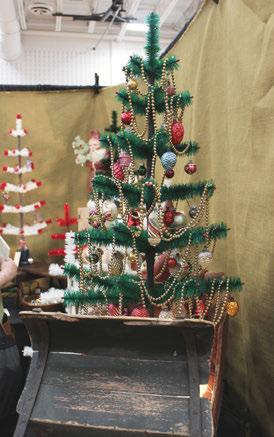
frames her artwork is housed in using a Pennsylvania German technique from the Eighteenth or early Nineteenth Century.
It felt like walking into an old country store entering the booth of Karen Wychock, Times Gone By, Warrington, Penn. She sat behind a mock storefront she’s had for 40 years crafting Moravian stars, which she sold for $10$12 in her booth; in between she spoke with interested customers, of which there were many. Wychock was also surrounded by
a multitude of Shaker-inspired baskets in every size imaginable, from miniature — her favorite to create — to large cheese baskets. She’s been crafting Shaker reproductions for 45 years and attending the Bedminster show for over a decade. “I was an art teacher, and I always loved weaving,” she explained, when we asked what inspired her artistic journey. “I eventually apprenticed with a New Hampshire basket weaver. I love both the woodworking and weaving aspect; I’m a natural.”
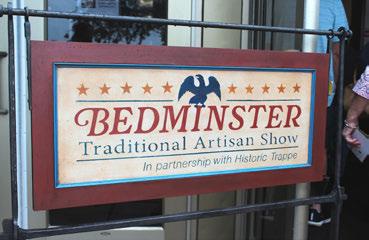



“I love the mermaids,” said Lisa Short, LT Short Folk Art, North Wales, Penn., about this pen, ink and watercolor mermaid Fraktur, which was based on an example sold by Pook & Pook for more than $10,000. “Mine’s maybe a bit more cutesy,” she joked of her reproduction.





We were transported to Christmastime in the booth of Donna DelCollo of Simply Olde, Lancaster, Penn. It was her first time at the show, where she offered feather trees, vintage Christmas primitives and other unique decorative items. “The trees come from goose biot feathers. You wrap them around a wire and [the feather] opens up,” DelCollo explained, demonstrating the technique with a small wire and feather. “It was started by Germans in the late 1800s, and then during President Roosevelt’s time
in office it went through a resurgence. It was the first artificial Christmas tree.” DelCollo didn’t just offer Christmas-themed trees, however. Also on display was what she coined as a “patriotic tree,” which was done in red and white feathers and was adorned with American themed ornaments.
Traditional goldsmith and silversmith, Jeffrey Jobe from Thomasville, N.C., specializes in hand forged and woven or braided metal; it takes him up to two and a half days to make his


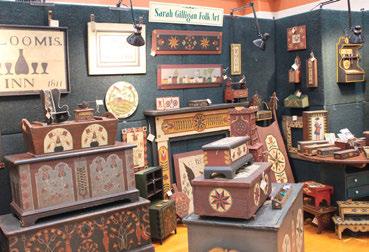
smallest chains. This was Jobe’s first Bedminster show, but he’s been doing shows for a few decades. He opened a studio for his business, Barking Dog, back in 1988, but even before that he’d been learning the trade. Jobe received an undergraduate degree in archaeology from the University of North Carolina Greensboro and went to graduate school, but didn’t finish. “While working on my degree, I was offered a chance to learn this. People thought I lost my ever-loving mind!” He joked when asked how he got his start. “I discovered I liked doing the art more than digging it up.”
What has kept Jackson Foster, J. Foster Historic Signs, Fredericksburg, Va., coming back to Bedminster for five years? “Oh, the pizza!” he joked. All jokes aside, Foster explained that it’s because “this is one of the few real artisan shows.” In front of each of his hand-painted signs was an explanation of its historical context; Foster said that he does extensive research before each piece he works on. Bigger signs — like his examples modeled after designs that allies of the Sons of Liberty would have made — are painted with a water-soluble oil paint and take him around a month to complete, combining both fabrication and painting skills. “My inspiration is the research I do,” Foster explained. “Even the lettering styles I use, I refer to printer manuals for. Most old lettering styles are from London, but many artisans were untrained, and did their own typestyles.”
Laurel Dabbs from Westfield Center, Ohio, was celebrating her first year at Bedminster, but she’s been carving and selling decoys and birds for 37 years under the name Laurel Dabbs Decoys and Folk Art. She has also been a subscriber to Antiques and The Arts Weekly for all but seven of those years. While she had many examples of ducks, herons and some flashy red cardinals, Dabbs shared that her favorite birds in the booth were a group of shorebirds, which she labeled “folky peep.” Dabbs learned the trade from a family who has been carving decoys for generations, which she expressed her gratitude for. When we asked her what got her interested in carving, she explained, “I just thought it was neat to make a product, start to finish, with only hand tools.” We were immediately drawn to the booth of Andrea Durnell, Andrea Durnell Folk Art, Baden, Penn., which was full of anthropomorphic animal dolls made from carved wood, oil paint and preserved Nineteenth Century fabrics. “The storytelling aspect is


Joe Hart (right), Vigilance Force, came all the way from Lexington, Va., for his sixth year at Bedminster. Here, he discusses his historic metalworking pieces, including gate chests and a mirror, with interested customers. All his work is done traditionally with an anvil.

the most important,” she explained happily, “The dolls are based on countries I’ve lived in and people I know… but I don’t tell them!” Durnell shared with us that the concept behind her dolls was based on Public and Private Life of Animals (1877, London: S. Low, Marston, Searle & Rivington), which features whimsical animal illustrations by French caricaturist J.J. Grandville. Each doll takes around 50 to 60 hours for her to complete, including hunting down materials and preparing with research.
“I don’t want them to become too cute,” Durnell added, “I want them to be a little more serious.”
“I paint, pick and press all of my own flowers, and I grow all of the flowers myself, mostly,” shared Lucille Norella, a pressed flower artist from Waymart, Penn., who operates under the name Art by Lucille Norella. Looking like a fresh spring garden, Norella’s booth was decorated head to toe with her pressed flower artwork, which included framed flowers, vases, jewelry and her newest challenge, pressed flower windowpanes. “I like the diversification of doing different things. The vases were the challenge, but I loved them. I love a challenge.” When asked what her favorite form of pressed flower artwork was, she explained that the windows took the cake; they were both popular and decorative.
One of the last booths we stopped at for the day was one of the first to examine after entering the show, and it had been bustling and busy all day. Cinnamon Treasures, Pine Grove, Penn., owned by Joe and Amy Winter, sold a vast array of handcarved beeswax sculptures, smalls and ornaments, along with candles, all made from locally sourced beeswax. While the business was founded in 1985, the Winters purchased it in 2020; they had been fans of the business and avid collectors of their work before the purchase. This was their second year in Bedminster, and Amy shared, “We have loved the interest in the historic piece of our business, the story behind how it’s made.” She also cited making connections with Historic Trappe and early American historical enthusiasts as a major advantage. When asked what her favorite pieces in the booth were, Amy pointed out “Max,” a Santa sculpture made from a vintage late 1700s window display chocolate mold, and a large running rabbit affectionately known as “Stu,” made from
a rare chocolate mold, one of only two known in the world.
“How did the show go? In a word — terrific!” Shared Minardi in a follow-up email after the conclusion of the show. “We had over 600 people attend — a 33 percent increase over last year. Many were long-time showgoers, but many were also new to the show. I also saw many younger folks, including families with children, in attendance… I saw so many packages heading out the door — from Windsor chairs to hooked rugs to feather trees to trade signs and everything in between. There was a reproduction Mahantongo Valley chest of drawers that sold early on Saturday. I spoke with many of the artisans throughout and at the end of the show, and they were all very pleased with both the attendance and the sales. Some reported having their best show ever or their best in a long while.”
A date has not yet been announced for the 2025 Bedminster Traditional Artisan Show. For more information, www.traditionalartisanshow.com.

A sgraffito jug depicting Cirrus, goddess of the harvest, by Erich and Janice Steinhagen, Steinhagen Pottery, Griswold, Conn. Erich has been a potter for more than 15 years, while Janice carves their pottery, influenced by a special Eighteenth Century redware technique of carving designs through a coating of slip.


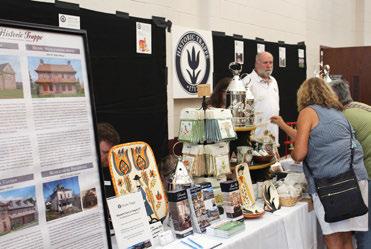
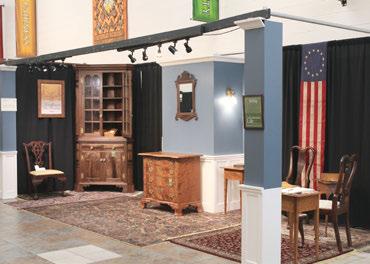
tried to create a house setting so people could visualize it,” explained Justin Kauffman, Kauffman Fine
Noblesville, Ind., about his booth’s display, which offered handmade Eighteenth Century formal furniture. It took him 300 hours to complete the corner cupboard (left corner).



On day one, this Western Apache basketry olla made around 1915 left its $5/7,000 in
W.A. Demers, Senior Editor



SANTA FE, N.M. — Two days of an annual auction extravaganza celebrated the Native American art market at Santa Fe Art Auction on August 13-14, timed to coincide with Santa Fe’s Indian Market, which features hundreds of artists showcasing a variety of art forms and taking up some 12 city blocks. Up for bidding at Santa Fe Art Auction were nearly 500 lots offering a wide selection for Native arts collectors, everything from traditional rugs and blankets, vintage jewelry, pottery from each of the great pueblos, basketry, Plains hide and beadwork, as well as sculpture and paintings from early Indian School to Twenty-First Century contemporary. This last category led the offerings as Fritz Scholder’s (Luiseño, 1937-2005) untitled (Chief), acrylic on paper, jumped its $5/7,000 presale estimate to command $13,530. According to Scholder’s official website (www.fritzscholder.com), his art broke all the conventions in redefining the representation of the “American Indian” in American art, throwing out the traditional, stereotypical images of the mythic Native with drawings and prints that feature bold, expressive lines, vibrant colors and potent imagery.
His work is included in the collections of more than 120 museums in the United States, including the National Museum of American Art in Washington, the Museum of Modern Art in New York and the Metropolitan Museum of Art in New York.
Totaling $593,000 and with a sell-through rate of 95 percent, the two-day sale delivered high marks for fine art, basketry, pottery, wearable textiles and a charming parliament of pottery owls (parliament being the collective term as ancient Greeks deemed owls to be very wise birds). As for the number of registered bidders, Gillian Blitch, the firm’s president and chief executive officer said, “It’s a difficult number to arrive at. They [the platforms] pre-register people, so the minute I open a sale up I already have 3,000 ‘registered’ bidders. We had 5,000 just on
Invaluable. Over a quarter of a million alerts went out and that’s just on Invaluable. More than 35 countries.” The number of invoices the auction house sent out was 225. Also, with folks in town for the Indian Market — both dealers and collectors — Blitch added, “We were very busy for the 10 days we had the exhibit up. Two showrooms and a huge number of visitors.”
A Western Apache basketry olla, made around 1915, surpassed its $5/7,000 estimate to finish at $12,300. According to the US Department of the Interior, the Western Apache — Cibecue, San Carlos, White Mountain and Northern and Southern Tonto — made many kinds of baskets, the largest of which was called an olla. This one, with a willow rod foundation and willow and martynia weft, was 27 inches high by 27 inches in diameter. These baskets were handcrafted for water storage and to hold seed and corn. It was determined that this large example was made for the trade, not for storage.
An untitled oil on canvas by Margarete Bagshaw (1964-2015) performed well, rising from its $3/5,000 estimate to leave the gallery at $9,840. An American artist whose paintings and pottery were Modernist in style, Bagshaw emerged in her right, having grown up the daughter and granddaughter of noted Native artists. “She’s from that remarkable dynasty, right?” Blitch observed. “From Pablita (Velarde) through Helen (Hardin) and then Margarete. Helen was a breakout artist, one of the earliest to break out of Dorothy Dunn’s Indian school painting to do something more abstracted and contemporary in their own mythology. And her daughter Margarete, as you can see, went much more abstracted than that.” This painting measured 23½ by 49-5/8 inches.
Another Fritz Scholder work, a monotype titled “Bunch of Flowers #2,” more than doubled its high estimate to take $9,840. The 41-by-31-inch work came from a private New York collection. “He [Scholder] did work with flow-

ers,” explained Blitch. “He famously did a series with roses and tulips. And he loved the art of printmaking. He really enjoyed it. I think when you know his work, it’s not that atypical.”
“Council Time” by Dolona Roberts (Cherokee, b 1936) depicted three figures dressed in colorful wearing blankets with their backs to the viewer. “We had several pieces by Dolona, and this one was particularly beautiful,” Blitch remarked. The 1997 acrylic on linen vaulted from its $1,5/2,500 estimate to a final price of $8,610.
“Ghost Rider,” John Nieto’s (1936-2018) luminescent green rider and horse figures in an acrylic on canvas from 2001, saw $3,690, beating its $1,5/2,500 estimate. “Strong and steady. We have several major works of his coming up in November,” said Blitch. “He’s from that period where the color was important, the representation of the Native American in a
different context that still told their story. His work continues to be very desirable.”
Fetching $6,765, twice its high estimate, was a Dine (Navajo) blanket, circa 1885. Woven with natural fibers and colored with indigo and aniline dyes, it measured 57-3/8 by 69½ inches.
And this auction review would be remiss not to include the sale’s pottery owls, as these also did very well. The first lot — six pottery owls by various artists circa 1940-75 — sold for $2,768.
“Remarkably,” according to Blitch, others, in lots of six, seven and eight, sold between $2,460 and $3,383. “They were all from the same collection and, though the auction house broke them up into groupings, they all sold together to another collector. They’ve always been a major collecting area here.”
The Zuni culture holds that the owl, known as the “Night Grandfather,” stands for wisdom, truth and the protection of

Twice its high estimate was obtained by a Dine (Navajo) blanket, circa 1885, which earned $6,765. It was woven with natural fibers, colored with indigo and aniline dyes.
the home. Wonder how many successful bidders have placed them where they can use their powers of observance, perception and their ability to see

This colorful 1997 acrylic on linen by Cherokee artist Dolona Roberts, “Council Time,” agreed to exceed its $1,5/2,500 estimate to attain $8,610.
things that others cannot.
Prices given include the buyer’s premium as stated by the auction house. The next sale, featuring contemporary art and photogra-
GENESEO, N.Y. — On September 20, Cottone Auctions will feature the collection of Dr Martin May of Plantation, Fla. A Brooklyn, N.Y., native, Dr May was described as a Renaissance man, orthopedic physician, businessman, author and an avid collector. Highlighting his collection are a wide array of rare leaded lamps and lighting by Duffner & Kimberly; Bigelow, Kennard & Co.; and Handel; art glass and art pottery by Tiffany Studios and Rookwood; Nineteenth Century oil lamp chandeliers and student lamps and a collection of R. J. Horner furniture.
Dr May’s collection of leaded lamps includes a rare Duffner & Kimberly Dragon lamp, circa 1906. One of four known examples and the first to appear at public auction, it is estimated at $50/80,000. Another highlight of his collection is a rare Aquarium lamp by Handel with a rippled glass shade ($20/30,000). A large chandelier from Bigelow, Kennard, & Co., a rare Cherry Blossom with three hanging satellite shades, circa 1910, is the only example known of its kind ($20/40,000). Suess Ornamental Glass Company is represented by a rare Grape Trellis shade on a large bronze base with a matching motif. There are only a few known examples ($20/30,000).
More lamps by Duffner & Kimberly in the sale feature designs such as Roman ($20/40,000); Louis XV ($25/35,000); and a Modern Floral design ($30/50,000). A Wisteria and Nasturtium floor lamp will also be included. Additional lamps include obverse and reverse painted lamps by Handel. Featured will be a rare enameled and acid-cutback Peacock floor lamp ($10/15,000), as well as several Scenic lamps (each $3/5,000).
Decorative arts and furniture include notable pieces by R. J. Horner & Co., and a monumental oak sideboard, circa 1880. Elabo-
Rare Duffner & Kimberly Dragon lamp. Circa 1906, leaded glass, patinaed bronze. One of four known. Collection of Dr Martin May, Plantation, Fla. ($50/80,000).
rately carved quarter-sawn oak, this piece features design motifs of atlas figures, griffins, cherubs, masks with foliate decoration throughout ($8/12,000). Dr May’s collection has many leaded glass windows by Lamb Studios, Cincinnati, Third Street Studios and Henry Belcher Mosaic Glass Company. Decorative art glass and art pottery by Tiffany Studios, Greuby, Handel, Weller Sicard, Quezal, Rookwood and Newcomb will cross the block. From the collection of paperweight vases is a large, circa 1912, Tiffany Studios blown favrile glass paperweight vase ($15/25,000).

On September 21, Cottone Auctions will offer two fresh-to-themarket oil paintings by the trailblazing woman artist Jane Peterson (1876-1965). The canvases depicting Gloucester, which descended in the family of the original owners were purchased circa 1912, by Willis O. Chapin, author and contributing member of the Buffalo Fine Arts Academy, Albright Art Gallery. The 24-by30-inch canvases each hold estimates of $50/80,000. Among the finest examples of Jane Peterson's work, “Gloucester” depicts one of the artist's most celebrated subjects with her signature brilliant palette and dynamic brushwork. The innovative stylistic elements are the fundamental characteristics of her style that garnered her critical acclaim. The works were both likely exhibited at the Memorial Art Gallery of Rochester, New York in 1917. Also offered is a portrait of George Washington by Rembrandt Peale (1778-1860), which became known as one of his “porthole paintings.” The canvas painted circa 1846 was once owned by the grandson of artist Thomas Sully and was later purchased by Colonel Charles Clifton of Pierce Arrow Motor Car in 1926 from M. Knoedler & Company. The untouched, 36-by30-inch canvas has an estimate of $200/400,000.
phy, is set for September 18. Following that will be the Signature sale on November 8-9. For additional information, 505-954-5858 or www.santafeartauction.com.

Rembrandt Peale (1778-1860) “George Washington,” circa 1846, oil on canvas, signed “Rembrandt Peale” lower left ($200/400,000).
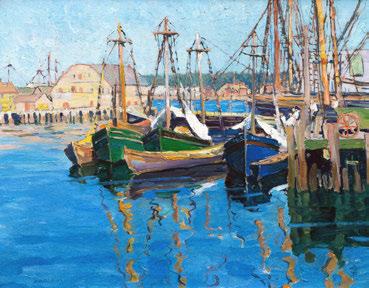
Jane Peterson (American, 1876-1965), “Gloucester Scene,” oil on canvas, signed “Jane Peterson” lower left ($50/80,000).
Lamps by Tiffany Studios include a Clematis table lamp with an 18-inch shade, excellent modeling, with confetti and streamer glass ($40/60,000). A Tiffany Studios Seven-Light Turtleback Tile Moorish chandelier with decorated pulled feather shades, circa 1905, is estimated
$75/125,000. A Peony lamp is featured ($50/80,000). Additional highlights include a 12-light Lily, 16-inch Daffodil, 16-inch Tulip and Nautilus table lamp. Rare accessories include a Tiffany Studios Fern mirror ($15/25,000) and a mosaic favrile glass Arrowheads jardiniere ($25/35,000).
Two leaded glass windows by Tiffany will also be featured, including “The Crusader,” made circa 1890, which was inspired by the 1460 painting by the Italian Renaissance painter Andrea Mantegna ($50/80,000).
Modern art includes an abstract mixed media on canvas, titled “CV-6” by postwar Italian artist Afro Afro Basaldella (1912-1976). Purchased by a private collector, in Buffalo, N.Y., from Catherine Viviano Gallery, the canvas measuring 22 by 32 inches and dated 1968 holds an estimate of $20/40,000. An oil on plastered paper board, titled “Guitar Player,” by Arnaldo Roche Rabell (Puerto Rican, 1955-2018) from the estate of David Beaty, Warren, Penn., at 53 by 52 inches, is valued $8/12,000. For information, 585-243-1000 or www.cottoneauctions.com.
WILLISTON, VT. — On August 16, Merrill’s Auctioneers & Appraisers conducted its 502-lot Americana & Fine Art Estate Auction. The sale
comprised an “outstanding” collection of fine art, historical ephemera and photographs, American and Continental furniture, jewelry, books and vari-
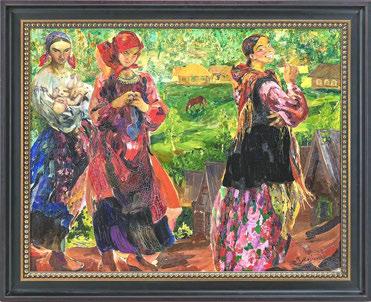
the auction was “Three

Selling to an international buyer for $3,150 was this early

ous other antiques from the estates of Hesterly Fearing Black (1933-2023) of Stowe, Vt., and others. “It was like anything we’ve been seeing, and the quality of the material really spoke for itself. There were some surprises and some good buys to be had; overall, the sale did very well,” Adam DeMasi, auctioneer and appraiser, shared of this sale.
At the apex was “Three Babas,” an oil on canvas painting by Philippe Andreevich Maliavin (Russian, 1869-1940), signed by the artist to the lower right. The three women in the work were depicted outdoors in a village, each wearing a long colorful dress and two with head scarves. DeMasi shared, “This was by a Russian expressionist, and was typical of his work. It had a few condition issues but had a lot going for it. The colors are spectacular, and it really shines and draws your eye from across the room when you see it in person. It’s such a vibrant scene and a really spectacular piece.” In a later frame,
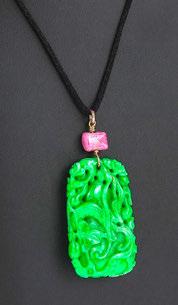
the painting had minor craquelure but was recently cleaned and stabilized and sold to a phone bidder for $88,200. Emphasizing the diversity in the sale’s offerings, the secondhighest earning lot was an archive of historical documents, letters and photographs belonging to Sarah Fisher Ames (1817-1901). Ames, a sculptor, served as a volunteer nurse during the American Civil War and was a friend of Abraham Lincoln. As such, many of the pieces in this lot relate to her roles; one, which DeMasi called “the most important,” was an 1865 letter from Lincoln to the surgeon general, permitting Ames “to go anywhere she can to minister to our wounded soldiers.” Several other letters referred to her bust of President Lincoln, which was placed in the Senate Chamber. Also included were photographs of Ames herself, family members, colleagues and other figures. The lot descended in her family and sold over the phone for $37,800.
A pair of Chinese cache pots from the Qianlong period dialed up to $11,340. DeMasi remarked, “Those were just stellar — very rare. To get one of them is something, but to have two pieces of 250-year-old porcelain survive together, in such good condition, for so long was really nice.” With famille rose characteristics, the pots were enamel decorated with images of colorful horses beside trees. The rectangular pots had pierced wooden lids with carved jade foo dog handles and were on wooden bases with scrolled feet; the undersides of the porcelain pots were marked with hand-brushed characters. Another Chinese piece, a vibrant, intricately carved jade pendant from the Qing dynasty, went to a phone bidder for $7,670. DeMasi noted that it was a “good, early piece of jade,” which led to its success. On the bail connecting the pendant to the simple black necklace was a small piece of pink tourmaline as an added accent. The jewelry category was also represented by a large, 10-carat yellow sapphire ring. The large oval center stone was surrounded by a halo of 14 round cut diamonds, all set on the 14K yellow gold size 6½ ring. A phone bidder took it

Sarah Fisher Ames’ Civil War era archive of documents, letters and photos descended through her family and was sold to a phone bidder for $37,800 ($10/20,000).

This 7-by-7¾-inch dated and signed “1968 Stanley M. Roop” oval Nantucket friendship basket purse had carved seagulls on the top and sold to an online buyer for $3,465 ($1/1,600).

20-inch drop-leaves ($400/800).

This 14K yellow gold ring was set with a 10-carat oval cut yellow sapphire, surrounded by 14 round cut diamonds that totaled about 2¼ carats. A phone bidder claimed it, just below estimate, for $3,835 ($4/6,000).
home for $3,835.
A dark, atmospheric river landscape painted by Clyde Leon Keller and housed in a wooden frame was bid almost six times its high estimate to $6,930 and was ultimately claimed by an online purchaser. The tonalist oil painting was signed and dated “Clyde Leon Keller – 1918” to the lower right of the image.
More surprises in the sale included a child’s swan ride-on rocking toy. The circa 1980 reproduction piece “was really good. It had a great look and [Merrill’s] had a number of people who really liked it,” observed DeMasi. After the wooden swan rocked its $300 high estimate, it went out to the prevailing online bidder for $6,900. An Eighteenth Century mahogany Chippendale drop-leaf table with ball and claw feet surpassed its $800 high estimate, selling to an online buyer for $5,355, and a pair of Nineteenth Century porcelain urns, estimated $200/300, was knocked down for the same price. The turquoise-colored French urns were decorated with gilt

This hotly contested circa 1980 reproduction child’s swan rocking toy, 32 by 48 inches, was knocked down by an online bidder for $6,900 ($200/300).

These Eighteenth Century Chinese Qianlong period famille rose enamel decorated porcelain cache pots were illustrated with horses and their wooden lids had carved jade foo dog handles. Each measured 9 inches high and they sold together for $11,340 ($8/12,000).
designs and had gilt bronze mounts, including cherub and serpent handles. DeMasi shared, “They descended in the Fearing Black family and got a lot of interest. It was our understanding they were from The Orchard.” George Fearing (1839-1920) was the owner of The Orchard, a Gilded Age
mansion in Newport, R.I.
A 1968 Nantucket friendship basket made by Stanley M. Roop had three carved seagulls affixed to the wooden top panel. DeMasi said that the oval swing-handled purse basket “did very well” and that Merrill’s was “very pleased.” It sold online for $3,465.

“The Bathers” by Charles Hebert Woodbury (American, 1864-1940), watercolor on paper, 27 by 31 inches framed, sold online for $4,095 ($1/2,000).
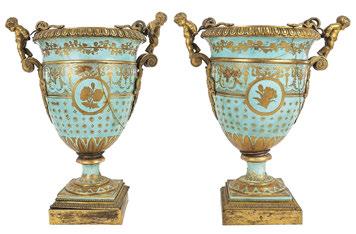
This pair of Nineteenth Century porcelain and gilt bronze garniture urns, 16 by 14 inches each, descended in the family of George Fearing and sold to an online bidder for $5,355 ($200/300).
An international buyer claimed an early Nineteenth Century French dressing screen for $3,150 — more than three times its high estimate. The four Rococo Revival screen panels were painted with illustrations of demure nude women and were in carved gilt frames. There were
some losses to the silk backing and upholstery, but the inner wool backing was intact, and the screen generated significant interest. Prices quoted include the buyer’s premium as reported by the auction house. For information, www.merrillsauction. com or 802-878-2625.
CATSKILL, N.Y. — The Thomas Cole National Historic Site is showing a new exhibition titled “Native Prospects: Indigeneity and Landscape,” curated by Scott Manning Stevens, PhD / Karoniaktatsie (Akwesasne Mohawk). The exhibition, which runs to October 27, juxtaposes an Indigenous approach to the articulation of their homelands and the environment with the American landscape paintings of Thomas Cole, which are rooted in European tradition. Cole’s influence led him to be recognized as founder of the Nineteenth Century American art movement now known as the Hudson River School of landscape painting.
The exhibition’s curator, Scott Manning Stevens, is associate professor of Native American studies and English at Syracuse University, where he is also director of the Native American and Indigenous studies program and founding director of the Center for Global Indigenous Cultures and Environmental Justice. The exhibition and the accompanying publication are organized by the Thomas Cole National Historic Site.
“Native Prospects: Indigeneity and Landscape” presents Nineteenth Century paintings by Thomas Cole featuring Native figures, in context with Indigenous works of historic and cul-
tural value, and artworks by contemporary Indigenous artists: Teresa Baker (Mandan/Hidatsa), Brandon Lazore (Onondaga, Snipe Clan), Truman T. Lowe (HoChunk), Alan Michelson (Mohawk member of the Six Nations of the Grand River) and Kay WalkingStick (Cherokee). Bringing the Nineteenth Century into conversation with our present moment, this cross-cultural exhibition offers profound interpretations of American art and land, expands conventional definitions of “land” and “landscape,” and highlights Indigenous artistic creation.
Much of the critique of Nineteenth Century American landscape painting has focused on the absence of communities of the original inhabitants of the land. Yet communities of Native peoples had lived throughout these regions for millennia, constructing villages and clearing woods for agricultural fields, as they supported their communities from the resources of the land and its waterways. Unlike most of his artistic circle, Thomas Cole included Native figures in many of his landscape paintings, though most often alone. Dr Stevens interprets these figures as what art historians refer to as “staffage.” In Cole’s case, these figures served to provide a sense of scale, geographic location and arguably time period. Scale

was often related to the sublime aspects of certain natural features such as a waterfall or mountain, while identifying a figure as Native American placed the viewer in an American locale, and finally, having a lone Native figure in
the landscape, dressed in a stereotypically Indigenous manner, pointed to the country’s past, with the implicit and harmful presumption that Native Americans were no longer present in this region.
Cole’s Native figures demonstrate no ethnographic acuity on the artist’s part, beyond romanticized stereotype. “Native Prospects” reflects this aspect of the landscape painting tradition while examining representations of land by Native peoples, both in the distant past and today. While Indigenous societies in North America did not have a tradition of representational landscape art, the land was featured abstractly as it related to Native communities in various designs, some decorative and others mnemonic. Contemporary Native visual artists have inherited a variety of legacies of representing the land, a fraught subject for many Native artists because of the dispossession of Indigenous peoples from the land and the peril facing the land historically and today. “Indigenous societies flourish when we recognize that our relationship to the land is as much determined by responsibilities as it is by rights,” said exhibition curator Stevens.
Thomas Cole National Historic Site is at 218 Spring Street. For information, 518-943-7465 or www.thomascole.org.
Compiled By Antiques and The Arts Weekly

ESSEX, UK — A lifetime private collection of Native American beadwork, amassed by one individual from auction houses, collectors and dealers in the UK, the US and Europe, comes for sale at Sworders. The collection will be offered for sale in almost 100 lots at the Essex, UK saleroom on September 10-11.
Beads of various types, including shells, seeds, bones and stones, have been used by Native American cultures since the beginning of time, however, it is with the introduction of Italian glass beads — traded with European settlers — that

A selection of beaded hide moccasins includes this fine pair from the Sioux, Pine Ridge Reservation decorated with geometric motifs in white, blue, red and yellow; it is estimated at £600/800 ($792-$1,057). Courtesy Sworders.
A 15-inch (41-centimeter) Cheyenne beaded and quilled hide doll decorated with multicoloured glass beads, stained porcupine quills and cowrie shells, is guided at £800£1,200 ($1,056/$1,585). Courtesy Sworders.
they really became a staple of their artistic identity.
The patterns and designs used in beadwork hold clues to their origin; for example, the Lake Indians favored flowered designs, while the Sioux or Plains Indians created repeating geometric patterns.
Forty years in the making, this assemblage is mostly made up of late Nineteenth and early Twentieth Century Northern Plains items including vests, moccasins, tent decorations, bags and ceremonial wear. The collection includes items from the Blackfoot, Plateau, Cree, Cheyenne, Nez Perce and Sioux
cultures among others. Highlights include a ‘bear claw’ necklace fashioned from otter fur and 23 pieces of carved bone or antler strung with Italian glass trade beads and a single piece of abalone shell. Similar examples in museum collections are attributed to the Meskwaki, Pawnee or Oto peoples. It has an estimate of £1/2,000 ($1,321/2,642).
A 15-inch (41-centimeter)
Cheyenne beaded and quilled hide doll decorated with multicolored glass beads, stained porcupine quills and cowrie shells, is guided at £800-£1,200 ($1,056/$1,585) while a Nez

A ‘bear claw’ necklace fashioned from otter fur and 23 pieces of carved bone or antler strung with Italian glass trade beads and a single piece of abalone shell. Similar examples in museum collections are attributed to the Meskwaki, Pawnee or Oto peoples. It is estimated to achieve £1/2,000 ($1,321/2,642). Courtesy Sworders.
Perce (Plateau) vest with a fully beaded front of flower head designs to a bright blue ground is expected to bring £500/700 ($660/925).
A selection of beaded hide moccasins includes a fine pair from the Sioux Pine Ridge Reservation decorated with geometric motifs in white, blue, red and yellow (£600/800 [$792-$1,057]) and those from the Santee Sioux decorated with a butterfly motif in polychrome tones (£200/400 [$264/528]).
A pair of Ojibwe (Woodlands) beaded hide mittens, expected

Nez Perce (Plateau) vest with a fully beaded front of flower head designs to a bright blue ground is expected to bring £500/700 ($660/925).Courtesy Sworders.
to bring £400-600 ($528/792) has an earlier provenance to the collection of James Hooper (1897-1971), a British tribal art enthusiast who began collecting in 1920s — and the author of the influential book The Art of Primitive Peoples (Fountain Press, 1953), his large holdings were sold at Christie’s in 1976 and 1977. This collection will be offered during Sworders’ Fine Interiors auction, conducted in-person and online. Viewing times are September 6 from 10 am to 4 pm, September 8 from 10 am to 1 pm and September 9 from 10 am to 4 pm.
The Sworders Essex saleroom is at GES and Sons Limited, Cambridge Road, Stansted Mountfitchet. For information, www. sworder.co.uk.
LONDON — This spring, the National Gallery displayed the last painting by Michelangelo Merisi da Caravaggio (1571-1610), not seen in the UK for nearly 20 years
“The Last Caravaggio” (April 18-July 21, 2024), presented “The Martyrdom of Saint Ursula” (1610), generously lent by the Intesa Sanpaolo Collection (Gallerie d’Italia – Naples) displayed alongside another late work by the Italian artist from the National Gallery Collection, “Salome receives the Head of John the Baptist” (about 1609-10).
The free exhibition, the first of NG200 — the National Gallery Bicentenary year — received a total of 286,298 visitors over 95 days. That is an average of 3,014 visits per day.
This makes it the tenth most visited exhibition in National Gallery history both
in terms of total attendance, and average daily attendance. The exhibition, which pre-
sented an opportunity to explore Caravaggio’s late paintings, and the represen -

tation of violence in his work, similarly engaged online audiences. The total reach for the exhibition content on social media was 1.8 million and the total views for the “Artists on Artists” film was 746,000.
The exhibition was also deemed a success by art critics: “Rage, slaughter, death, regret … ‘The Martyrdom of Saint Ursula,’ believed to be Caravaggio’s last work, is so astonishing, it deserves to be a one-painting blockbuster” –Jonathan Jones, The Guardian (April 17).
National Gallery Director, Dr Gabriele Finaldi, said, “Among the great masters of the past Caravaggio exercises a mesmerizing attraction on contemporary audiences. A rare opportunity to see the work, Caravaggio’s own powerful storytelling and the engaging narrative around ‘The Martyrdom of Saint
Ursula’ as the artist’s last painting made just weeks before his early death, help explain the success of the National Gallery’s exhibition.”
The National Gallery, is now looking forward to bringing more people and paintings together throughout the NG200 celebrations and we hope that they will come and enjoy our forthcoming Bicentenary exhibitions: “Hockney and Piero: A Longer Look” (August 8-October 27), “Van Gogh: Poets and Lovers” (September 14-January 19), “Discover Constable and The Hay Wain” (October 17-February 2), “Parmigianino: The Vision of Saint Jerome” (December 5-March 9) and “Siena: The Rise of Painting 1300 – 1350” (March 8-June 22).
The National Gallery is at Trafalgar Square. For information, www.nationalgallery. org.uk.
COPENHAGEN — The National Gallery of Denmark’s (SMK) exhibition “Against All Odds – Historical Women and New Algorithms” unfolds the stories of 24 Nordic women artists who achieved great success in the years 1870-1910, but have since more or less disappeared from history. The exhibition, on view through December 8, explores how we can reinscribe women artists in art history and whether new technology can be used to write history in completely new ways.
The woodcut “Evening” was created by the Danish artist Henriette Hahn-Brinkmann (1862-1934). Depicting fellow artist Niels Hansen Jacobsen, it is a rare example of a friendship portrait (known as Freundschaftsbilder) where a woman portrays a man. Like most women of her time, Hahn-Brinkmann faced great difficulty in gaining access to artistic education; yet she nevertheless achieved great success as an artist. She settled in Hamburg and went on to participate in numerous exhibitions — including the Exposition Universelle in Paris in 1900, where she received a silver medal, one of several prestigious accolades bestowed upon her.
After her death, she was quickly forgotten and, like many other prominent women artists from the late 1800s, was soon written out of art history. But what happened? And how might these artists be restored to a place in art history?
The 24 women artists featured in “Against All Odds” all had one thing in common: they left their Nordic home countries to pursue their artistic ambitions abroad in places such as Germany, Italy, France and Greece. There, they met other women in the same situation, forming networks that cut across national borders. The international networks became a crucial source of support for them in the face of a lack of recognition from institutions in their homelands — a cosmopolitan alternative to the national scenes at a time when women had limited opportunities. Access to education and work was limited, the Nordic art academies were reserved for men and exhibition opportunities were scarce.
Women’s struggle for basic and legal rights gained a prominent place in the public eye. However, the openness, the free and frank debate and the international outlook of the time soon became mixed with conservatism and misogyny. From around 1900, disdain for the
DUBLIN — A new exhibition, “In Real Life,” has opened at the National Gallery of Ireland. This exhibition, located in the Print Gallery, offers visitors a chance to explore the beauty and fragility of nature through a unique collection of drawings and paintings. Many of these works are seldom displayed and are presented alongside pieces on loan from contemporary Irish artists. “In Real Life” explores themes such as how nature inspires artists, sustainability and the critical role of art in drawing attention to environmental threats. The exhibition will feature 50 works spanning the seventeenth to the Twenty-First Centuries, including closely observed studies, idealized landscapes, topographical views and poetic interpretations.
Basil Blackshaw’s “Landscape with Trees” (1951) captures the rural landscape of County Down with lively pen and ink, demonstrating his early fascination with landscapes. Paula Pohli’s “The Magpie” (2017) is a meticulous portrait in egg tempera. The image captures a familiar bird with its characteristic pose and watchful demeanor. William Evans of Eton’s “Delphi” (1838) offers a dramatic watercolor

women’s movement grew throughout the Western world and also embedded itself in the art scene. The association between the notion of the ‘new woman’ and the idea of a general slide into moral dissolution also took hold in the Nordic countries. The research underpinning the exhibition shows that women were systematically written out of history throughout the early twentieth century due to the resistance towards women’s liberation. Thus, the 24 artists featured in the exhibition achieved success in their own time against all odds.
“In recent years, art museums around the world have launched exhibitions that shed light on unknown and forgotten women artists. But this is the first time the story of the women who traveled out into the world is told through a comprehensive presentation of Nordic art from the period. With this exhibition, we are actively rethinking their place in history. Instead of trying to reinscribe them into the history that erased them, we are asking whether we can imagine completely different ways of writing history. In the exhibition, we explore, among other things, how new technology can be used to expand and challenge our ways of understanding, remembering, archiving and canonizing things,” said Emilie Boe Bierlich, the main curator of the exhibition.
The exhibition presents two digital installations based on generative technologies. The installations use the artworks featured in the exhibition, the women’s biographies, surviving archival material and many years of research as data sets to tell the collective story of the women.
One of the greatest digital artists of our time, Itzel Yard (b 1990), also known as Ix Shells, has developed a new work specifically for the exhibition: a generative, immersive installation based on data about the historical women artists — their journeys, their relationships as well as colors and details from their works. This data is transformed into abstract, geometric shapes that slowly move across the walls enclosing the audience. In parts of the installation, a sensor registers the audience’s movements and reflects them in the artwork’s visualizations of the historical women artists’ journeys. With this work, Ix Shells strives to unite the historical with the digital in a physical, ambient and sensory experience.
The exhibition also offers the opportunity to have a conversation with a digital avatar of the renowned sculptor Anne Marie Carl-Nielsen (1863-1945). This is facilitated by a chatbot developed in collaboration with the Department of Mathematics and Computer Science at the Technical University of Denmark (DTU). Unlike ChatGPT, which generates responses based on vast amounts of data, this chatbot is specially trained on a curated data set consisting of historical sources such as letters, diaries and recent research on Anne Marie Carl-Nielsen’s life and work. The chatbot is being tested for the first time ever at SMK, exploring its potential as a tool for presenting and creating an overview of an extensive body of archival material and finding new ways into it.
“In light of the revolutionary potential of AI technology, it is interesting to investigate how we can apply algorithmic cultures to an art historical context in order to expand and challenge our collective experiences. The exhibition is a snapshot of how we work with and experience artificial intelligence and algorithms in the art world right now. Every generation creates and rewrites history. It’s the way we do it that changes,” said Emilie Boe Bierlich.
Statens Museum for Kunst is at Sølvgade 48-50. For information, www.smk.dk/en.
depiction of the rapidly changing weather of Ireland’s west coast, a scene sketched during his travels in Connemara. Fiona McDonald’s “In Search of a Blanket Bog” (2022) uses custom-designed algorithms to generate coded drawings from environmental data, highlighting human impact on landscapes while offering hope for ecological restoration. This exhibition reflects each artist’s connection with nature and highlights the evolving dialogue between art and the environment.
Works from the Gallery’s permanent collection by artists such as Aelbert Cuyp, Barbara Rae, Michael Wann and Emil Nolde are complemented by recent works on loan from contemporary Irish artists Angie Shanahan (b 1961), David Lunney (b 1988), Fiona McDonald (b 1969) and Bridget Flannery (19592024). These works highlight how art reflects the natural world and the urgency for environmental conservation.
Inspired by the fragility and vulnerability of the natural world, the Gallery has made a conscious effort to ensure that this exhibition will be as sustainable as possible. All materials used are recyclable, reusable or
biodegradable. Paper-based board and recyclable PVC-free vinyl has also been used for signage.
Dr Caroline Campbell, director of the National Gallery of Ireland, said: “‘In Real Life’ explores the connection between nature and art, inviting visitors to step away from daily life, and immerse themselves in the beauty of the natural world, through the eyes of the artist. ‘In Real Life’ celebrates the inspiration that nature provides to artists, from Aelbert Cuyp’s meticulous studies to Fiona McDonald’s contemporary digital drawings. It highlights how artists, past and present, continue to draw upon nature to create reflective and forward-thinking works.”
Anne Hodge, curator of prints and drawings at the National Gallery of Ireland, said: “Artists always look closely at the world around them — it is, in a sense, their job. For many, nature is a primary inspiration, deeply influencing their work. Whether it’s a specific landscape, a tree or a flower, these natural elements often spark a unique creative process. Through a combination of observation, imagination and skill, artists translate the wonder of nature onto paper, reminding

us of the beauty of the natural environment.”
Hodge continued, “The immediacy of drawing allows artists to capture changing shapes, colors and light quickly, in any location — from a mountainside to a shoreline. This exhibition highlights the enduring connection between artists and the natural world, emphasizing how art reveals the fragility of nature and the need for conservation.”
“In Real Life” runs at the National Gallery of Ireland until November 24. Throughout the
exhibition, there will be accessible and inclusive public programming. The program includes free public tours and an online introductory talk from the curator, with closed captioning and interpretation for Irish Sign Language users. There will also be family workshops, sketching tours and Drawing the Collection sessions led by contemporary artists.
The National Gallery of Ireland is at Merrion Square West. For information, www.nationalgallery.ie.

Lighting up to $17,400 was this desk lamp with a Tiffany Favrile shade on a Handel base, 18 by 8 inches ($500-$1,000).
CLARENCE, N.Y. — On August 16 and 17, Schultz Auctioneers presented 911 lots from the estates of Richard Byrne and other collectors. Major collecting categories on the first day included Victorian furniture, silver, jewelry, coins, lighting, porcelain, fine and decorative arts and Oriental rugs. The second day comprised ephemera, toys, sports memorabilia, advertising, militaria and other collectibles. The auction had a 94 percent sell-through rate and approximately 3,375 bidders across the two days. Rising up from a $3/5,000 estimate to achieve $415,000, the sale’s highest price, was “Adoration of the Magi.” This Fifteenth or Sixteenth Century Flemish school oil on oak panel painting was attributed to Hieronymus Bosch and depicted the Christian Nativity scene where several visitors are paying their respects to baby Jesus and his mother. The panel had previously been in a local private collection for more than

Smashing its $3/5,000 estimate and achieving the highest price overall was “Adoration of the Magi,” an oil on oak panel attributed to Hieronymus Bosch (1450-1516). Measuring 42 inches high by 30 inches wide and 2 inches thick, the painted panel sold for $415,000.

$11,400 was
100 years. Ben Schultz, co-owner and auctioneer, shared, “The painting was the highlight of the sale. We knew it had potential to take off, but there was really no way of knowing for sure how high it would go. There was definitely interest in the weeks leading up to the sale, but we never anticipated it doing this well.”
Among large wooden furniture and other decorative pieces, fine art was not a priority in this sale. However, another religious Flemish school oil on panel, this one depicting “Madonna and Child,” brought $6,300 ($2/3,000). The Fifteenth or Sixteenth Century work was approximately 23 by 17 inches and was in a carved, arched wooden frame with a smaller half-moon painting in the arch. Schultz added, “Any time you get Flemish school paintings it’s impressive, given the age of them — that piece is at least 500 years old. The market for Flemish school works isn’t that large, but it is obviously a scarce

This orchestrion player piano was put together within the last 50 years and was in the style of Cremona/Marquette Piano Co., with a Cunnigham Piano Co., soundboard; it was 80 inches high by 60 inches wide by 28 inches deep and sold with 12 Cremona music rolls for $9,300 ($3/5,000).

piece — not a lot of that stuff survived the past 500 years — so the interested bidders were out for it. Both Flemish school works were exceptional pieces.”
Doubling its high estimate to achieve $6,000 was a signed oil on board painting by Frank Penfold (American, 1849-1921).
The 1886 painting depicted four young children playing with toy boats in the shallow water of a harbor, and it measured 39 by 30 inches framed ($2/3,000).
Leading the decorative arts category was a Tiffany and Handel lamp. The iridescent, ribbed glass shade was signed “L.C.T. Favrile” on the inside, identifying Louis Comfort Tiffany’s proprietary glass style. The dome shade was paired with a bronze harp desk lamp, etched “Handel” at the base.
Exceeding its $500-$1,000 estimate, the combination of pieces from two leaders in late Nineteenth and early Twentieth Century decorative lighting brought $17,400.
“There was a lot of good quality Victorian furniture offered. As a whole, Victorian furniture is kind of a soft market right now, but the quality we had in this sale was exceptional and it was a sign that no matter the market, the best of the best is
always going to be good,” said Schultz.
An exceptional Renaissance Revival-style walnut and burl bed and dresser attributed to Thomas Brooks was bid past its $5,000 high estimate to earn $16,800. The bedroom set included a 9-foot-tall dresser, with a marble top and tall arched mirror, and a matching bed with headboard, footboard and side rails.
Furniture also included a Herter Brothers credenza.
Extensively inlaid and carved, the Renaissance revival piece had a large floral design on its central door panel, and each of the three doors opened to reveal three adjustable shelf compartments. It more than doubled its high estimate to realize $10,800. Yet another Renaissance Revival piece, a walnut and burl bookcase with a double-door central case and two side units brought $6,600. All four doors had arched glass windows, and there was a pull-out drawer beneath each section.
A Napoleonic chess set and table with stools made $10,500. The decorative bronze table had a highly sculpted apron and legs with protruding cannons beneath its marble chessboard top. The chess pieces were also
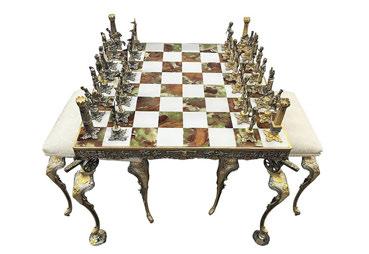
This intricately detailed Napoleonic chess set with a marble and bronze table had matching stools and the chess pieces were bronze with silver and 24K gold overlay. The winning bidder checkmated the competition at $10,500 ($1,5/2,500).

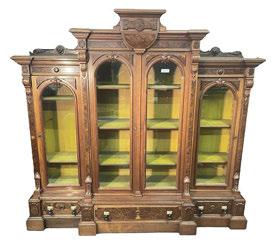


A 35-inch-long Hillerich & Bradsby Co., Louisville
swung to $6,300 ($5/8,000).
bronze, though they had silver and 24K gold overlay details. According to Schultz, “The chess set was made by an Italian designer, and a local couple bought it from a gallery in New York City in the early 90s. It was top of the line. You don’t see things like that every day, so something like that is going to bring a premium. It was made with exceptional attention to detail and amazing quality. It speaks for itself.”
Music instruments and players found favor with bidders, led by an orchestrion player piano in the style of Cremona. Marked on the fallboard “Cremona Marquette Piano, Chicago U.S.A.,” the instrument had a Cunningham Piano Co., soundboard and was assembled within the last 50 years, according to the auction catalog. The orchestrion played drums, cymbals, tambourine, xylophone and organ pipes. With 12 Cremona music rolls, each with 10
songs, to choose from, the player was coin-operated but was bid to $9,300.
Several large antique Persian rugs achieved above-estimate prices. Leading this category was a palace-size Bidjar rug. With a red-dominant main border, the center of the rug featured an all-over repeating medallion pattern with varying shades of blues, reds, yellow and cream; it made $11,400. A circa 1910 Mahal rug, slightly larger, measuring 33 feet 1 inch by 13 feet 3 inches, surpassed its $3/5,000 estimate range to achieve $11,100. This one had a wide medallion border with cream ground and a blue, red and cream repeating center pattern.
Wearable antiques included circa 1920s diamond pieces. A three-carat platinum and diamond ring made $10,800, and a Tiffany & Co., platinum and diamond wristwatch went out at the same price.
On the sale’s second day, sporting memorabilia and other collectibles had their chance to shine. As Schultz said, “Sports collectibles are hot right now. Just because you don’t have a painting that will bring six figures doesn’t mean your items are not valuable.” The top lot of day two was a Louisville Slugger baseball bat engraved with the signature and 1961 homerun statistics of Mickey Mantle and Roger Maris. Both players had signed the bat, beneath their carved names, in blue ink. The blonde wooden bat was sold with a certificate verifying the signatures from James Spence Authentication, LLC, for $6,300.
Other highlights from day two included a nearly complete set of 1956 Topps baseball cards. The catalog mentioned that “all key cards [were] included.” The set, housed in a binder with plastic sheets,

Deaccessed from the Memorial Art Gallery in Rochester, N.Y., this racehorse & jockey weathervane, 14 by 29 inches, found a new buyer for $1,500 ($100/200).
made $4,500 ($2/4,000). A red and white Manco Corvettestyle go-kart, approximately 80 inches long, raced to a new home for $3,000 ($300/500). A racehorse and jockey weathervane lapped its $100/200 estimate range to achieve $1,500. Prices quoted include the buyer’s premium as reported by the auction house. For information, www.schultzauctioneers.net or 716-407-3125.
AMHERST, MASS. — This fall, a special exhibition at The Eric Carle Museum of Picture Book Art explores a collaborative partnership built on mutual respect, trust, and a shared commitment to creating the best possible work. On view through March 9, “Artful Collaboration: Eric Carle & Ann Beneduce” explores the 50-year professional relationship between the beloved picture book artist and author Eric Carle (19292021) and the legendary picture book editor Ann Beneduce (1918-2021).
The exhibition includes never-beforeexhibited art, correspondence, and photographs from Carle and Beneduce’s work together on iconic books such as 1, 2, 3, to the Zoo (1968) and The Very Hungry Caterpillar (1969), to their final collaboration The Nonsense Show (2015). The two worked together throughout Carle’s entire career, with Carle following Beneduce as she moved to different publishing houses and continuing to collaborate even after her retirement.
“A special relationship between author and editor is crucial to the success of a book,” said Carle. “Ann’s and my…working relationship…operates on the same wavelength and is marked by deep mutual respect and affection.”
The exhibition traces the duo’s relationship through five decades in the publishing industry. At a time when women were often genre-bound to cookbooks, mysteries, and children’s books, Beneduce started her

career at Doubleday, Lippincott and then World Publishing, where she rose to lead the children’s book department. In the early 1960s she met Carle, who was working as an advertising art director and freelance illustrator. “It was clear to me at once that an enormously talented artist had burst upon the children’s book scene,” said Beneduce.
On view are some of the duo’s earliest work together, including 1987 re-illustrations for 1, 2, 3 to the Zoo (1968), the first picture book that Carle both wrote and
illustrated. Less confident in his skills as an author, Beneduce encouraged Carle to try his hand at both story and illustration. When Carle first presented The Very Hungry Caterpillar (1969) to Beneduce as “Willi the Worm,” she suggested changing the character to one with a more dramatic journey — at her mention of “Caterpillar?,” Carle exclaimed “Butterfly!”
When they worked on a book, Carle and Beneduce traded notes, sketches, and letters, many of which are on view in the exhibition. Every time Carle told Beneduce that this was his “last book,” she just chuckled. On view are original illustrations from The Nonsense Show (2015), the last book Carle authored and illustrated on his own with Beneduce as consulting editor, including a yellow rubber duck with human feet. The book’s humorous tone and imagery capture the pair’s contagious enthusiasm.
Also on view are examples of Carle’s abstract artworks, which he created as personal gifts for family and friends, including Beneduce. These works often demonstrate Carle’s technical ability beyond representative illustration. Some collages showcasing Carle’s “love affair with color” include “For Anne” [sic] (1997) with bold blocks of handpainted patterned tissue paper, and a playful personalized work from 2015 that depicts Beneduce dressed as a butterfly.
The Eric Carle Museum of Picture Book Art is at 125 West Bay Road. For information, www.carlemuseum.org or 413-559-6300.

— Barridoff’s summer 2024 International Fine Art Sale took place on the Barridoff lawn on August 17. The signature event featured the works of great artists like Ansel Adams, William Trost Richards, Katherine Bradford, Stephen Etnier and Wolf Kahn, among many others. The sale’s
total was $660,504 and the sell-through rate was 85 percent. There were a total of 3,322 registered bidders across four online platforms — Barridoff.com, Bidsquare, Invaluable and LiveAuctioneers — as well as in person, telephone and absentee.
Ansel Adams (American, 1902-1984) prevailed to take



top lot status. His "Mount Williamson from Manzonar," a gelatin silver print from a private Maine collection, sold to a private phone bidder for $30,500. Framed under glass and signed in pencil on the lower right of the mount, titled in pen and with an artist's stamp on mount verso, it measured 24-7/8 by 28-3/16 inches in its frame.
American artist Jon Imber (1950-2014) also rocked the sale with a framed oil on panel titled “View of Grog Island,” an islet in Downeast, Maine. Possibly a fan of either the artist or the waterfront property, a private online bidder purchased it for $28,060, a significant premium over its $2,5/3,500 estimate. It created one of the surprises in the sale. From a private collection in Cumberland Foreside, Maine, the work was signed lower right, titled, dated and
affixed with a Greenhut Galleries label verso.
Boston School painters of the early Twentieth Century counted Gertrude Horsford Fiske (1879–1961) in their circle. Besides capturing women in traditional scenes, Fiske was also adept as seen in “Tubat’s Creek,” a Kennebunkport getaway. The framed oil on canvas, 30¼ by 37 inches, was bid within-estimate to $25,620. The painting was signed with collector’s labels on backing verso, suggesting an interesting as it passed from the estate of the artist to the Tom Veilleux Gallery to a private collection in Michigan to Barridoff Galleries in 2020 and then to a private collection in Vermont.
An oil on canvas by Russell Cheney (American, 1881-1945) performed well, earning $21,960, more than twice its high estimate. Titled “Les Enfants Pendus (The Hung-Up Children),” the 1927-28 painting depicted three gentlemen in a parlor discussing the fine points of fencing. The large painting (65-3/16 by 77-1/8 inches) was signed and bore

the artist’s insignia on the lower right.
“Crashing Surf” by William Trost Richards (American, 1833-1905) hit $19,520, rolling slightly over its high estimate. The framed oil on canvas was signed and dated lower right and measured 33½ by 28-5/8 inches. In 1988, it was sold by Sotheby’s and entered a private collection in Maine. Another Richards seascape followed in its wake, also realizing $19,520. This one, a 1900 oil on panel laid to panel, had provenance to a Portsmouth, N.H., purchase, a private Barrington, N.H., collection, the Carolyn S. Bedford revocable trust and a private collection in Maine. It measured 20-3/8 by 27-7/16 inches in its frame. This sale included an interesting canvas by Neil Welliver (American, 1929-2005). The unframed oil on canvas depicted a picnic scene with a fully dressed gentleman and two nude models. Titled “Nudes on the Grass, the oil on canvas, signed lower right and measuring 75¼ by 76-1/8 inches, found a buyer at $13,420. Its provenance was equally inter-



American artist Jon Imber’s framed oil on panel, “View of Grog Island,” depicting an islet in Downeast, Maine, drew a clear-eyed price of $28,060, a significant premium over its $2,5/3,500 estimate. It was from a private collection in Cumberland Foreside, Maine.
esting with the work going from Yasuyo Kawasaki, wife of the male subject, and a private Belfast, Maine, collection.
With typical embellishments of distant hot air balloons and a bare chested mermaid, Ralph Eugene Cahoon, Jr’s (American, 1910-1982) “Hong Kong, Three Miles” takes the viewer to an unfamiliar locale with a mermaid rickshaw driver transporting a wealthy Western gentleman toward Hong Kong, as the sign indicated was three miles away. A ship flying the American flag was seen in the distant harbor. The 16-by-20-inch oil on Masonite painting was signed lower right and took $13,420.
Fetching $12,200 was “Woman in a Frothy Dress,” a framed oil on canvas by Irving Ramsay Wiles (American, 1861-1948) showing a lady with upswept hair in décolletage side view. Signed upper right, it measured 17-1/8 by 15-1/8 inches and had provenance to a California collection. This was the sale’s second big surprise.
George Hawley Hallowell (American 1871-1926) was a Boston-born artist who spent his professional life there and studied drawing and art history at Harvard. He also attended the School of the Museum of Fine Arts (Boston) and studied there for three years with Edmund C. Tarbell and Frank W. Benson. His “Grand Pitch,” a framed oil on canvas depicting a wild and spectacular section of the East Branch of the Penobscot River in Maine, was bid to $10,370. It was signed lower right and bore a Vose Galleries label for the “Memorial Exhibition of Works by George Hallowell.” On the verso was a St Botolph Club label verso. This work by Hallowell measured 33 by 39¾ inches.
American artist Hamilton Easter Field (1873-1922) was represented in the sale by “Moonlight on Chase’s Pond,” a serene nightscape of a portion of the 135-acre lake located in scenic York County, Maine. With collector's label verso, the 15½-by-19½-inch painting went out at $10,370.
A Pablo Picasso (Spanish, 1881-1973) ceramic, “Visage d'homme” (1953), sold for $10,370. On its underside it bore the Madoura Plein Feu



Hallowell’s
depicting a
and spectacular
and Edition Picasso stamps, and it measured approximately 15¼ by 12-3/8 by 1½ inches.
A Maine landscape, “Port Clyde: (Harbor at Low Tide)” (2001), was evoked by American Twentieth and TwentyFirst Century artist Joel Babb. The oil on canvas left the gallery at $10,370. Laid to panel and measuring 15-1/8 by 29-1/8-inches, the painting was signed lower left by Babb with an exhibition label inscribed “Intimate Wilderness: Maine Landscapes” on the back. Provenance listed the collection of Bob and Jackie Laskoff and a private Vermont collection.
Finally, the Maine icon Mount Katahdin looms in James Fitzgerald’s (American, 1899-1971), “Morning, Katahdin,” circa 1960, rendered in watercolor and Chinese ink with charcoal on paper. Signed lower left and framed under glass, the 27-7/16-by-32-7/16inch painting brought $10,370. Included in the James Fitzgerald Legacy catalogue raisonné, provenance listed the estate of the artist by descent, Anne M. & Edgar F. Hubert, and a private collection in Massachusetts.
Prices given include the buyer’s premium as stated by the auction house. Barridoff’s next sale, on October 13, will be a collaborative sale with Vose Galleries and will be conducted at the Lenox Hotel in Boston. For information, 207-772-5011 or www.barridoff.com.


Fiske eschewed depicting a glitzy locale in
nebunkport, choosing instead workaday “Tubat’s
which sold within-estimate for $25,620.



“View on the Stour near Dedham” by John Constable (British, 1776–1837), 1822, oil on canvas, 51 by 74 inches. The Huntington Library, Art Museum, and Botanical Gardens.

“Iron Works of Coalbrook Dale” in The Romantic and Picturesque Scenery of England and Wales, by Philippe Jacques de Loutherbourg (French‐British, 1740–1812), 1805, aquatint in printed book, 15¾ by 11-3/8 inches. The Huntington Library, Art Museum, and Botanical Gardens.
BY JESSICA SKWIRE ROUTHIER SAN MARINO, CALIF. —
Recent years have witnessed a trend of museum exhibitions that examine intersections between Anglo American art and the ecological sciences, including “Nature’s Nation” at the Princeton University Art Museum (2018-19) and “Alexander von
Humboldt and the United States” at the Smithsonian American Art Museum (2020-21). “Storm Cloud: Picturing the Origins of Our Climate Crisis” builds on those earlier efforts in part by broadening the material to include visual culture of all varieties and expanding the geographical scope from London to Jamaica to Los Ange-

“Cloud Study: Ice Clouds over Coniston” by Arthur Severn (British, 1842–1931) after John Ruskin (British, 1819–1900), 1884, bodycolor on buff paper, 5 by 6¾ inches. ©The Ruskin, Lancaster University.

les. Organized by The Huntington Library, Art Museum, and Botanical Gardens in San Marino, Calif., in conjunction with the J. Paul Getty Museum’s regional initiative “Pacific Standard Time (PST),” ”Storm Cloud” is on view at the Huntington September 14 through January 6.
The show begins and ends with London, not only with respect to the exhibition’s layout and chronology but also in terms of its conceptualization. In considering how the Huntington would respond to PST’s theme of “art and science collide,” co-curators Melinda McCurdy (the Huntington’s curator of British art) and Karla Nielsen (senior curator of literary collections at the Huntington’s library) were inspired by the Huntington’s own collection, which makes up about 80 percent of the works on view. Among its strengths are significant holdings by British artist and writer John Ruskin, neatly dovetailing the two curators’ areas of expertise.
The exhibition’s name comes from a series of slide lectures Ruskin presented in London in 1884, in which he drew on decades of observation of the sky to argue that it had, in fact, changed over the course of the years. Near the entry to the exhibition are representative images that Ruskin used in his lectures, along with a period projector. Ruskin’s — and London’s — anxieties about the atmosphere’s degradation from the effects of big industry were also felt a continent away, as a rapidly developing Los Angeles increasingly grappled with smog and other airquality issues. The curators have made explicit the connection here to the clean-air activism of Nineteenth Century Britain. Although
the last section of the show takes the visitor to 1930s California, it incorporates a collection of objects grouped under the theme of “London Fog,” including a printed version of Ruskin’s lecture and some of the cloud studies he made that preceded it.
“[Ruskin] was an advocate for close observation of nature and depicting things as you observe them,” says McCurdy, and this is a thread that runs throughout the exhibition. The show is divided broadly into three “thirds”: the first, Nielsen says, “overviews the sciences that come into shape in the Nineteenth Century through which human impact on the environment is traced.” This acceleration of scientific activity occurred alongside the simultaneous rise of the Industrial Revolution and the Romantic movement, in which, McCurdy says, “people are becoming much more personally invested in the natural world.” Here are not only Ruskin but also writers Dorothy and William Wordsworth, Alfred Tennyson and Henry David Thoreau, as well as painters Thomas Cole and John Constable, the latter well represented at the Huntington with the monumental “View on the Stour Near Dedham” from 1822.
The middle section of the exhibition, McCurdy says, “deals with the ways that certain political and economic forces in the Nineteenth Century began to contribute to a climate crisis; so, for example, empire building and colonialism and with that the rise of the economy of enslavement.” Another strength of the Huntington’s collections is material related to “the British colonial enterprise in Jamaica,” and the curators have supplemented those maps, books, prints, documents and drawings
“Scott’s European Fashions, for the Summer 1848. No. 146 Broadway, New York, 1848” by Francis Michelin (American, 1809/10–1878), lithograph with hand coloring, 18¾ by 23-3/8 inches. Jay T. Last Collection. The Huntington Library, Art Museum, and Botanical Gardens.
with the loan of Frederic Edwin Church’s massive “Vale of St. Thomas, Jamaica” from the Wadsworth Athenaeum. The spectacular canvas captivates the eye but, on close inspection, reveals flaws in the Edenic landscape it represents. “Underneath that beautiful sunlit rain cloud that you see is a landscape which is dry, it’s deforested,” McCurdy points out. “This was a result of the timber needed to work the sugar mills and the plantations,” McCurdy adds, and thus Cole’s canvas demonstrates, if only obliquely, “how monocrop agriculture is devastating not only to the people who are forced to work and make it happen but also to the environment in which it occurs.” Another standout in this section is a series of drawings by Mary Clementina Barrett, the wife of a British planter and enslaver, which reveal the dispassionate way in which colonial landholders viewed enslaved workers as more or less just part of the landscape. This section of the exhibition also addresses the plantation system in the Southern United States, particularly cotton farming, with works by Winslow Homer, Lewis Hine and others. This is another connection to Britain, whose textile industry depended on those imports. The availability of cheap American cotton and the rise of specialized machinery to process it led to labor and industrial rebellions overseas; here, for instance, we also see an array of works by design revolutionary and labor activist William Morris, another luminary of the Huntington’s museum and library collections. The third and final section of the exhibition, as noted above, brings us to the Western United States, with works by famed survey photographers Carleton Watkins and Timothy O’Sullivan as well as spectacular Western landscape paintings. Andrew Melrose’s “Westward the Star of Empire

“Researches about Atmospheric Phaenomena” by Thomas Forster (British, 1789–1860), 1815, colored engraving in printed book, 9-1/16 by 5¾ inches. The Huntington Library, Art Museum, and Botanical Gardens.
Takes Its Way — Near Council Bluffs, Iowa,” lent by the Autry Museum of the American West, commemorates the moment when the transcontinental railroad was completed, unifying the country by bringing people, products and raw materials from one coast to the other. Natural resources are a focus of this final third of the exhibition, including not only a section dedicated to the rise of the petroleum industry (on whose wealth both the Huntington and Getty Museums were built), but also a series of works addressing the Los Angeles aqueduct project that diverted the Owens River to supply water to that city. Photographs and writings by Mary Hunter Austin, including her renowned book The Land of Little Rain, document the area’s landscapes and waterways, including their use by both Indigenous Peoples and settlers from the East.
Nielsen points out that three river stories twine throughout the exhibition, including not only the Owens River and Constable’s Stour River but also the Concord River in Massachusetts, which Thoreau traveled, fished and documented throughout his lifetime. “He was very interested in the changing flows of the Concord River,” she explains. “Farmers had depended on the seasonal flooding of the riverbanks to do their work for decades, and Indigenous food practices had been along the riverbanks, but then that water was fantastic for mills and so the river starts to run on ‘factory time,’” which Thoreau found “alarming.” His seven-foot-long hand-drawn map of the river, borrowed from the Concord Public Library, is on view alongside his walking stick, notched at one-inch intervals to mark the depth of snow and water. Thoreau also assiduously observed the plant life of the Concord River Valley, collecting specimens for an herbarium and developing a list of leafing and blooming times. In an essay for the book that accompanies the exhibition, Boston-based biologist Richard Primack conducted a follow-up study, sending students out to collect the same information from our present moment and compare it to Thoreau’s data. Concord’s plants, they found, are leafing and blooming earlier now in response to warmer temperatures. McCurdy says that she and

“Vale of St. Thomas, Jamaica” by Frederic Edwin Church (American, 1826–1900), 1867, oil on canvas, 48-3/8 by 84-5/8
“Any‐Instant‐Whatever” by Rebeca Méndez (Mexican American, b 1962), 2020, film still from 90‐minute two‐channel looping video. ©Rebeca Méndez.
Nielsen both “learned a lot” from the contributors to the book, who include a number of non-art-historians from a variety of fields. In addition to the main essays by McCurdy and Nielsen, Nicholas Robbins, and Kristen Case, 15 individuals were tapped to write brief entries on single objects in the show. As an example, McCurdy points to Jan Zalasiewicz, a paleobiologist who is part of the Anthropocene Working Group, which is attempting to pin down, historically and scientifically, the moment when human impact on the earth’s ecology hit a tipping point. Zalasiewicz’s essay is about a stratigraphic map of England and Wales, but he also provided valuable commentary on William Dyce’s painting of Pegwell Bay in Kent, which shows geological layers in a cliff overlooking a beach populated by fossil collectors Zalasiewicz ended up writing some of the interpretive text for this painting that visitors will see in the exhibition.
Tapping outside knowledge gave McCurdy and Nielsen the chance to work with materials that are normally outside their purview at the Huntington. To illustrate the development of paleontology and the evolving understanding of extinction, they borrowed numerous fossils from the Los Angeles Museum of Natural History and examples of hats made from bird feathers (or whole birds) and the pelts of beavers. McCurdy tells a wonderful story about how a visit to Brantwood, Ruskin’s home in England’s Lakes District, brought to light a very specific rock that Ruskin had collected and then carefully illustrated for volume four of his art treatise Modern Painting. The rock and the book are both on view in “Storm Cloud,” next to a painting by John Everett Millais that features a nearly identical rock, rendered in meticulous detail.
The curators also branched out from their more historical disciplines by including the work of five contemporary artists, spread throughout the show. Binh Danh, Leah Sobsey and Will Wilson’s photographic images re-envision the tradition of Western survey photography and botanical specimen collection; Jamilah Sabur’s
diptych and poem lament the ecological and human toll of mining in Jamaica; and Rebeca Méndez’s video projection, which ends the show, splices together prolonged recordings of the sky, coming full circle with Ruskin’s lantern slides that gave the exhibition its name. A recurring theme of the show, says Nielsen, is “this combination of precision and measurement as a way to feel connected to the natural world, as a way in when one feels alienated from it.” She sees this specifically in Thoreau’s example but also, more broadly, in the very intersections of art and science that PST has been designed to explore. It is, for instance, no mean feat to untangle the cords of mutual influence when it comes to Constable’s cloud studies and the work of early meteorologists who were also obsessively watching the sky. “Storm Cloud,” then, is a well-chosen theme and title for this gathering of big ideas and big observations — all of them too big to ignore.
The Huntington Library, Art Museum, and Botanical Gardens are at 1151 Oxford Road. For information, www.huntington.org or 304-529-2701.
of the






Henri Bendel and the Worlds He Fashioned by Tim Allis. University of Louisiana at Lafayette Press, Lafayette, La., September 2024, pp. 296, $35, hardcover.
Henri Bendel, the store, was a trendsetting New York retail emporium for an extraordinary 123 years, but remarkably little is known about Henri Bendel the man — a once-celebrated tastemaker and merchant prince. Bendel’s journey from a humble upbringing in late-nineteenthcentury Louisiana to the pinnacle of high society was remarkable: starting with a small hat shop in Greenwich Village in 1896, he eventually redrew the map of fashion retail, turning then-strictly residential Fifty-Seventh Street into “the Rue de la Paix of New York.” He introduced discerning clients to such influential designers as Schiaparelli, Molyneaux and Chanel, and he outfitted Astors, Vanderbilts, and stars of stage and screen from the sunset of the Gilded Age past the dawn of the Jazz Age. Bendel also democratized fashion retailing with more accessible offerings and, believe it or not, clearance sales, and his influence spread beyond New York in syndicated newspaper columns where he dispensed pithy and impassioned fashion advice to women across the nation who might never set foot in his store.
In Henri Bendel and the Worlds He Fashioned writer and longtime magazine editor Tim Allis traces Henri Bendel’s life from his upbringing in a large, tight-knit Jewish family headed by his immigrant mother and stepfather, to his early dry goods business, the romance that led him to New York, and his ascent in the rarified world of high fashion. Bendel was treated as a kindred soul in the Paris salons of haute couture and throughout Europe, where he amassed rare antiques, building dramatic showplaces back home in which to display them. Eternally loyal to his blood relatives down south, he was equally devoted to his chosen family in New York which consisted of two beloved male companions whose true place in Henri’s heart required discretion, owing to the social constraints of the time.

The book, of course, also recounts the history of Bendel’s celebrated store, from its bustles-and-corsets years, the days of furs and flappers and the tailored chic of the 1930s and 40s. In more modern times, the legendary Geraldine Stutz made Bendel’s a hotbed of cutting-edge designers and innovative merchandising — notably the famed “street of shops” which turned the ground floor into exquisite individual boutiques — making the store an essential destination for the most fashionable women in America. In its final era, Leslie Wexner of The Limited expanded the brand’s reach and solicited younger clients, emphasizing jewelry, accessories and dazzle.
Packed with fascinating and deeply researched detail about the man and his eponymous New York store, Henri Bendel and the Worlds He Fashioned is a must for any reader with an interest in high fashion, the evolution of American retail and the life and times of a creative iconoclast who made such an indelible mark on both.
Monet’s Minutes: Impressionism and the Industrialization of Time by André Dombrowski. Yale University Press, New Haven, Conn., and London, November 2023, pp. 264, $65, hardcover.
A stunning exploration of the vital links between Claude Monet’s Impressionism and the time technologies that helped define modernity in the Nineteenth Century.
Monet’s Minutes is a revelatory account charting the relationship between the works of Claude Monet (1840-1926) — founder of French Impressionism and one of the world’s best-known painters — and the modern experience of time. André Dombrowski illuminates Monet’s celebration of instantaneity in the context of the late Nineteenth Century time technologies that underwrote it.
Monet’s version of Impressionism dem-
onstrated an acute awareness of the particularly modern pressures of time, but until now scholars have not examined the histories and technologies of time and timekeeping that informed Impressionism’s major stylistic shifts. Arguing that the fascination with instantaneity rejected the dulling cultures of newly routinized and standardized time, Monet’s Minutes traces the evolution of Monet’s art to what were then seismic shifts in the shape of time itself.
In each chapter, Dombrowski focuses on the connections between a set of Monet’s works and a specific technology or experience of time, while providing the voices of period critics responding to Impressionism. Grounded in exceptional research and analyses, this book offers new interpretations of key paintings by Monet and a fresh perspective on late Nineteenth Century art, society and modern temporality.
Hayward Oubre: Structural Integrity by Amalia K. Amaki, Katelyn D. Crawford, Rebecca L. Giordano, Shawnya L. Harris, Marin R. Sullivan, Diana Tuite and Hina M. Zaidi, D Giles Limited, London, September 2024, pp. 184, $45, hardcover.
Best known for his wire sculptures, Hayward L. Oubre, Jr (1916-2006), was an important Black American artist and educator, who has until now received little attention from scholars and museums. He created sculptures, paintings and prints that tested the bounds of each of these mediums. These works share a previously untold history of American Modernism rooted in the South. Academically-trained, Oubre worked with an everyday material — wire coat hangers — that led some early critics to associate his sculpture with folk art, despite wire rising to prominence as a material for modernist sculptors in this period. While making his art he also trained a subsequent generation of artists through his
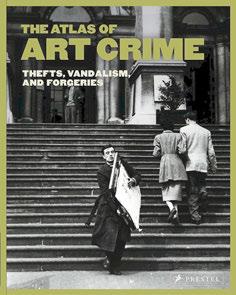
teaching, first at Alabama State College (now Alabama State University), from 1949 to 1965, and then at Winston-Salem State University, from 1965 to 1981, both Historically Black Colleges and Universities. Within Oubre’s story is a history of Alabama art shaping American art that has never been written. This new volume, and its accompanying exhibition, begins to tell this story, laying the foundation for future projects on the work of Black artists in Alabama and the South.
The Atlas of Art Crime: Thefts, Vandalisms and Forgeries by Laura Evans. Prestel Publishing, New York City and London, September 2024, pp. 224, $35, hardcover.
Art history is filled with stories of art crime — but the depth and breadth of these incidents is not generally understood. This first book of its kind illustrates and contextualizes 75 incidents in a unique format that allows readers to visualize the geography of art crime from the past two centuries. Divided into sections on thefts, vandalism and forgeries, each crime is profiled with an absorbing narrative and images of the artworks, perpetrators and scenes of the crime, alongside a map of where it took place. Additional sidebars feature compelling information about the artist and/ or the subjects of the work of art. Including renowned crimes such as the 1911 theft of the “Mona Lisa” from the Louvre, the 1975 attack on Rembrandt’s “Night Watch” at the Rijksmuseum in Amsterdam and Han van Meegeren’s forgery of Vermeer’s “Supper at Emmaus” in 1936, this book also includes lesser known incidents: the remarkably unnoticed theft of a two-foot high statue weighting 50 pounds; a young couple who mistook an exhibition canvas displayed with the paint cans used to create it for an interactive piece and a Chinese librarian who stole 143 paintings by famous Chinese artists and replaced them with his own fakes. Filled with intrigue, controversies and power dynamics, this is a captivating exploration of the darker side of art history.
BROOKLYN, N.Y. — A defining Black woman artist of the Twentieth Century, Elizabeth Catlett (1915-2012) has not received the mainstream art-world attention afforded many of her peers. The Brooklyn Museum, in partnership with the National Gallery of Art, closes this gap with “Elizabeth Catlett: A Black Revolutionary Artist and All That It Implies,” an exhibition of more than 150 works that gives this revolutionary artist and radical activist her due.
A deft sculptor and printmaker, devout feminist and lifelong social justice advocate, Catlett was uniquely committed to both

her creative process and political convictions. Growing up during the Great Depression, she witnessed class inequality, racial violence and US imperialism firsthand, all while pursuing an
“Black Unity” by Elizabeth Catlett, 1968, cedar. Crystal Bridges Museum of American Art, Bentonville, Arkansas, 2014.11. ©2024 Mora-Catlett Family / Licensed by VAGA at Artists Rights Society (ARS), NY. Photo: Edward C. Robison III.
artistic education grounded in the tenets of modernism. Catlett would protest injustices for nearly a century, via both soaring artworks and on-the-ground activism.
Born in Washington, DC, Catlett settled permanently in Mexico in 1946 and for the rest of her life she worked to amplify the experiences of Black and Mexican women. Inspired by sources ranging from African sculpture to works by Barbara
Hepworth and Käthe Kollwitz, Catlett never lost sight of the Black liberation struggle in the United States. Characterized by bold lines and voluptuous forms, her powerful work continues to speak directly to all those united in the fight against poverty, racism and imperialism.
The traveling retrospective will be accompanied by a book of the same title, edited by Dalila Scruggs and distributed by the University of Chicago Press. The
304-page publication offers a revelatory look at Catlett and her nearly century-long life, highlighting overlooked works alongside iconic masterpieces. Essays address topics including Catlett’s early development as an artist-activist, the impact of political exile on her work and the diverse influences that shaped her practice.
“Elizabeth Catlett: A Black Revolutionary Artist and All That It Implies” is on view at the Brooklyn Museum through January 19. The Brooklyn Museum is at 200 Eastern Parkway. For information, www.brooklynmuseum.org or 718-638-5000.
MASS. — The 36th Annual Cape Cod Glass Show and Sale will be conducted on Saturday, September 22, and Sunday, September 23 at the Cultural Center.
The Cultural Center boasts a favorable location and attractive facilities and hosting services (free parking and handicapped entrance). In addition, the show offers free appraisal services, and there will be a raffle for a glass prize. There is also a discounted admission price (with ad or card) that will attract new and past customers to this long-standing event.
Visit the Cape Cod Glass Club’s web site, www.capecodglassclub.org, for a downloadable discount card.
The show will feature glass exhibitors of national reputation and glass collectors of



many interests — early and collectible American blown, cut and pattern glass; antique and contemporary European glass; antique art glass and
contemporary studio glass.
Show hours are Saturday from 10 am to 5 pm and Sunday from 12 to 4 pm. Sponsored by the Cape Cod Glass
Club (chapter of the National American Glass Club), the show will once again be located at the Cultural Center of Cape Cod, 307 Old Main
Pook & Pook will conduct its largest Americana & International sale ever, spread over three days, September 25, 26 and 27. The sale features important single-owner collections, as well as many items from private collectors and institutions. Day one encompasses two important private collections. The first is the folk art collection of Albion P. Fenderson of Modesto, Calif. Al and Florence Fenderson were avid collectors in southeastern Pennsylvania before moving to California in the 1960s. Paintings include a pair of William Matthew Prior husband and wife portraits, a colorful Samuel Miller portrait of a boy in a red dress with a hobby horse and a rare Isaac W. Nuttman still life with a bird and an abundance of fruit. A rare Samuel Folwell Philadelphia watercolor silhouette of the Reverend Absolom Jones is of historical importance. The first of several in the sale, a Wilhelm Schimmel spreadwinged eagle is outstanding for its vibrant original painted surface and imposing size. The highlight of the collection is a highly important ink and watercolor fraktur Taufwunsch by the Sussel-Washington artist.
Pook & Pook will offer the American pewter collection of Dr Melvyn and Bette Wolf of Flint, Mich. The foremost of many highlights is an important Philadelphia William Will coffee pot, which is considered to be one of the finest pieces of American pewter in existence. Other rare pieces include the only Robert Bonnynge church cup in private hands, a Semper Eadem quart tankard, a Frederick Bassett egg-shaped teapot and a Johann Heyne ciborium. The Wolfs’ love of Americana went well beyond pewter and included New England furni-
ture, decorative arts and folk art paintings. A few to mention are a set of 10 Pennsylvania painted treenware lidded canisters, a collection of New England burl bowls and folk art paintings, including two Hudson River landscapes attributed to Thomas Chambers, and two Jonas Welch Holman portraits, of Mary Ann Bassett and of the Bassett children.
A Maryland theme is found in a Historic Blue collection featuring a Baltimore tea service and pieces in the rare Arms of Maryland pattern. A rare pair of Thurmont, Md., redware vases is attributed to James Mackley.
Day two opens with the collection of Rebecca Roberts of York, Penn. Roberts was a passionate collector of local antiques. Furniture includes a blanket chest with vibrant paint decoration by William Heindel and tall case clocks signed Jacob Spangler and Peter Schutz Urmacher. Textiles include samplers, needlework and quilts. Featured coin silver is by Godfrey Lenhart. There are many fraktur, including York County examples by Francis Portzline, Daniel Peterman and Adam Wertz. Among the Jacob Maentel watercolor portraits

are York County residents. Next up are 38 lots of American glass, including a Stiegeltype deep amethyst flask and many with provenance from collectors such as Walter Douglas, Lowell Innes and John Tiffany Gotjen, the latter including a New York blown aquamarine lily pad compote.
Furniture highlights of the day include a Chester County, Penn., tall case clock with works signed Ellis Chandlee Nottingham, and a graceful Bermuda Queen Anne cedar blanket chest. Great painted furniture includes a Pennsylvania blue-painted hard pine

Street (Route 6 to exit 75 [old exit 8] then follow signs). For information, 508-7769098 or email Betsy Hewlett at ehl77pg@gmail.com.

schrank, circa 1770, a diminutive Mahantongo Valley school masters hanging desk, a Virginia dower chest and a Berks County blanket chest attributed to Jacob Blatt, with original salmon fan and circle paint decoration.
Day three begins with the collection of Walter Pyle Smith and Jeannette Chaffee Smith of Gettysburg. The Smiths’ life-long love of antiques resulted in an exceptional collection of Pennsylvania German decorative arts. One of many highlights is a compass artist paint-decorated dome lid box retaining its original rare salmon surface. Not to be missed are two Jonas Weber painted pine dresser boxes and two Wilhelm Schimmel spreadwinged eagles. Other carvings include an important Aaron Mountz large bird. The Smiths also collected redware, including a southeastern Pennsylvania sgraffito charger dated 1811 with eagle decoration, a Snow Hill Nunnery bowl, a Solomon Bell, Strasburg, Va., mixing bowl and two large Hagerstown, Md., bowls, one possibly from the Bell family. A menagerie of redware spaniels, poodles, lions and birds includes a dog holding a fruit basket attributed to Jesiah
Shorb. A Bristol County, Mass., bean pot is one of several items with a Dr and Mrs Donald A. Shelley provenance. A pair of North Carolina Moravian redware squirrel bottles is attributed to Rudolph Christ, Salem. The Smith’s Pyle and Wyeth heritage is evident in artworks by Howard Pyle in watercolor, oil and ink, and an Ann Wyeth McCoy watercolor. Rounding out the collection are works by Edward Moran and Frank Earle Schoonover.
The fine art category includes Taos Art Colony cofounder Ernest Blumenschein and his landscape “Autumn with Storm.” A panorama of landscapes includes several by Maryland/Washington, DC painter John Ross Key, a Max Weyl Washington, DC landscape “The Little River, Georgetown,” a Jack Wilkinson Smith California coastal scene, a Peter Sculthorpe watercolor on paper of a moonlit winter homestead, a Gladys Young street scene, and other landscapes by John Prentiss Benson, Thomas Curtin, Hugh Bolton Jones and others.
Pook & Pook is at 463 East Lancaster Avenue. For information, www.pookandpook. com or 610-269-4040.

he Detroit Institute of Arts (DIA) announced the appointment of Jennifer Paoletti as its vice president of exhibition and collection strategies. Paoletti transitions to this role from her position as director of exhibitions at the DIA, which she has held since 2018. In her new role, Paoletti will oversee the exhibition and collection strategies division, encompassing four departments: collections management, conservation, exhibitions and registration. With more than two decades of experience, Paoletti brings expertise in managing exhibitions and multimedia installations. Her background spans permanent collection rotations and exhibitions featuring prestigious national and international loans. Prior to joining the DIA, Paoletti spent 22 years at the Art Institute of Chicago, holding roles as a research assistant in the departments of European paintings and prints and drawings, exhibition coordinator, exhibition manager and, most recently, director of exhibitions.

Seattle Art Museum (SAM) welcomes Dr Aaron Rio as its new Tateuchi Foundation curator of Japanese and Korean art. He will oversee the museum’s artistic program of Japanese and Korean art, including its collections and exhibitions at all three of SAM’s sites (Seattle Art Museum, Seattle Asian Art Museum and Olympic Sculpture Park). He began work on August 5. Since 2019, Rio oversaw the collections of early Japanese painting and sculpture at the Metropolitan Museum of Art in New York. He joins SAM at a dynamic time: There are more opportunities for the display and conservation of East Asian artworks than at any other time in the institution’s history. SAM debuted the renovated and expanded Seattle Asian Art Museum in 2020, which included more and improved exhibition space, more programming space and the new Atsuhiko and Ina Goodwin Tateuchi Conservation Center, the only studio in the western US dedicated to the structural conservation of East Asian paintings.
Art historian and College of Arts and Letters associate dean for the arts Michael Schreffler has been named director of the University of Notre Dame’s new Arts Initiative emerging from “Notre Dame 2033: A Strategic Framework.”

One of several universitywide priorities outlined in the framework, the Arts Initiative, also known as Arts@ ND, will spearhead collaborative research projects in the arts, promote strategic curricular innovation and stage high-visibility events with substantial community outreach.

CSARASOTA, FLA. — As Artificial Intelligence (AI) transforms the creative industry, Ringling College of Art and Design’s new AI certificate program prepares undergraduate students to prioritize human creativity while proactively employing the rapidly evolving technology. The program is the first of its kind available at an art and design institution and is open to all Ringling College students. The curriculum includes fundamental AI and machine learning principles; their application in creative contexts; and the ethical, societal and cultural implications of AI in art and design.
Hands-on learning provides a comprehensive education covering both the technical and ethical aspects of AI. Students learn to successfully apply the groundbreaking technology in ways that complement their artistic disciplines that range from computer animation, entertainment design and creative writing to game art, fine arts, film and virtual reality development. The courses also caution students of potential ethical and legal pitfalls and prepare them to navigate those risks effectively. They offer insight into the importance of consent, attribution and respect for original creators when working with AI tools.
“This program is not a replacement for studio art and design classes. Instead, it enhances what students are learning in their respective majors and offers the essential tools they need to explore how AI can both help and hinder the creative industry,” said Rick Dakan, AI coordinator at Ringling College of Art and Design. “AI has been disruptive, and we are committed to preparing Ringling College students to traverse this new landscape and protect their artistic practices. Fundamental art and design skills are of paramount importance and remain at the core of our curricula. However, Ringling College is also dedicated to teaching and upholding ethical practices in the use of AI to produce graduates who are not only skilled creators but also responsible stewards of this transformative technology.”
Upon completion of the program, students will have a portfolio showcasing their ability to innovatively apply AI in their creative work. The program will add another credential to their resume, positioning these students as competitive candidates in the job market. As the creative world continues to evolve, Ringling College remains dedicated to providing its students with the latest education and resources necessary to thrive.

Ringling College will celebrate the new certificate program with its inaugural artificial intelligence symposium September 13-14. The two-day educational event titled “AI and Creative Innovation: Advocating for Artists and Designers” will bring together a variety of educators, lawyers, artists and thought leaders who work both directly and indirectly within the field of AI and have specific knowledge and insight about its effects on the art and design industry. The symposium is a ticketed event and will feature a series of lectures, Q&As, workshops and a panel discussion to help attendees navigate the ethical, legal and industry concerns posed by artificial intelligence. Registration for the symposium is currently open.
The symposium will also mark the opening of “Artificial Visions: Faculty Explorations in AI Artistry,” an exhibition on view September 19 through October 11. The exhibition, which features works by Ringling College faculty members, merges technology and artistic expression and features a range of AI-generated works, from paintings to interactive installations driven by machine learning algorithms. It encourages visitors to consider the evolving relationship between humans and machines and AI’s role in the future of art and society.
To learn more about Ringling College of Art and Design’s new AI certificate program, visit www.ringling.edu/aicertificate.
BRIGHTON, U.K. — Brighton & Hove Museums (B&HM) has closed Brighton Museum for a brief period this summer for essential repairs to the roof to take place.
The museum and art gallery closed to the public on August 5 and will reopen on Thursday, September 12. Contractors have started the work to repair the 220-year-old roof to bring the Grade II listed building up to Twenty-First Century requirements.
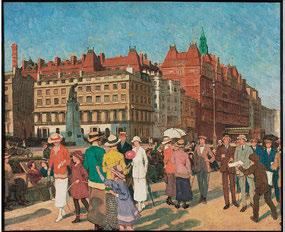
of the two Georgian glass lanterns, which span the building, like a glass skylight, above the central main gallery.
urrently the general director of Dresden’s state museums, Marion Ackermann has been appointed the first woman to run the Prussian Cultural Heritage Foundation (SPK), the largest cultural employer in Germany. With around 2,000 employees, the SPK oversees 15 Berlin museums as well as archives, libraries and research institutes. As president, Ackermann’s tasks will include managing a major overhaul of the foundation. Ackermann, the unanimous choice of a finding commission, will take up the post in June of next year. She succeeds Hermann Parzinger, who is retiring after 17 years as president.
A structural survey in 2019 found that the building, one of the first purpose-built museums in the United Kingdom, needs urgent repairs. The work will be funded by a grant of £1,463,769 by the department for digital, culture, media and sport via Arts Council England. Brighton & Hove City Council, which owns the Royal Pavilion that is managed by Brighton & Hove Museums has provided a grant of £500k for the work. Chief executive officer of Brighton & Hove Museums Hedley Swain said: “We’re sorry the museum will close during this period as we know visitors will be disappointed. The work on the roof is essential to protect visitors and staff, our collections and the building. It needs to be carried out at a time when the weather is expected to be dry, to reduce the risk of water damage while the work is being done. The summer months are the best time to conduct this work and will mean the closure time will be shorter. We hope visitors will understand the situation and take advantage of one of our other venues such as the Royal Pavilion, Hove Museum of Creativity, Preston Manor or the Booth Museum of Natural History.”
This major building project will enhance the care of the collections housed within the space as well as the visitor experience. The work will improve carbon performance and provide better access to the space for both staff and contractors. Preparation work has started for the restoration
Although the museum is closed completely for a short while, for most of the building project, the majority of Brighton Museum will remain open although two galleries — the Twentieth Century Gallery and Mr Willett’s Popular Pottery Gallery — will be closed during the work, which is scheduled to finish in the summer next year. Other galleries such as Fashion, World Art, Ancient Egyptian, Archaeology, Fine Art, Prints and Drawings and Queer the Pier will remain accessible as normal via the front entrance and side galleries. Programs of temporary exhibitions, such as the upcoming “Wildlife Photographer of the Year,” opening in September, “Brighton & Hove Albion: A First Year in Europe” and the popular “See the Sea” fine art show will continue.
Work will include replicating the original Georgian lighting scheme, which made use of light wells and sun pipes, which will mean the whole gallery will be lit by daylight, reducing energy costs. Upgrades and repairs to the two large, glazed roofs will include improved ventilation and insulation to improve carbon performance. The internal walkway between the glazed lanterns will be renewed for better access for ongoing maintenance and to make this much safer for staff and contractors who access this space. Once the lantern repairs are completed, there will be the opportunity to rejuvenate the central gallery space below. Work began by moving collections to protect them and enable the building of a complex internal crash deck. A crash or protection deck is a scaffolding structure or system that creates safe working conditions.
The architects working on the design are Donald Insall Associates.
Sept6Aug15Aug22Aug23Aug26Aug27
Oct25Oct3Oct10Oct11Oct14Oct15
2024
Nov1Oct10Oct17Oct18Oct21Oct22
Nov8Oct17Oct24Oct25Oct28Oct29
Nov15Oct24Oct31Nov1Nov4Nov5
Nov22Oct31Nov7Nov8Nov11Nov12 Nov29Nov7Nov14Nov15Nov18Nov19
TIMONIUM, MD. — Over & Above Online Auction and Estate Sales conducted its End of Summer Spectacular auction on August 29. The sale comprised more than 500 lots with leading categories being jewelry, ephemera and vintage cameras. Coming out on top was an abstract form diamond ring. The approximately 2.25-carat round cut diamond was set in 14K yellow gold. With the diamond rated VS for clarity and K for color, the size six

ring was in good to very good condition. It was won by a local Maryland buyer for $7,475 inclusive of buyer’s premium ($5/7,000). More sale highlights will be in an upcoming issue.
DALLAS, TEXAS — Some of the most celebrated and iconic art created for the Boy Scouts of America will begin to be auctioned in November as Heritage Auctions offers selected works from the collection of the BSA Settlement Trust, with proceeds benefitting survivors of childhood sexual abuse while in Scouting.
Among the landmark works from the collection are masterpieces by Norman Rockwell, led by 1961’s “Homecoming,” and such highlights as J.C. Leyendecker’s 1918 “Weapons for Liberty.”
As part of its bankruptcy plan
of reorganization, BSA’s artwork was transferred to the BSA Settlement Trust, an independent entity tasked with compensating over 64,000 abuse survivors.
Barbara J. Houser, the trustee overseeing the administration and distribution of funds to sexual abuse survivors, said: “These Survivors have waited decades to be heard and acknowledged, and the sale of these works will aid us in providing a measure of justice to them. Buyers should be proud that they will be contributing to rebuilding lives and helping to right past wrongs.”
The BSA Settlement Trust was created as part of BSA’s Chapter 11 plan of reorganization in 2023. Its mission includes maximizing the value of the assets contributed to the Trust by BSA and others while evaluating the sexual abuse claims and delivering compensation to survivors with valid claims. At confirmation of the plan, the Trust’s compensation fund was valued at approximately $2.5 billion. Other causes of action against third parties may increase the fund further. To date, the Trust has paid more than $25 million to over 6,800 survivors.
For information, www.ha.com.
Ahlers & Ogletree Estate Auction 11
Clars
Diamonds, Jewelry & Watches 39
Cottone Auctions
The Collection Of Dr Martin May 21
EstateofMind Auctions
Militaria, Art & Weaponry 16
Kaminski
Art & Estate Auction 42
Michaan’s Auction
Jewelry, Furniture & Asian Art 7
New England Auctions Vintage Signage & More 12
Nye & Co.
Fine & Decorative Arts 3
Pook & Pook Auction
Americana & International Sale...............41
SJ Auctioneers
Jewelry, Silverware, Toys & Décor 5
Sworders
Native American
Beadwork 24
Every Thurs goldengavel.com
Golden Gavel 58 6, Sept Jewett City, CT Leone’s Auction Gallery 2 7, Sept thoscornellauctions.com
Thos. Cornell Galleries 2 8, Sept clarkeny.com
Clarke Auction 45 8, Sept liveauctioneers.com
8, Sept tremontauctions.com
Emperor’s Treasury 58
Tremont Auctions 8C 8, Sept tremontauctions.com
Tremont Auctions 58 10,Sept-11,Oct ..igavelauctions.com...............Lark Mason Associates 5C 12, Sept sloansandkenyon.com
Sloans & Kenyon 55 12-13,Sept eldreds.com Eldred’s 54 13, Sept douglasauctioneers.com
Douglas Auctioneers 48 14, Sept liveauctioneers.com
Schillaci & Shultis 54 14, Sept midhudsongalleries.com
Mid-Hudson Galleries 44 14, Sept milestoneauctions.com
Milestone Auction.........48 14, Sept verobeachauction.com
Vero Beach Auction 52 15, Sept auctionninja.com.........................Past to Present 46 15, Sept collectivehudson.com Collective Hudson 58

15, Sept hpcountryauctions.com Hyde Park 59 15, Sept kaminskiauctions.com Kaminski 53 17, Sept auctionninja.com...........................SJD Auctions 58 17, Sept sworder.co.uk Sworders Fine Art 44 18, Sept bodnarsauction.com.....................Bodnar’s Auction..........58 18, Sept kodner.com Kodner...................51 18, Sept santafeartauction.com Santa Fe Art Auction 2C 18, Sept thebenefitshop.com Benefit Shop 50 19, Sept clars.com Clars 49 19, Sept swanngalleries.com Swann 6C 20, Sept Jewett City, CT Leone’s Auction Gallery 2 20, Sept jmwauction.com JMW Auction.............58 20-21, Sept cottoneauctions.com Cottone Auctions..........47 21, Sept rolandauctions.com Roland Auctions 2 21, Sept rolandauctions.com Roland Auctions 3 21, Sept rolandauctions.com Roland Auctions 56 21, Sept soulisauctions.com Soulis....................46 21, Sept Wilton, NH Langdell Homestead Barn 56 22, Sept carlsengallery.com Carlsen Gallery 4C 22, Sept liveauctioneers.com Iroquois Auction 7C 24, Sept ha.com/8177 Heritage 57 25, Sept ha.com/6305 Heritage 52 25, Sept ha.com/8152 Heritage 57 25, Sept litchfieldcountyauctions.com Litchfield County Auctions 2 26, Sept ha.com/15232 Heritage 57 26, Sept swanngalleries.com Swann 6C 1,Oct-15,Oct......igavelauctions.com................Lark Mason Associates 5C 3, Oct swanngalleries.com Swann 6C 27, Oct tremontauctions.com Tremont Auctions 58 8-9, Nov santafeartauction.com Santa Fe Art Auction 2C 13, Nov litchfieldcountyauctions.com Litchfield County Auctions 2 17, Nov butterscotchauction.com Butterscotch Auction 2
8, Sept Milford, NH 13 12-15, Sept Atlanta, GA 5 14, Sept Westmoreland, NH 3 14, Sept Dover, NH 13 22, Sept Milford, NH 13 28, Sept Lebanon, CT 11 1-6, Oct London 9 6, Oct Milford, NH 13 19, Oct Westmoreland, NH 3 16, Nov Westmoreland, NH 3 30,Nov-1,Dec......Columbus, OH 5 2025 13, May................Brimfield, MA 2 8, July Brimfield, MA 2 2, Sept Brimfield, MA 2
SARASOTA, FLA. — Sarasota Estate Auction presented two days of fine and decorative arts auctions on August 24 and 25. Day one featured a Chiura Obata color woodcut, a lifetime collection of estate jewelry, art glass sculptures and more while day two’s focus was on important fine art, antiques and silver. Leading both days, and in keeping with the unofficial last days of summer, was Milton Avery’s (1885-1965)
pastel, “Beach Loungers,” which surpassed its high estimate to finish at $48,640, including buyer’s premium. “We were very happy with the results,” said the firm’s Mia McDermott. “There was a lot of interest prior to auction time. We started at an internet bid of $14,500 and it climbed all the way up! It ended up selling to an in-house bidder.” Depicting two women lounging on a golden beach with umbrellas

VALATIE, N.Y. — As summer wound down, Old Kinderhook Auction Company’s Autumn Closing In auction on August 27 was aptly titled and offered more than 900 lots that was anchored by a large collection from New England bursting with Chinese antiques, fine art and bronzes.
“Evening Still” by Lanford Monroe (American, 1950-2000) was the sale’s highest seller and exceeded expectations, selling for $6,765 to a buyer in New York City. A more extensive review of this sale, which was nearly 99 percent sold by lot, will appear in an upcoming issue.
Poulin Rides Carousel Horse To $49,200
FAIRFIELD, MAINE — Poulin

Antiques & Auctions’ August 27 Fine Art and Antiques sale included more than 1,600 lots; the variety becomes clear as the top three prices were achieved by totally unrelated items. The top-selling lot was a Carmel & Borrelli armored carousel horse with old park paint that nearly doubled its high estimate and sold for $49,200. Other highlights included an acrylic on canvas signed by Fritz Scholder, that was titled “Kachina Manna” and which had been a gift from the artist to the consignor, earned $45,000. Selling for $36,000, 10 times over the estimate, was a trade sign for Abercrombie and Fitch that stood six feet tall and promoted the sale of sporting firearms. Prices quoted include the buyer’s premium as reported by the auction house; a full report will follow.
Correction
At the end of our August 30 review of Scottsdale Art Auctions' August 3 auction, we inadvertently provided the incorrect contact information for the auction house. Scotts-
at the edge of the ocean in the background, the pastel came loaded with provenance and included a note on the reverse; it was signed, dated and authenticated by his daughter, the coexecutor of the Milton Avery estate: “This pastel was done by my father in the late 30s – March Avery Cavanaugh 10/2/69.”
More on this and other highlights from the sale will appear in a later review.
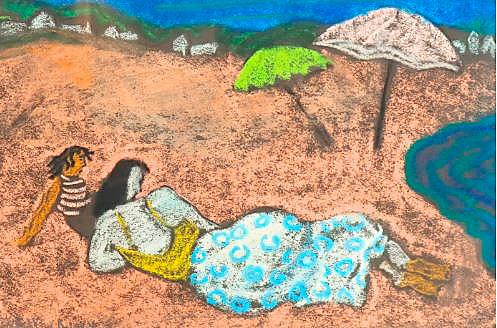
dale Art Auction's next sale will take place in April 2025. For information or to reach Scottsdale Art Auction, www.scottsdaleartauction.com or 480-9450225. We regret the error.
by HenRietta SpenCeR-CHuRCHill, pHotogRapHS by Hugo RittSon-tHomaS
The most important, most visited and most renowned of all of Britain’s stately homes, Blenheim has been home to the Churchill family for more than 300 years.
Regarded as perhaps the greatest of the stately homes and the finest example of baroque architecture in Great Britain, Blenheim is a treasure of English heritage. In this stunning volume, Lady Henrietta Spencer-Churchill, the twelfth generation of the family, takes us on a privileged tour of the palace.
Designed by John Vanbrugh and Nicholas Hawksmoor (a protégé of Christopher Wren) in the early 1700s; with stonework, furniture and tapestries crafted by the best talents of the age;
and art and statuary by such notable artists as John Singer Sargent and Joshua Reynolds, Blenheim is filled with artistic commissions that provide a window into the history of England.
In addition to the gilded staterooms and acres of landscaped gardens, Spencer-Churchill shows us the family’s private apartments, with their secret corridors and history of illustrious guests, as well as the “downstairs” staff area with its iconic bell system.
With beautiful photography of the magnificent interiors and priceless collections, and Spencer-Churchill’s fascinating text, this volume illuminates Blenheim as it’s never been seen before.
Lady Henrietta Spencer-Churchill is an interior designer, founder of Woodstock
Designs, and author of multiple Rizzoli books on design and historic styles, including The Life of the House, Blenheim and the Churchill Family and Classic English Interiors. She lectures widely on design and design history in the United States and the United Kingdom. Hugo RittsonThomas is a portrait photographer of many high-profile subjects, including the British royal family. His work has been published in Romantics and Classics, Secret Gardens of the Cotswolds and Great Gardens of London Blenheim: 300 Years of Life in a Palace by Henrietta SpencerChurchill, photographs by Hugo Rittson-Thomas. Published by Rizzoli, New York City, September 2024, pp. 360, $75 hardcover.


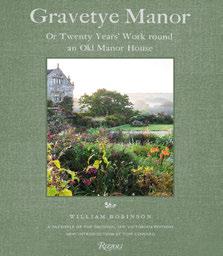
by William RobinSon and tom CoWaRd
A spectacular, oversized facsimile edition of a famous text by best-loved garden writer William Robinson with new color photos and a foreword by its current renowned gardener, Tom Coward, which bring this historic estate and garden to new life.
Gravetye Manor is considered, along with nearby Sissinghurst and Great Dixter, one of England’s most famous and exquisite estate gardens. Robinson purchased the Elizabethan-era property in 1885, working for decades to create its renowned gardens. More recently, it has been turned into a luxury destination hotel complete with a Michelin-star restaurant, and renowned British gardener Coward has been working for 14
years to restore the gardens faithfully to Robinson’s original vision.
Pithy and prolific Robinson is widely acknowledged to have been one of the greatest gardeners of all time, known as “the Irishman who taught the British how to garden,” and the pioneer of the naturalistic planting style still emulated today by garden designers, including Piet Oudolf and many others.
With mentions of specific plants, cultivars and planting schemes as well as observations of seasonal changes and moods, home gardeners today will relate to Robinson’s charming and entertaining original text and see their own smaller-scale efforts reflected in his own gardening triumphs, failures and experiments.
by noRa buRba tRulSSon, pHotogRapHS by andReW pielage, FoReWoRd by StuaRt gRaFF
Frank Lloyd Wright’s winter home and desert laboratory is a National Historic Landmark and has been named a UNESCO World Heritage Site. This book, the first of its kind in decades, celebrates that recognition and offers a new look at this world treasure.
An extraordinary compound of buildings that complements the cactus-studded environs and mountain backdrop of the Scottsdale desert in Arizona, Taliesin West is Wright’s ode to desert living and one of his greatest and most visited venues. Here, amidst palo verde trees and coyotes, the visitor finds an oasis of sparkling pools and low-slung modern build-

ings that are uniquely suited to the site — indeed a veritable paradise that seems to have emerged from the wilderness.
The expression of profound vision and the product of determination, artistry and imagination, here Wright brought forth an organic masterpiece from the elements of the earth.
Begun in 1937, the compound served as a place of exploration, a place of work, a place of camaraderie and culture, and a place of living for Wright, for his family and for the apprentices of the Taliesin Fellowship, who had joined the architect to learn and to work with him side-byside. A most unusual place and community, Wright’s legacy lives on even today.
Taliesin West: At Home with Frank Lloyd Wright explores the life within
structures that make up Wright’s desert masterpiece, from Garden Room to Cabaret Theatre, and delves into the many stories that have made the place at once a crucible for creation and a home.
Nora Burba Trulsson is an Arizonabased architecture, design and travel writer, whose books include Desert Southwest and Living Homes: Sustainable Architecture and Design. Andrew Pielage is an internationally published architectural and travel photographer on a mission to photograph all remaining Frank Lloyd Wright designs. Stuart Graff is president and CEO of the Frank Lloyd Wright Foundation.
Taliesin West: At Home with Frank Lloyd Wright by Nora Burba Trulsson, photographs by Andrew
New color photographs of the current estate gardens show how diligently efforts are being made to restore the house and garden to Robinson’s original vision — to spectacular result. William Robinson was one of the bestloved and best-selling gardener-authors of all time. His original works included The Wild Garden (still in print) and The English Flower Garden. Tom Coward is one of the most respected head gardeners working today. He was trained first at RHS Wisley, Kew Gardens and later by Fergus Garrett at Great Dixter. Gravetye Manor: 20 Years’ Work round an Old Manor House by William Robinson and Tom Coward. Published by Rizzoli, New York City, October 2024, pp. 232, $115 hardcover.

by RobeRt o'byRne, pHotogRapHS by luke WHite
A unique presentation of Irish country house interiors, combining well-preserved historic estates with adventurous contemporary restorations, celebrating some of the most characterful houses in Ireland.
Forgoing the criteria of stateliness and opulence, this book is an exploration of the most captivating and unusual interiors in Ireland. Whether in the transformation of a derelict estate, the preservation of an historic hunting lodge, or the re-creation of a Gothic fantasy, each of the homes in this extraordinary book reflects a renewed vitality in the contemporary approach to Irish country houses.
Rich in detail and varied in scope, the houses reveal a refreshing dynamism in their decoration by equally diverse owners — from the ornate refurbishment of a castle by a Mexican financier to the bold palette of a contemporary artist’s renovation to an Elizabethan Revival house. The sparse interiors of a mansion in Westmeath reflect its painstaking restoration by descendants of the original owners, and at Coollattin — Ireland’s largest country house, part restored, part still in disrepair — the building’s baroque splendor is amplified by its raw, unfinished state.
Accompanying photography of the houses made specially for the book, the author guides readers through 15 exceptional spaces, elucidating the
remarkable aspects of each — and in doing so celebrates the unexpected eclecticism and reinvigorated spirit of Ireland’s historic interiors.
Robert O’Byrne is a writer and lecturer specializing in the fine and decorative arts. He is the author of more than a dozen books, a former columnist for Apollo magazine, and has written for both The Burlington Magazine and the Irish Arts Review. He authors the awardwinning blog The Irish Aesthete. Luke White is a British photographer of portraits, interiors and architecture.
The Irish Country House: A New Vision by Robert O’Byrne, photographs by Luke White. Published by Rizzoli, New York City, September 2024, pp. 272, $65 hardcover.
OAKLAND, CALIF. — Clars will host its diamond and watch auction on Thursday, September 19, starting at 9:30 am PST. This sale will feature an array of large diamonds, signed jewelry and rare watches. Highlighting the diamond jewelry segment are several standout pieces, including a diamond and platinum brooch ($50/70,000); a 3.36 carat diamond and 14K gold ring ($6/8,000; and a diamond and 14K gold bracelet weighing a total of 15 carats ($3,5/4,500).
Among the notable jewelry makers represented are David Webb and Bulgari. Featured is a pair of David Webb diamond, black enamel and 18K gold ear clips ($6/8,000); a pair of David Webb enamel and 18K gold Zebra ear clips ($5/7,000; and a pair of Bulgari emerald, diamond and 18K gold ear clips ($15/17,000).
In addition, the auction showcases a r selection of timepieces. Leading this segment is a stainless steel Rolex “Submariner” wristwatch ($8/12,000); a diamond and 18K white gold Jaeger-LeCoultre Reverso wristwatch ($8/12,000); a stainless steel Rolex Speed King wristwatch ($3/5,000); a stainless steel Rolex Oyster Perpetual wristwatch ($3/5,000); and an 18K gold Cartier Monaco wristwatch ($5/7,000). The sale also includes a diverse range of additional timepiece spanning various decades, featuring rare and exotic models.
Clars will also present its fall fine art auction, taking place on Thursday, September 19, at 1 pm. This event will feature a diverse selection of artworks, starting with an oil on panel painting by renowned American Impressionist William Merritt Chase. Titled “A Mother’s Joy” and created in 1889, this piece measures 17 by 17 inches and is signed by the artist ($600/900,000). The painting’s provenance includes its acquisition by New Jersey Governor Franklin Murphy from Fifth Avenue Art Galleries in 1891,
and it has been exhibited in notable venues such as the Society of American Artists and the Chicago Interstate Industrial Exposition.
Another standout in the auction is a 1953 ceramic pitcher by the Spanish artist Pablo Picasso. Best known for his revolutionary Cubist paintings, Picasso also made significant contributions to ceramic art. This particular pitcher, titled “Piquet Gothique aux Oiseaux” ($8/12,000), showcases Picasso’s distinctive style with its simplified painting technique and depiction of three black birds.
This auction will also feature a striking photograph by GermanAustralian photographer Helmut Newton. Known for his dramatic black-and-white compositions and collaborations with major fashion designers, Newton’s work has been influential in the world of fashion photography. The gelatin silver print offered in this sale titled “Vogue, France, Yves St. Laurent, Paris,” captures Yves Saint Laurent’s collection inspired by film noir aesthetics, and exemplifies Newton’s iconic style of high drama and eroticism ($10/15,000).
Several collectible and notable prints will also be offered in the auction. Among them are two woodblock prints by German/ American artist Gustave Baumann, celebrated for his revival of the woodblock technique in the United States. The two available prints, “Spring Freshet” ($5/7,000) and “The Sycamore” ($6/9,000), both highlight Baumann’s mastery in depicting the Southwestern US landscapes.
A print by the ever-popular Japanese Pop Art icon Yayoi Kusama will also be up for auction. The screenprint, “A Pumpkin BB-C,” which reflects her famous pumpkin in vibrant blue, is priced to sell at $20/30,000.
The sale will continue with more prints, including a 1978/79 untitled etching by American

Chinese purple-ground gauze and gilt-thread “dragon” robe ($2/4,000).
Minimalist Donald Judd ($5/7,000) and two prints by American pop artist Roy Lichtenstein. Lichtenstein’s famous “Crak” offset lithograph from 1964 will be on the block ($10/15,000), along with his small edition pencil signed print created for “Guild Hall East Hampton” ($5/7,000).
From the Pacific Rim and estimated at $15/20,000, Clars will offer a painting from 1963 by Singaporean artist Cheong Soo Pieng (1917-1983). Heading north, an oil on canvas by contemporary Chinese artist Liao Zhenwu (b 1964) titled, “The Story of Meditation (2008),” will be offered ($5/7,000). Always a favorite among collectors is South Asian artist Jamini Roy (Indian,1887-1972). Known for capturing the essence of simplicity in the life of the Indian people, a classic gouache on paper, untitled (1967), featuring a seated figure by the artist is another of the many highlights ($7/10,000). Clars will offer several contemporary works of sculpture. Included is a work by Vivian Wang (Chinese, b 1945) featuring a glass figure of a seated child with a red and black painted hat and outfit ($3/5,000). Another striking piece in this group is a mixed media sculpture by American artist Peter Anton (American, b 1963) depicting an ice cream bar

Helmut Newton (Australian/German, 1920-2004), “Vogue, France, Yves St. Laurent, Paris,” 1981, gelatin silver print, signed ($10/15,000).
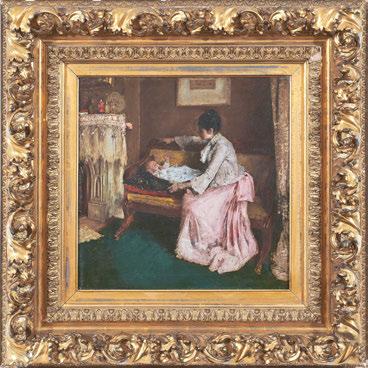
($4/6,000). Anton is known for his hyperrealist sculptures of dessert foods. Also included in the sculpture section is an anemone-like glass cube by Wilfried Grootens (German, b 1954) ($3/5,000 as well as a glass mime figure by Martin Janecky (Czech, b 1980) ($4/6,000).
Bidding for Clars’ September auctions is available by phone, absentee bid and live online at live.clars.com and through LiveAuctioneers and Invaluable. Clars Auction Gallery is at 5644 Telegraph Avenue. For information, 510-428-0100 or www.clars.com.
WASHINGTON, DC — “Ralph Steadman: And Another Thing” spans more than 60 years of the artist’s life and artwork. Showcasing Steadman’s creative passion, collaborations and ongoing evolution, the exhibition presents works from his early years as a student to his political illustrations, social commentary and activism. “Ralph Steadman: And Another Thing” is on view at American University Museum at the Katzen Arts Center through December 8.
As one of the most influential illustrators and comic artists of the last six decades, Steadman is famous for his long collaboration with Hunter S. Thompson, notably illustrating Fear and Loathing in Las Vegas. Through their storytelling, in which the topic becomes almost secondary to the personality of the artists and
work, a new way of covering news was born. In Gonzo journalism, as named by Boston Globe journalist Bill Cardoso, journalists use firstperson narratives in reporting.
The influence of Gonzo journalism is evident in today's online news sources, editorial pieces, social media, videos, political punditry and podcasts.
The unprecedented exhibition features a selection of 149 original artworks as well as ephemera, including Steadman’s sketchbooks, children’s books, magazines, personal photographs and handwritten notes that tell a fuller story of how the artworks were born. Beautiful works from “The Gonzovation Trilogy,” his collaboration with documentarian and filmmaker Ceri Levy about extinct and endangered birds and animals, sit alongside his more experimental collections such as
Paranoids, caricatures of notable figures from history, entertainment and politics that Steadman created by reworking Polaroid photographs. Works on display will include iconic illustrations for all ages, including Lewis Carroll’s Alice in Wonderland, Robert Louis Stevenson’s Treasure Island, Kurt Baumann’s Dozy and Hawkeye and Steadman’s The Little Red Computer and That’s My Dad Visitors will engage with art depicting famous writers and musicians and keen observations on politics and society, demonstrated through Steadman’s series of portraits of United States presidents. “Vintage Dr Gonzo,” a life-size bronze sculpture by Jud Bergeron, will also be touring with the exhibition.
“Don’t think about style; just think about drawing honestly, trying to express something about
a particular subject, model or whatever it is you are drawing. Style will get in the way.” —Ralph Steadman.
This show promises an epic journey through Ralph Steadman’s remarkable career. It will astonish die-hard fans and captivate those discovering his work for the first time. The American University Museum is proud to be the first to host this extraordinary touring exhibition in the United States
The exhibition is accompanied by a full-color, 207-page publication of the same name. Special hardcover and softcover editions will be available.
American University Museum at the Katzen Arts Center is at 4400 Massachusetts Ave. Northwest. For further information, www.american.edu/cas/museum or 202-885-3630.

“Self-Portrait – Don’t Draw Ralph! It’s a Filthy Habit…” by Ralph Steadman, 2006, ink and collage on paper, approximately 23½ by 15 inches. Courtesy of the Ralph Steadman Art Collection.

SARASOTA, FLA. — On August 18, Amero Auctions conducted its Carefree Days of Summer auction, which fea-
Closing its drawers for $12,870 was this French Empire-style cartonnier with provenance to Duck & Dolphin Antiques, which consisted of a mahogany case with gilt bronze ormolu mounts and decoration, a centered clock and seven leather front drawers. A metal tag marked “Ambeublements Forest, Paris” was inside the drawers ($1,5/2,500).

This pair of French gilt bronze and marble gueridon tables contained inset variegated white marble tops, lower shelves, gilt bronze frames, rams head finials at their leg joints and serpentine legs ending in hoofed feet. The duo each measured 27 inches tall and sold for $8,775 ($4/6,000).

This lot of 11 antique shorebird and duck decoys soared past their $300-$400 estimate to achieve $9,375. The carved wooden decoys all hailed from different makers and the largest of the lot measured 15¼ inches long.

Chinese carved center table with an inset marble top and an intricately carved border, skirt and legs and a carved figural toad finial hopped, skipped and jumped to $14,400, the highest price for furniture in the sale ($6/8,000).
tured the second phase of the liquidation of Duck & Dolphin Antiques (Key West, Fla.), the Alexander Raydon Gallery art collection and the sword collection of Bob McGregor, alongside other lots curated from estates nationwide.
Leading the 464-lot sale was “Explosion,” a lithograph on paper by Roy Lichtenstein. The work originated from the artist’s “Portfolio 9” and was published by Irwin Hollander in 1967; it bore a blind stamp from the publisher on its lower right side. The 29¼-by-22-inch lithograph had provenance to the Alexander Raydon Gallery (New York City) and exploded past its $10/15,000 estimate to earn $18,750.
Rounding out the top three lots were two blown glass sculptures by American glass
artist Stephen Rolfe Powell. Earning $17,500 was a 51½-by-23½-inch murine sculpture with a clear glass base from his “Massive Screamers” series. It was sold with a certificate of authenticity. From Powell’s “Teasers” series, the other had three lower lobes and an extended neck; it dangled at $16,680, more than double its low estimate. The approximately 62½-by-19-inch sculpture was signed and dated “2007” and “CBV.”
Hopping to $14,400 was an antique carved Chinese center table with an inset marble top. Its conforming carved border was decorated with “gourd vines and auspicious items,” according to the auction catalog. In addition, the table had a reticulated skirt ornately carved with dragons, scholar

Swinging to $16,680 was this blown glass murine sculpture by Stephen Rolfe Powell (American, 1951-2019), which came from the artist’s “Teaser” collection. Signed “CBV” and dated “2007,” the work had three lower lobes and an extended neck ($8/12,000).
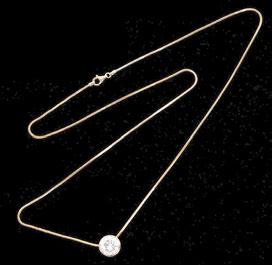
Making a statement for $9,375 was this 24-inch 18K gold snake chain necklace with a 14K yellow gold pendant bezel set with one
figures, clouds or smoke and fruiting vines. Its legs had stylized masks at their joints, and a carved figural toad finial on its cross stretcher.
A similar circular Chinese marble table sold for $11,875, while a console crossed the block for $10,625. Furniture was not the only popular category in the sale, with a lot of 11 wooden vintage shorebird and duck decoys flying to $9,375, far surpassing their estimate of just $300-$400. All 11 antique decoys were hand carved and painted and came from various makers, with condition and age varying per decoy.
Prices quoted include the buyer’s premium as reported by the auction house. For information, 941-330-1577 or www. ameroauctions.com.

by
(American,
on
published by
by
signed in pencil lower right, numbered “A/P” lower left, burst to $18,750, the highest price of the sale ($10/15,000).

From Stephen Rolfe Powell’s (American, 1951-2019) “Massive Screamers” collection, this blown glass murine sculpture with a clear glass base hung at $17,500, far surpassing its $8/12,000 estimate.
BEVERLY, MASS. — After a successful weekend in August auctioning the contents of the Carmelite Nuns Monastery in Danvers, Mass., and a fine art auction, Kaminski Auctions will follow those up with a one-day auction on Sunday, September 15, starting at 11 am and featuring additional art from the Best Products collection with additions from other Florida and New England estates.
The auction will showcase a collection of art, headlined by a notable work by Stanley Whitney (American, b 1946). The abstract, oil on canvas, dated 1980 verso, measures 48 by 65 inches. Whitney is an African American artist born in Bryn Mawr, Penn., near Philadelphia; a master colorist known for his stacked blocks of saturated colors. He moved to New York in 1968 and received an MFA from Yale School of Art in 1972. His career, spanning more than 50 years, has included exhibitions in New York, Buffalo, Philadelphia, Ottawa, London, Stockholm, Sydney, Rome, Venice, etc., and his works are included in the collections of many major museums such as the Guggenheim, the New York Metropolitan, Studio Museum of Harlem, Philadelphia Museum, etc. This painting is formerly part of the Best Products Company, Richmond, Va., collection.
Another highlight is an abstract oil on canvas by Norman Bluhm (American, 19211999), dated 1961. Born in Chicago, Bluhm studied under Mies van der Rohe at the then Armour (now Illinois) Institute of Technology. Bluhm, a key figure in American Expressionism, created this 36-by-24-inch painting, which is framed to 42 by 29 inch-

es. This piece comes from a Palm Beach, Fla., estate and exemplifies Bluhm’s dynamic and emotive style.
American art continues with a winter landscape by Aldro Hibbard (American, 1886-1972) depicting West Townshend, Vt. This oil on canvas is signed and sourced from a Vermont estate. Also featured is an unsigned oil on canvas attributed to Joseph Goodhue Chandler (1813-1884) portraying two young boys in a pastoral scene, dating from circa 1845. Additionally, a Charles H. Woodbury (American, 18641940) painting of dories, signed and from an Assonet, Mass., collection, will be available.
European art enthusiasts will find interest in a late Eighteenth Century Flemish Italian School portrait of a boy with sheep, attributed to Michele Desubleom; and a Torzinnini PreRaphaelite oil on canvas, framed
in an ornate gilt frame, from a Beverly, Mass., collection.
The auction features luxury jewelry and silver items, including a Cartier Roadster 2510 automatic stainless-steel watch, valued at $9,000 and presented in its original box with manual and CD. Also, there will be a 19-carat white gold and diamond ring and two International Silver sterling silver flatware services: Courtship and Minuet.
Asian art highlights include a Qing dynasty Chinese watercolor on silk depicting a royal woman bathing, and a large famille rose bottle vase decorated with peaches and flowers, marked with an iron-red Qianlong mark on the base.
The auction also offers an impressive selection of furniture, including a Herman Miller Botticino marble-top table imported from Italy, a Dutch marquetry slant-lid desk, a


Charles H.
(American, 1864-1940) painting of dories, signed and from an Assonet, Mass., collection, will be
Dutch marquetry cylinder-front desk, a large Chinese zitan table and a campaign chest and desk with brass hardware from a Palm Beach estate.
Kaminski Auctions’ gallery is at 117 Elliott Street, Route 62. Prospective buyers are invited to preview the items at the gallery from
September 9-13, between 9 am and 5 pm, and on the day of the auction starting at 9 am. The preview remains open while the auction is live. For those unable to attend in person, online bidding is available via KaminskiLIVE. For information. 978-927-2223 or www.kaminskiauctions.com.

ALLENTOWN, PA. (AP) — A Pennsylvania museum has agreed to sell a Sixteenth Century portrait that once belonged to a Jewish family that was forced to part with it while fleeing Nazi Germany before World War II.
The Allentown Art Museum will auction “Portrait of George the Bearded, Duke of Saxony,” settling a restitution claim by the heirs of the former owner, museum officials announced Monday.
The museum had bought the painting, attributed to German Renaissance master Lucas Cranach the Elder and Workshop, from a New York gallery in 1961 and had displayed it ever since.
The portrait was owned by Henry Bromberg, a judge of the magistrate court in Hamburg, Germany, who had inherited a large collection of Old Master paintings from his businessman father. Bromberg and his wife, Hertha Bromberg, endured years of Nazi persecution before leaving Germany in 1938 and emigrating to the United States via Switzerland and France.
“While being persecuted and on the run from Nazi Germany, Henry and Hertha Bromberg
had to part with their artworks by selling them through various art dealers, including the Cranach,” said their lawyer, Imke Gielen.
The Brombergs settled in New Jersey and later moved to Yardley, Penn.
Two years ago, their descendants approached the museum about the painting, and museum officials entered into settlement talks. Museum officials called the upcoming sale a fair and just resolution given the “ethical dimensions of the painting’s history in the Bromberg family.”
“This work of art entered the market and eventually found its way to the museum only because Henry Bromberg had to flee persecution from Nazi Germany. That moral imperative compelled us to act,” Max Weintraub, the museum’s president and CEO, said in a statement.
The work, an oil on panel painted around 1534, will be sold in January at Christie’s Old Master sale in New York. The museum and the family will split the proceeds under a settlement agreement. Exact terms were confidential.
One issue that arose during the talks is when and where the painting was sold. The family believed the painting was sold under duress while the Brombergs were still in Germany. The museum said its research was inconclusive, and that it might have been sold after they left.
That uncertainty “was the genesis of the compromise, rather than everybody standing their ground and going to court,” said the museum’s attorney, Nicholas M. O’Donnell.
Christie’s said it would not be ready to provide an estimate of the portrait’s value until it could determine attribution. Works by Cranach — the official painter for the Saxon court of Wittenberg and a friend of reformer Martin Luther — are generally worth more than those attributed to Cranach and his workshop. Cranach’s portrait of John Frederick I, Elector of Saxony, sold for $7.7 million in 2018. Another painting, attributed to Cranach and workshop, sold for about $1.1 million in 2009.
“It’s exciting whenever a work by a rare and important Northern Renaissance master like
Lucas Cranach the Elder becomes available, especially as the result of a just restitution. This painting has been publicly known for decades, but we’ve taken this opportunity to conduct new research, and it’s leading to a tentative conclusion that this was painted by Cranach with assistance from his workshop,” Marc Porter, chairman of Christie’s Americas, said in a statement.
The Bromberg family has secured agreements with the private owners of two other works. The family is still on the hunt for about 80 other works believed to have been lost under Nazi persecution, said Gielen, the family attorney.
“We are pleased that another painting from our grandparents’ art collection was identified and are satisfied that the Allentown Art Museum carefully and responsibly checked the provenance of the portrait of George the Bearded, Duke of Saxony and the circumstances under which Henry and Hertha Bromberg had to part with it during the Nazi-period,” the Bromberg family said in a statement.
BOSTON, MASS. — The McMullen Museum of Art at Boston College (BC) presents “States of Becoming,” an exhibition curated by Fitsum Shebeshe and produced by Independent Curators International (ICI). It examines the dynamic forces of relocation, resettling and assimilation that shape the artistic practices of a group of 17 contemporary African artists and informs the discourse on identity construction within the African diaspora. The artists, who either relocated to the United States or are first-generation born, have lived and worked here within the last three decades.
The McMullen is the first New England venue to host “States of Becoming,” which presents 28 works across mediums including painting, photography, sculpture, installation and video, which express the different ways in which identity is remade and reimagined. The traveling exhibition is on view through December 8. It features works by artists Chukwudumebi Gabriel Amadi-Emina, Kearra Amaya Gopee, Kibrom Araya, Nadia Ayari, Vamba Bility, Elshafei Dafalla, Masimba Hwati, Chido Johnson, Miatta Kawinzi, Dora King, Helina Metaferia, Nontsikelelo Mutiti, Yvonne Osei, Kern Samuel, Amare Selfu, Tariku Shiferaw and Yacine Tilala Fall.
The artists relocated from twelve countries in Africa and one in the Caribbean — Ethiopia, Ghana, Ivory Coast, Kenya, Liberia, Mauritania, Nigeria, Senegal, Sierra Leone, Sudan, Trinidad and Tobago, Tunisia and Zimbabwe — with roots in
cities across the US, including Detroit, Los Angeles, New Haven, New York and Washington, DC.
“The McMullen Museum and Boston College’s African and African Diaspora Studies Program (AADS) are pleased to present the recent work of 17 outstanding artists, all of whom have been members of the African diaspora in the United States,” said Nancy Netzer, inaugural Robert L. and Judith T. Winston director of the McMullen Museum of Art, and a BC professor of art history.
“Although practicing in a wide variety of mediums, these artists are united in the important questions their works probe about the role of relocation in reimagining hybrid identities and a sense of belonging. Such questions are fundamental to the liberal arts education at Boston College and, especially, to the pedagogy and research of our faculty in African and African Diaspora Studies. We look forward to engaging the community in productive dialogue sparked by these inspired works of art.”
The exhibition is arranged in three groups: artists whose relocation prompted aesthetic transformations by incorporating hybrid elements into their work; artists who share their experiences from their country of origin within their current communities; and artists who build bridges connecting the African diaspora to the United States in their practice. “States of Becoming” aims to contribute to conversations on identity construction in the face of relocation and resettling, exemplifying how diaspora artists navigate the interplay
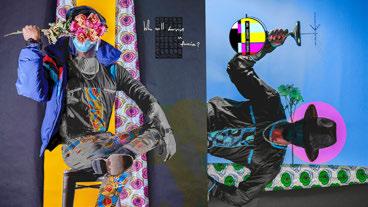
between ancestral African heritages and prevailing American cultural paradigms.
“The African and African Diaspora Studies Program was particularly drawn to the way the exhibition showcases core elements of our program,” said BC professor of history and AADS director Lorelle Semley. “Like our courses, these works reveal the global nature of the African diaspora. The tension between transformation and belonging emerges because the African diaspora is ‘everywhere’ yet often erased,” she added.
“The artists approach this phenomenon by engaging across multiple subjects including history, sociology, politics, visual and performing arts, literature, etc. Similarly, African diaspora studies puts different disciplines into dialogue, often through the creative use of materials and methods. We certainly hope that students make those deeper connections between African diaspora studies courses and the themes of the
exhibition. However, we think it is more important for our students and the broader BC community to take the time to experience this artwork, with their hearts and their minds.”
“‘States of Becoming’ was born out of my own process of relocating to the United States,” said Fitsum Shebeshe, who moved from Addis Ababa, Ethiopia, to Baltimore, Md., in 2016. “This exhibition allows for further understanding of not only my own experiences, but those of the artists. By analyzing both the unique aspects and commonalities together with Boston College’s global and local communities, we can reimagine together how we think about how identity is continually shaped and reshaped.”
According to Shebeshe, through relocation he gained firsthand knowledge of the weight of cultural assimilation and encountered a range of existential questions that shaped his relationship to institutions and culture. He also realized he was viewed as
belonging to a minority and developed a newfound awareness of the profound impact Ethiopia’s traditional and conservative culture had on his sense of individuality.
He found kinship among cultural practitioners from the African diaspora who shared his experience, and united these artists in “States of Becoming.” Although their individual artistic methodologies and experiences vary, each seeks to reconceptualize a hybrid culture formed from real and imagined genealogies: cultural, racial, national and geographical belonging. “States of Becoming” explores the artists’ process of identifying, redefining and becoming themselves in both local and global contexts, opening up perspectives into multiple states both geographic and emotional in a constant flux of social and cultural adaptations.
“In ‘States of Becoming,’ curator Fitsum Shebeshe contributes a significant and personal view of contemporary art of the African diaspora, and reasserts the importance of a curator’s lived experience in exhibitionmaking,” said Renaud Proch, ICI’s executive and artistic director.
On tour through 2027, “States of Becoming” was on view at the Africa Center, New York; the Center for Art Design and Visual Culture, University of Maryland, Baltimore County; and the Des Moines Art Center. It will travel to the Knoxville Museum of Art in January 2025.
The McMullen Museum is at 2101 Commonwealth Avenue. For information, www.mcmullenmuseum.bc.edu or 617552-8587.
GREENWICH, CONN. — Mergansers, pintails, mallards and eiders have all adorned the Federal Duck Stamp, one of the most successful conservation programs in United States history. Discover the artistry behind the popular waterfowl hunting stamp in “Conservation Through the Arts: Celebrating the Federal Duck Stamp,” on view September 5-February 9, at the Bruce Museum. The exhibition showcases a unique array of paintings and works on paper by renowned wildlife artists, including more than 70 works recently donated to the museum.
Since its launch in 1934, the Federal Duck Stamp has raised more than $1.2 billion to preserve more than 6.5 million acres of wetlands across the United States. All duck hunters must purchase the stamp, which supports the conservation and acquisition of wetlands where the birds thrive. The first stamp featured a brush and ink drawing of mallards by famous Pulitzer-Prize-winning editorial cartoonist and noted conserva-
tionist Jay N. “Ding” Darling. Darling was chief of the Bureau of Biological Survey, a precursor of the US Fish & Wildlife Service, from 1934 to 1936.
In the early years of the program, the annual stamp design was selected by a panel from a shortlist of invited wildlife artists. The first art contest was conducted in 1949. The contest, open to any US artist aged 18 or older, remains the only art competition run by the US government. Hundreds of artists vie each year for the prestige of seeing their art grace the new stamp. Works on view in “Conservation Through the Arts” include original paintings, drawings and etchings representing the winning stamp designs, part of a recent donation to the museum by collector Richie Prager. An avid outdoorsman, Prager got his first stamp at the age of 15. After years of developing a substantial collection, he began seeking out the original artworks behind the stamps.
As a Greenwich resident, Prager felt strongly about making the Bruce the perma-
nent home for his one-of-akind collection as a way to give back to his community.
Historic documents and objects from the Bruce Museum’s natural history collections will accompany the artwork on view. Highlights of the exhibition include an early print by Darling; two paintings by David Maass, one of history’s most famous wildlife artists; and contemporary paintings by Joseph, James and Robert Hautman, three brothers renowned for collectively winning 15 competitions.
The Bruce will welcome visitors to experience the 2024 Federal Duck Stamp Art Contest live at the museum September 19-20. At the two-day event, five expert judges will examine hundreds of entries to select the winning design for the 2025 Federal Duck Stamp. The five species eligible for the contest are Northern Shoveler, Brant, Greater Scaup, Spectacled Eider and Hooded Merganser.
“Seeing the style of etchings, drawings and paintings evolve over time is fascinating,” said
Daniel Ksepka, PhD, curator of science at the Bruce Museum. “It’s also remarkable to see how Duck Stamps have permeated popular culture. But most important of all is the success of the program as a conservation vehicle — it almost certainly saved some species from extinction in the first few decades and contin-
ues to conserve millions of acres today.”
“Conservation Through the Arts: Celebrating the Federal Duck Stamp” is organized by the Bruce Museum and curated by Daniel Ksepka.
The Bruce Museum is at 1 Museum Drive. For information, www.brucemuseum.org or 203-869-0376.



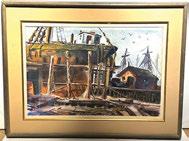


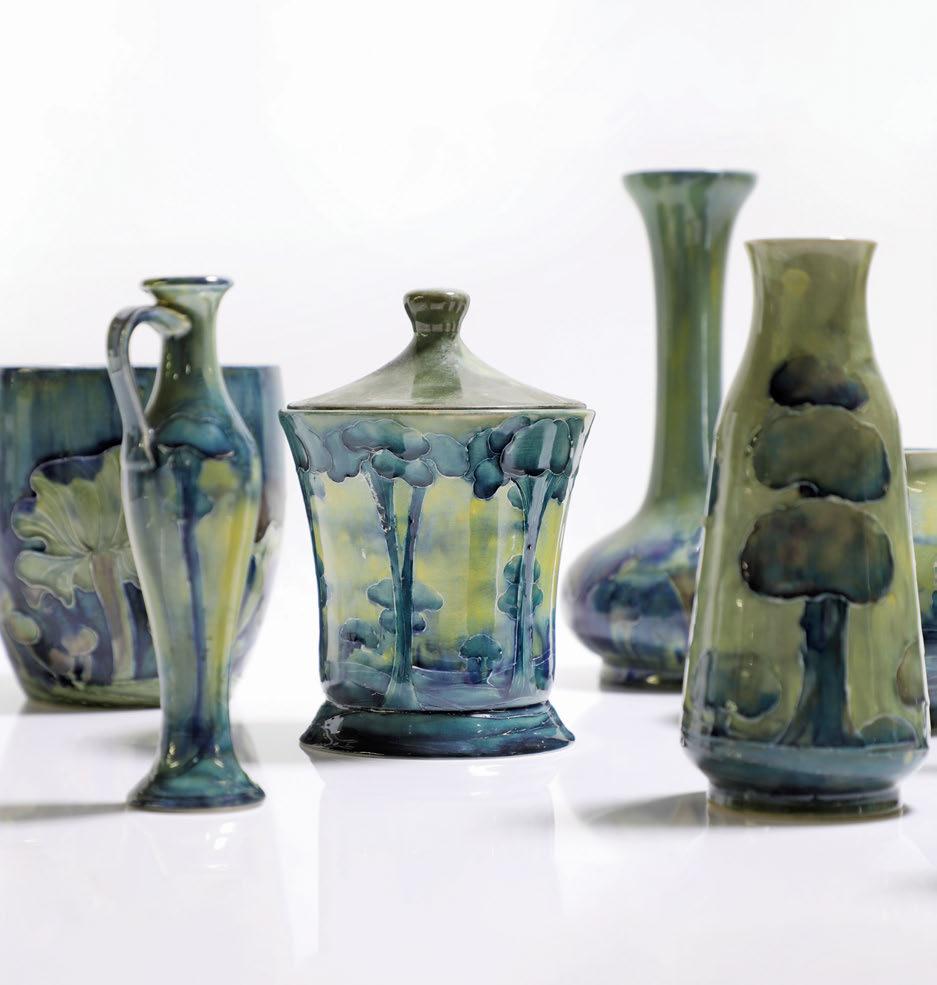





SUNDAY SEPTEMBER 8 | 10 am est
Gallery Previews: Thursday 5th - Saturday 7th | 12pm to 6pm
Internet Bidding: Invaluable & Liveauctioneers | Phone & Absentee Bidding Are Welcome!















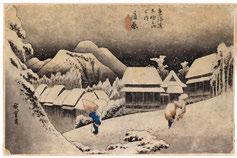


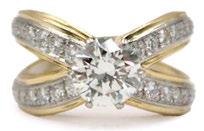



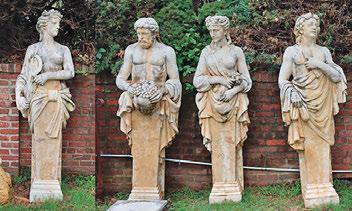
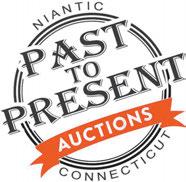
September 15th at 6:00 pm
Preview September 13 & 14 from 10:00 am - 1:00 pm
For complete details, photos, terms and preview go to: www.auctionninja.com/past-to-present-ct 860-941-5973






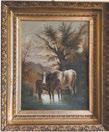






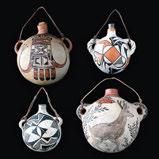









Court Street, Geneseo, New York 14454
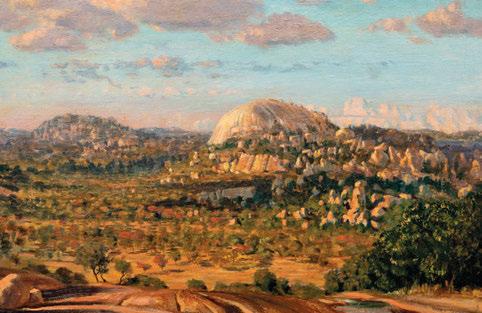






























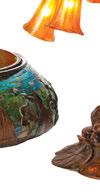


FRIDAY, SEPTEMBER 13 AT 6 PM







Fine Art: Paintings: Mary Neal Richardson (large portrait), Anthony M. Alonso (3), Dubrovnik, John Tomasetti, Bill Ely (13), Dr. Samuel P. Cowardin III, Randall Exon, Elice Davis Pieropan, ancestral portraits, David Chandler, Delaiti, Marty Carey, K. Parker, Gregory Sievers, C.W. Hardy, J.H., Roc Caivano (4), Bill Loweree, sandpaper picture and more. Prints: Mervin Jules, Agnes Mills, Kim Elroy, Heinrich Keller, Davino, Sculpture: Walter Matia, and more.
Furniture: Early: Fine 2-pc camphorwood captains’ desk, Chippendale 4-drawer chest and slant front desk, Hepplewhite card table, mahogany breakfront, stenciled washstand, candlestands, Windsor, Bannister, and Chippendale chairs, Shaker armchair, French 6-drawer tall chest, 8 arrow back side chairs, blanket chest, drop leaf table, 2-drawer stand, and more. Victorian, Modern, & Custom: Wassily armchair, marble


top stand, tea table, and more.




Jewelry:14K and 18K gold rings, earrings, bracelets, necklaces, gold thimble, Mexican sterling, tribal, turquoise and coral, diamond jewelry, and more.
Glass & China: 69 pc Royal Doulton “Provencal”, 95 pc Rosenthal yellow rose pattern, 93 pc Johann Haviland flower border, Josh Simpson wines, Studio Pottery, Limoges oyster plates, and more.
Clocks: Grandfather by Joshua Wilder, Hingham and another, 5-tube tall clock, electric master clock, pillar and scroll, Burr & Chittenden, Seth Thomas, Riley Whiting, Elisha Manross, marble clocks, school house, calendar, gallery, Waltham presentation banjo, Wag-on-theWall, French, Porcelain, Black Forest, and more.
Collection of 125 Staffordshire figures to by sold in singles and lots


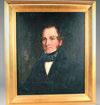
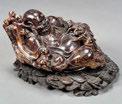
Asian: Large blue and white dragon jar and charger, cloisonne plate, scroll, lacquerware lap desk, table with 3 chairs/stools, large carved soapstone Buddha, Canton, and more.
Accessories: 2-horse metal pull toy, hammered tray by Georg Von Mendelssohn, Books: The illustrated book of the dog, and Frank Lloyd books, Fred Adams Chippendale mirror, Astral lamp, violin by Joseph Kirouar (Rochester N.H.), 3 Janna Ugone lamps, large carved wood figural group, mirrors, fireplace equipment, cased poker chips, stoneware, calligraphy of eagle, wood carved tribal masks, Banjo barometer (J. Poncia, Hereford), lap desk and jewelry box, paisley shawl, green cased mushroom lamp, quilts, 7 large street lights, and more. Oriental Rugs: quantity of antique, modern room size and scatter sizes.
PREVIEW: THURS. 8am–4pm & FRI 8am–6pm

































1. Roy Lichtenstein, Crak!, 1964, offset lithograph in colors, 18.5" x 27". 2. Pablo Picasso, PiquetGothique auxOiseaux, 1953, terre de faience pitcher painted in colors with partial glaze, ll"h. 3. Cheong Soo Pieng, Untitled, 1963, oil on canvas, 19.75" x 27.75". 4. Yayoi Kusama, APumpkin88-C, 2004, screenprint in colors, 9.5" x 11.25". 5. Helmut Newton, Vogue, France, Yves St. Laurent, Paris, 1981, gelatin silver print, 14.5" x 14". 6. Sam Francis, Untitled, 1963, gouache on paper, 13.75" X 12.5".
7. William Merritt Chase, AMother'sJoy, 1889, oil on panel, 17" x 17" ( 43.2 x 43.2 cm)
Provenance: The artist; Purchased by Franklin Murphy, New Jersey (Governor of New Jersey, 1902-1905 ) at Fifth Avenue Art Galleries, New York, March 6, 1891, lot 64 (sold by the artist); Private collection, Kentucky. Exhibited: New York, AnnualExhibitionoftheSociety ofAmericanArtists, May 1889; Chicago, Illinois, 17thAnnualChicagoInterstateIndustrialExposition, Sept. 1889; New York, American Art Galleries, 1890.
Literature: Ronald G. Pisano, WilliamMerrittChase: PortraitsinOil, Vol. II, New Haven, Conn ecticut, 2007, p. 84, no. OP.164. Note: Accompanied by copy of letter of authenticity from D. Frederick Baker/Ronald G. Pisano, Inc. October 2, 2023.


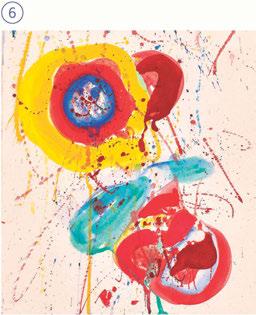
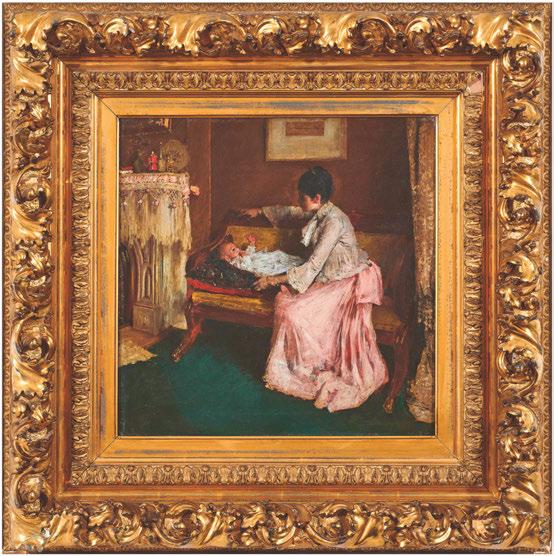












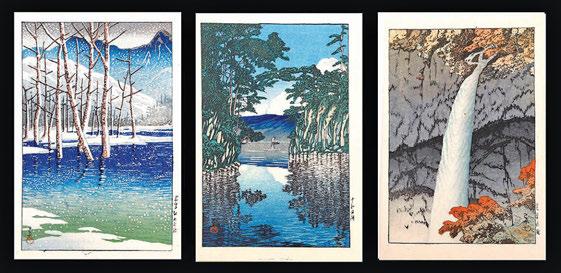








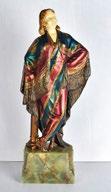

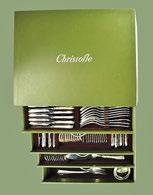



















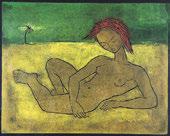



























September 15th, Sunday, 11:00 AM 117 Elliott St., Beverly, MA 01915

lot223A
StanleyWhitney(American,b.1946),abstract,oilon canvas,dated1980verso,48”x65”.
Kaminski Auctions presents a one-day September Estates auction on Sunday the 15th, featuring art from the former Best Products Company of Richmond, Virginia collection with additions from other Florida and New England estates. The auction will showcase a striking selection of art, headlined by abstract works by Stanley Whitney and Norman Bluhm, as well as paintings by Aldro Hibbard, Charles H. Woodbury, and Albert Pinkham Ryder. There is also fine jewelry, silver, furniture, Persian rugs, and much more on offer. Auction to be held at the Kaminski Gallery, 117 Elliott St., Beverly, Massachusetts.
Preview: Monday-Sunday, September 9th-15th, 9:00 AM-5:00 PM.

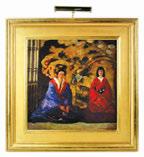



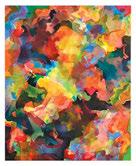























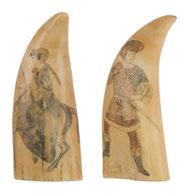
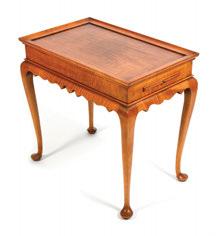












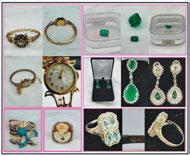

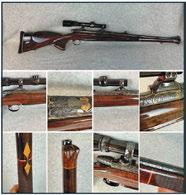

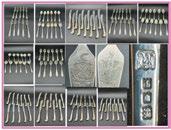

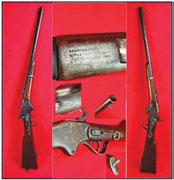











We have the privilege to represent several Collections from various estates, including many pieces from one of the heirs from the Emmons Woodchuck Knoll Estate we handled before. There are very fine and high-end jewelry and gemstones. We have asked John Fritze Jr. CIA Gemologist to consult on these matters and provide the written appraisals. We have many nice rifles, including the most spectacular Special Edition of a Remington 700 CLD 270 Winchester beautifully engraved with gold and silver by H&H, a very nice Winchester 1894 lever-action. There is a large amount of silver coins, silver Tiffany Lighter, nice repousse sterling items, nice Old English Silver Flatware and much more. A very rare Markneukirchen violin by the Heberlein family of Germany. Early Books, Country Primitive Items - so much more. This auction’s very fine collectibles are too much to mention. Note: The rifles to be sold via in person bidding only - while rest of auction to be sold via internet ( Live Auctioneers) as well as in person. All FFL regulations will be enforced. See you then or register to bid on- line through Live Auctioneers.com Firearms can be found in Auctionzip.com (our ID # 36033) too. Food & Drink available.
Notice: All FFL fees will be an addition separate from auction purchase costs of items. All Firearms and Ammo should be checked by a professional before any use! FFL Dealer: Firefly FireArms (FFFA), 1216 Libby Ave., Schenectady, New York, 12309 , 518 -225-2035.


Auction Date: Saturday - September 14th 2024 @ 10:30a : Live Auction @ 10AM In-Person Sale of Firearms items
Previews: Sept. 13th - 1:30pm to 3pm Sept. 14th - 9am to Starting Time @ 10am

Location: Van Rensselaer Masonic Lodge #87 710 Columbia Tpk.(Rte 9&20), East Greenbush, NY 12061
Auction conducted by Schillaci & Shultis (Two Feathers Antiques & Auction Services) 518-766-3865 or Ed @ 518-463-8542 for info.
We specialize in Untouched Estates and Collections.
Including Property from these estates: LGBTQ+ Advocate Bernard “Bernie” Delia • Visionary Washington Architect Arthur Cotton Moore •Antiques & Fine Art from Various Estates and Consignors
Antiques, furniture, paintings and sculpture, silver, decorative arts, rugs, Asian objects, and clocks
EXHIBITION: Saturday, September 7: 11am–4pm • Monday, September 9: 10am–5pm •Tuesday, September 10: 10am–5pm • Wednesday, September 11: 10am–3pm Absentee, Telephone and Internet Bids Accepted












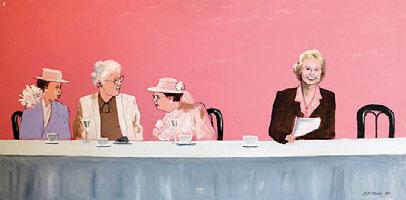












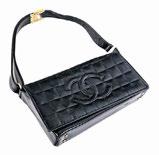













Fabulous Firearms Collection, Antiques, Swords, Military, Toys, Automotive & Firearms Library, Art & Much More at The Langdell Homestead Barn ~ 697 Isaac Frye Highway Wilton, N. H. (Isaac Frye Highway is North off Route 101 opposite Brookside Gas Station)
We are pleased to offer a fabulous collection of 90+ antique and modern firearms, from a lifelong collector, including rifles, revolvers, pistols, and ammunition with many Winchesters, Marlins, Colts & more. Additional items of interest include a collection of Toy Guns (Hubley, Mattel, Nichols etc.); Powder Horns; Civil War and other Swords; Military items; Oil and Watercolor Paintings; two automotive prints by M. Gamy; Large Folio C&Is; Swayne Robinson & Co 15” bell; Regina and other Music Boxes; Children’s Guitars & Banjo; Ukuleles; Bronze & Iron statues; Pipes & Tobacco Jars; extensive collection of Automotive and Firearms books & magazines; Costume Jewelry & much more! Come join us for a fun-filled auction!
Arrangements are being made with a local licensed federal firearms dealer for required background checks and transfers. Cost of transfers to be borne by the buyers. For additional information, please see our ad and photos at AuctionZip.com ID# 26648










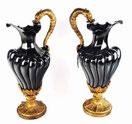























The period from 1850 to 1950 was characterized by significant change and disruption, encompassing major historical events and artistic movements. This era saw the rise of the Industrial Revolution, Romanticism, and Realism, followed by movements such as Orientalism, Impressionism, and the Arts and Crafts movement. The century also witnessed major conflicts, including the United States Civil War, the SpanishAmerican War, and both World Wars. Key artistic and cultural shifts included the Gilded Age, the Russian Revolution, the Jazz Age, Art Nouveau, the Vienna Secession, Futurism, and Modernism, among others.
This sale offers Everything from Antique crystal balls to fine estate jewelry, Galle Glass Lamps and Signed furniture, Cameo Glass, French and American Art Glass, Art Pottery, Rookwod, Sevres, Art Nouveau including Signed Tiffany Leaded Lamps, French Art Nouveau, Vienna Secession and Art Deco Furniture and Lighting, Signed Bentwood, Josef Hoffmann, Peter Behrens Desk, Signed Galle inlaid furniture, Silver including Art Nouveau Flatware and Tea sets, Tiffany and Co, Gorham, Jensen
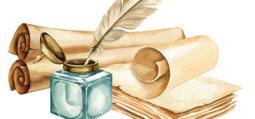
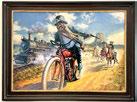







and others, Meiji Japanese and other Asian works of art, Clocks and more clocks, Swingers, French clocks, American clocks and watches Over 100 American and European Paintings, plus watercolors and drawings including a collection of Archipenko sketches,: An important Royal Yacht painting by Arthur Wellington Fowles, Louis Icart drawings, Wilhelm Giessel, Max Rabes, Emilio Grau Sala , Erte Watercolor, Jean Dupas pen and Ink. Peggy Dodds, William Lester Stevens, Reginald Marsh Vaudeville drawing with W.C.Fields performing, Colin Campbell Cooper, Carrier-Belleuse, Dietz Edzard, Carl Nys, Julius Maurer, Reinhard, Jean mater Pilgrim, Roxana Gabi, Fortunato Fontana, Camillo Innocenti. Albert Gosselin, Rolph Scarlett, Abraham Walkowitz, Hans Temple, Charles Van Roos, Arthur Beecher Carles and more Buyer’s Premium: 30% Online (Live Auctioneers, Invaluable), 25% Absentee bids left directly with Collective Hudson















